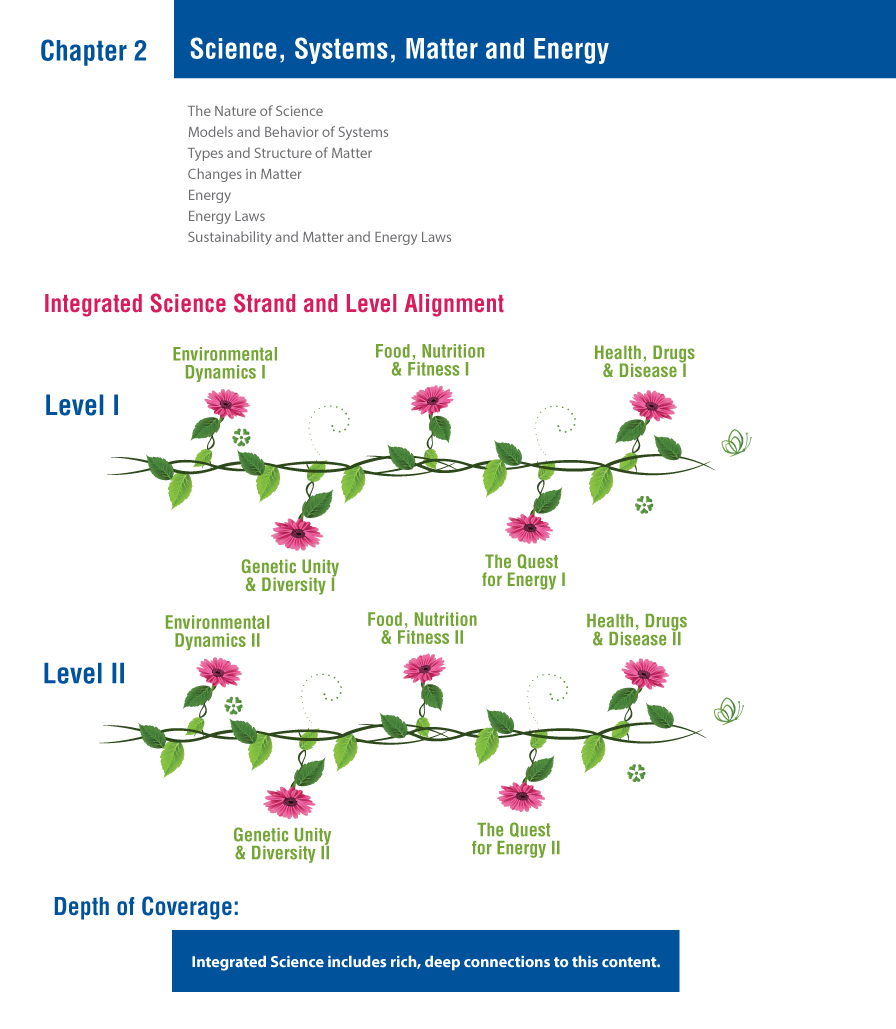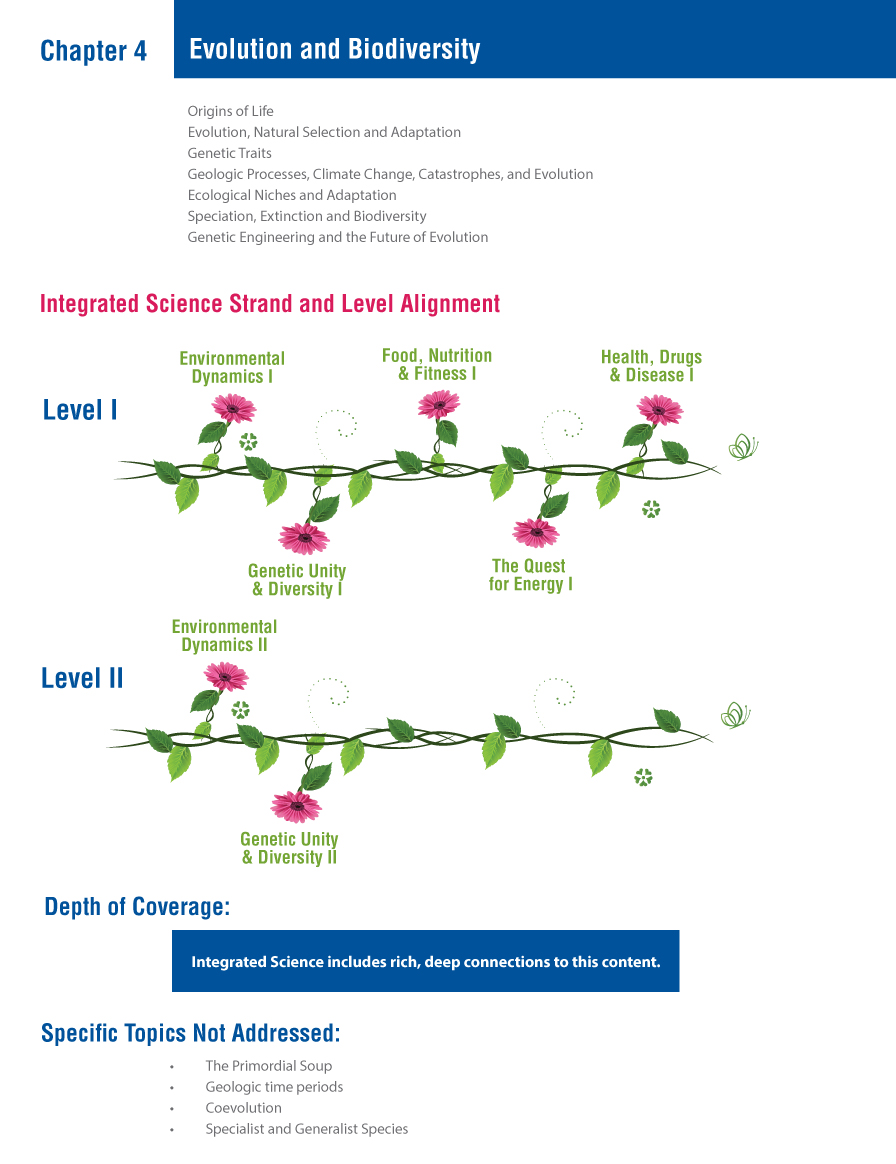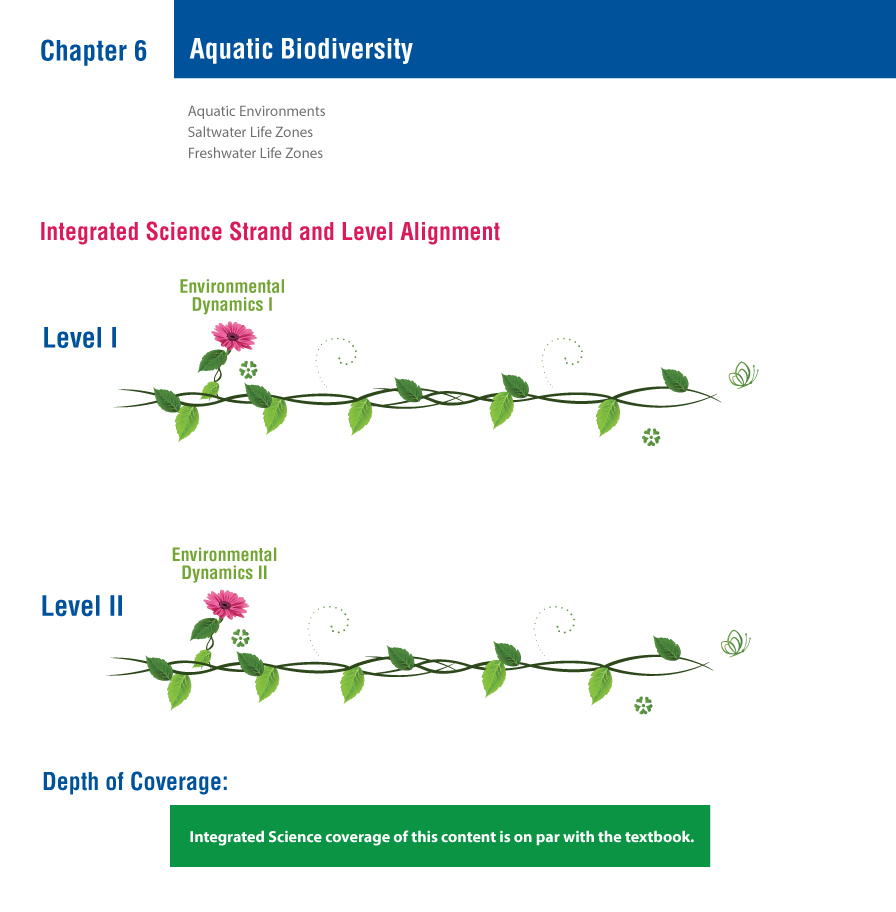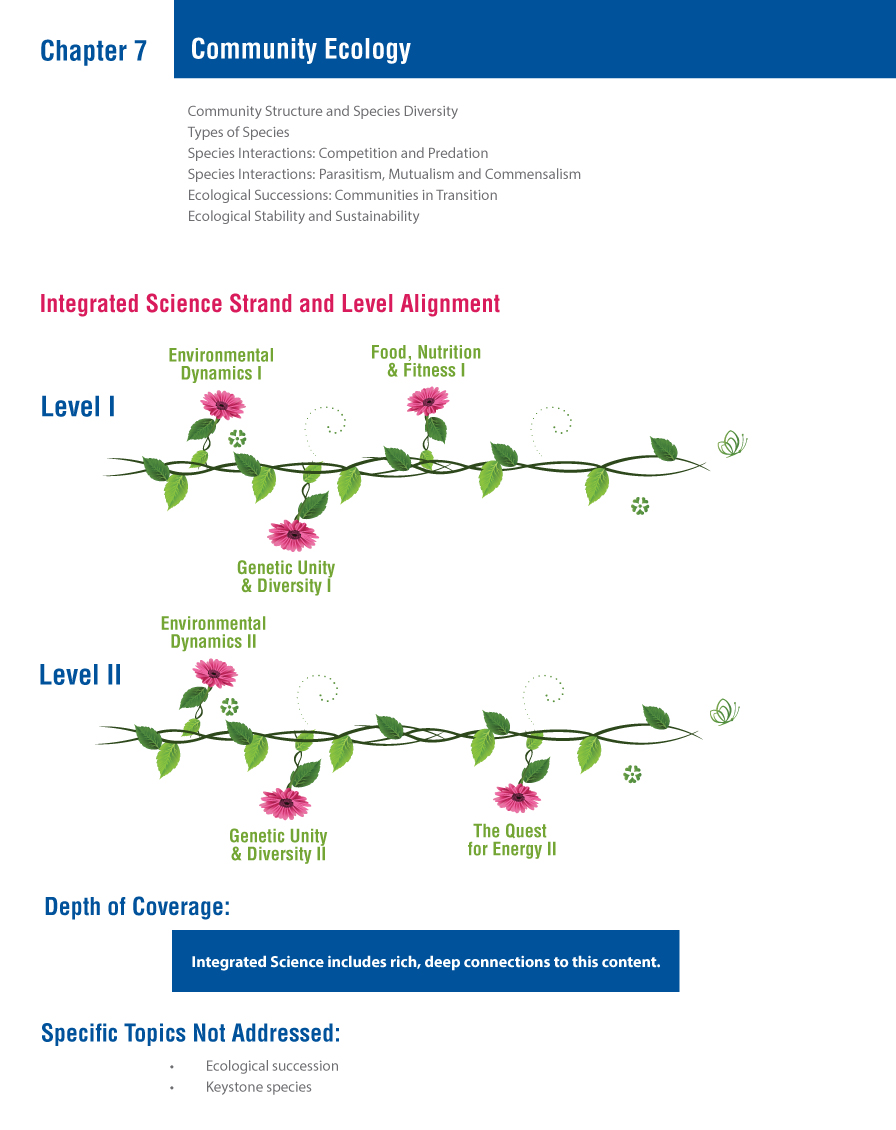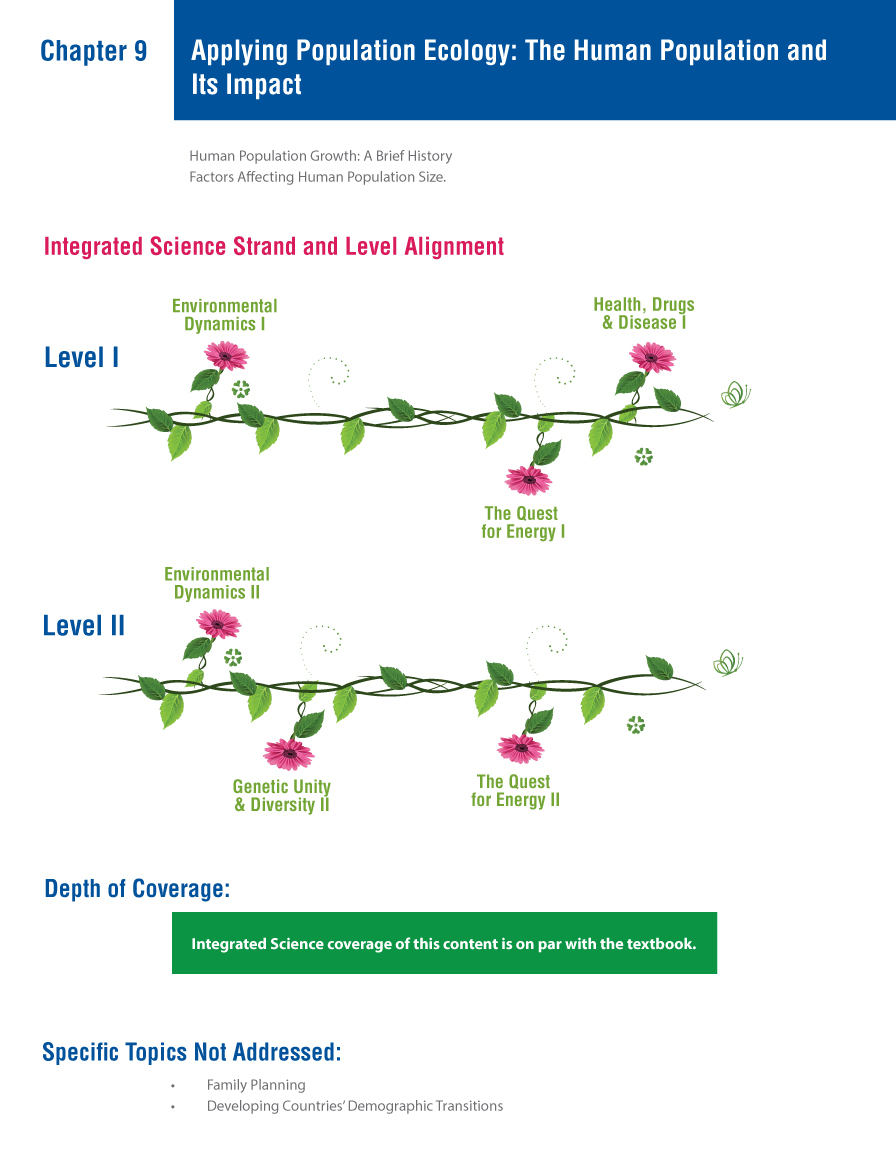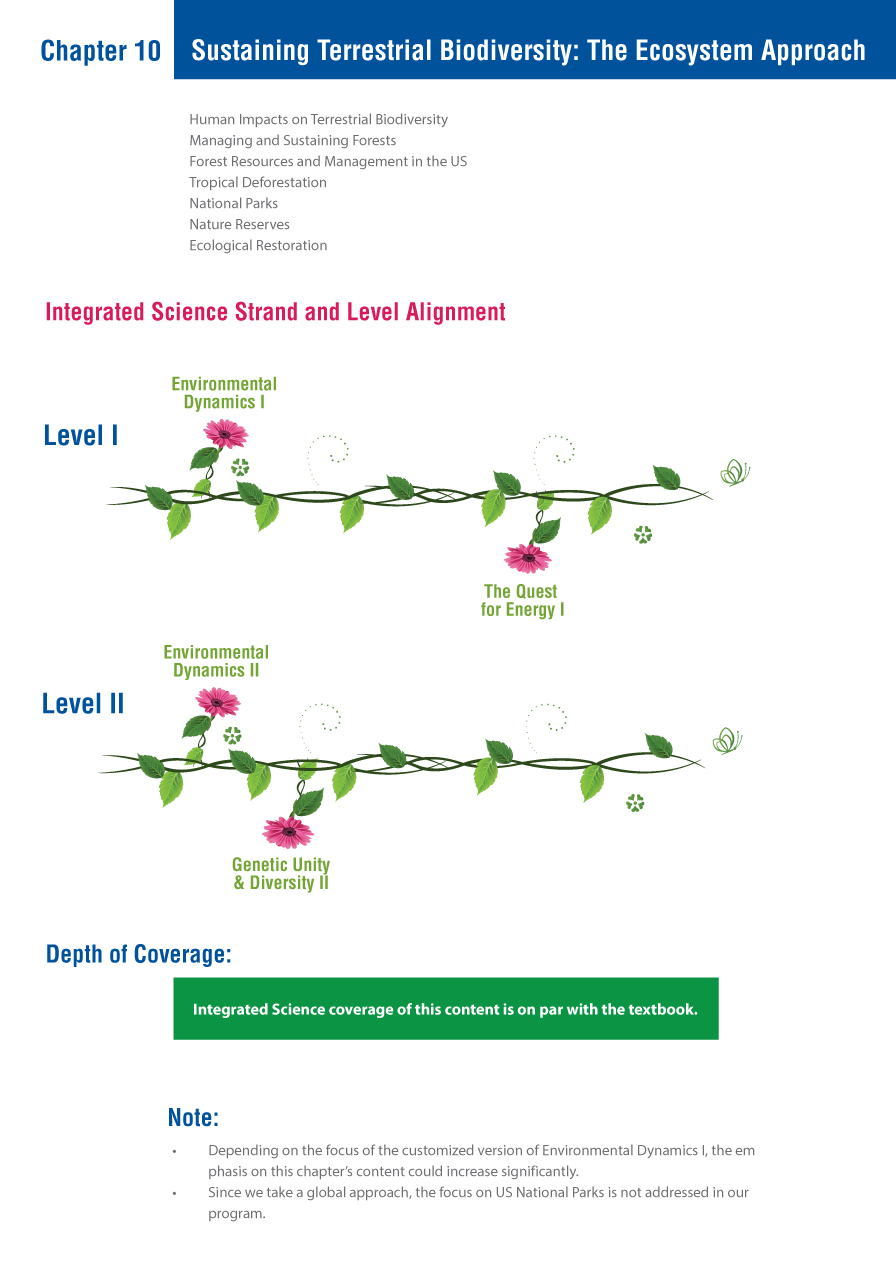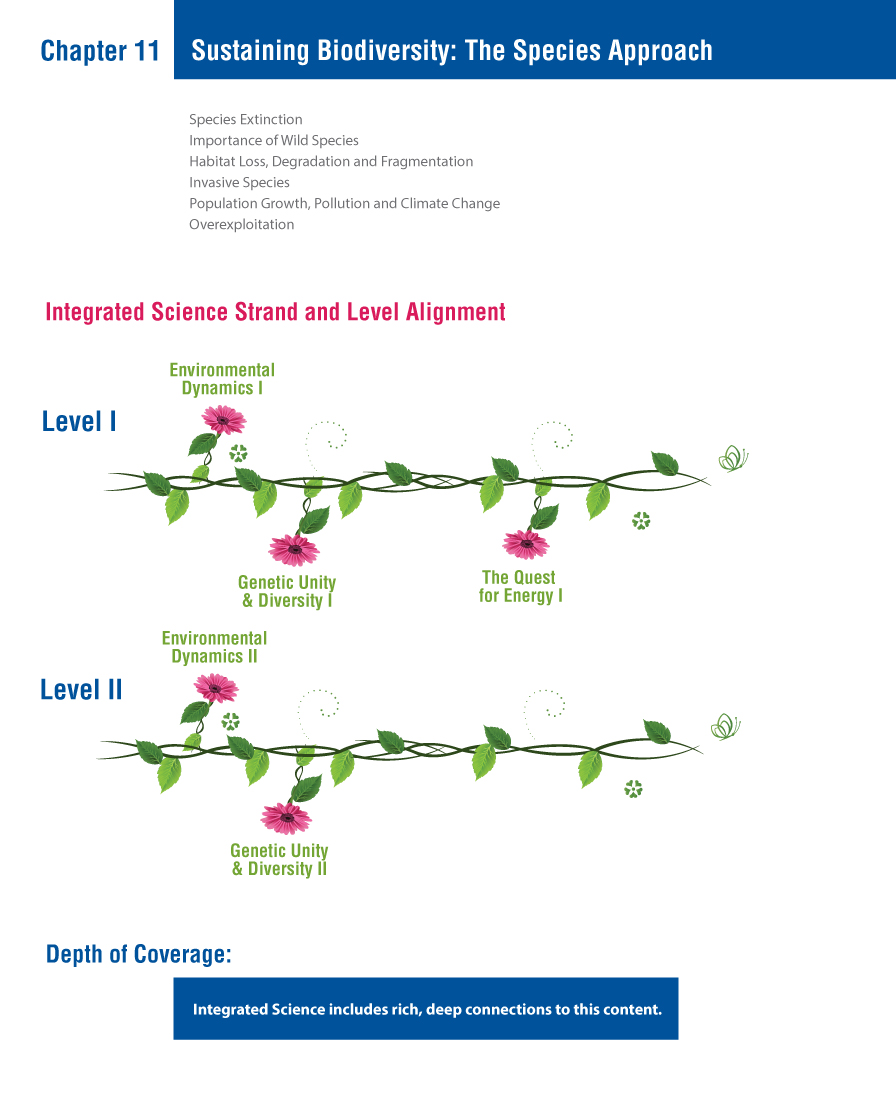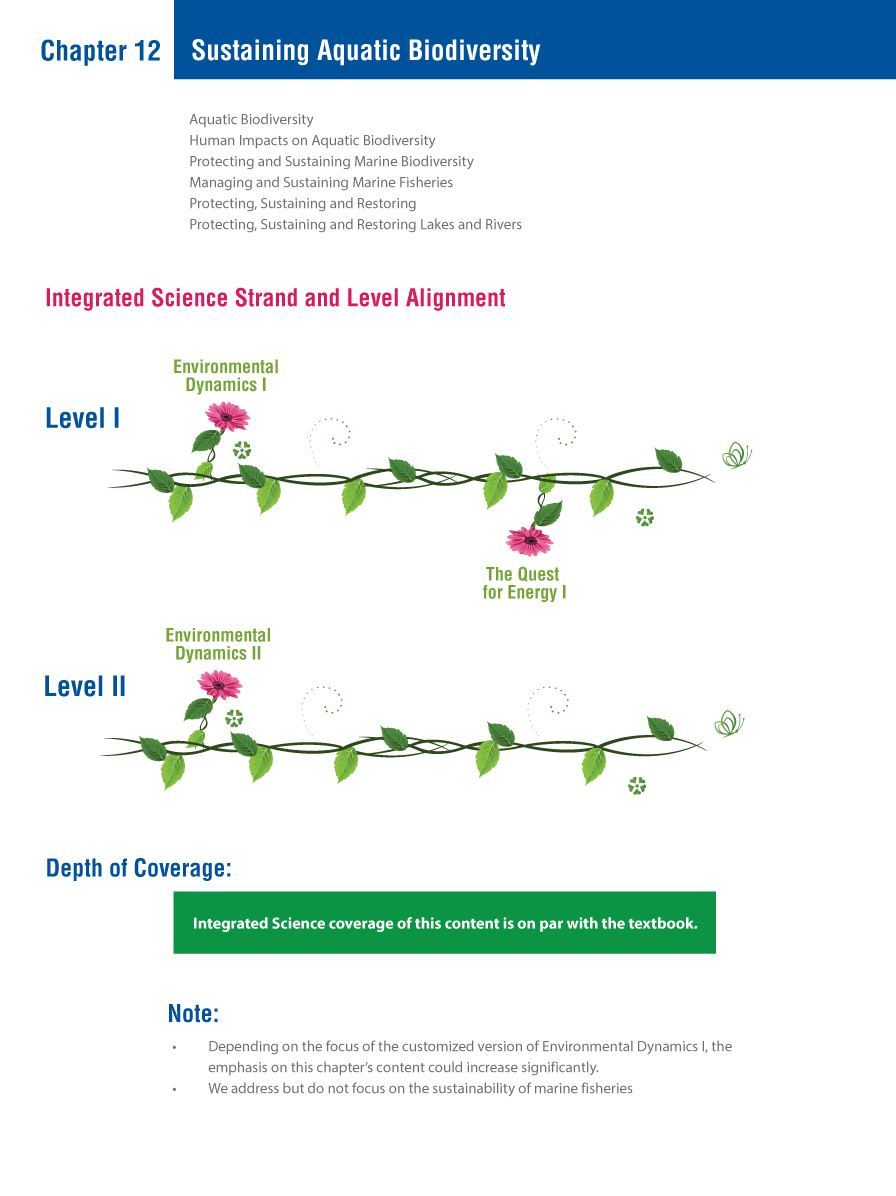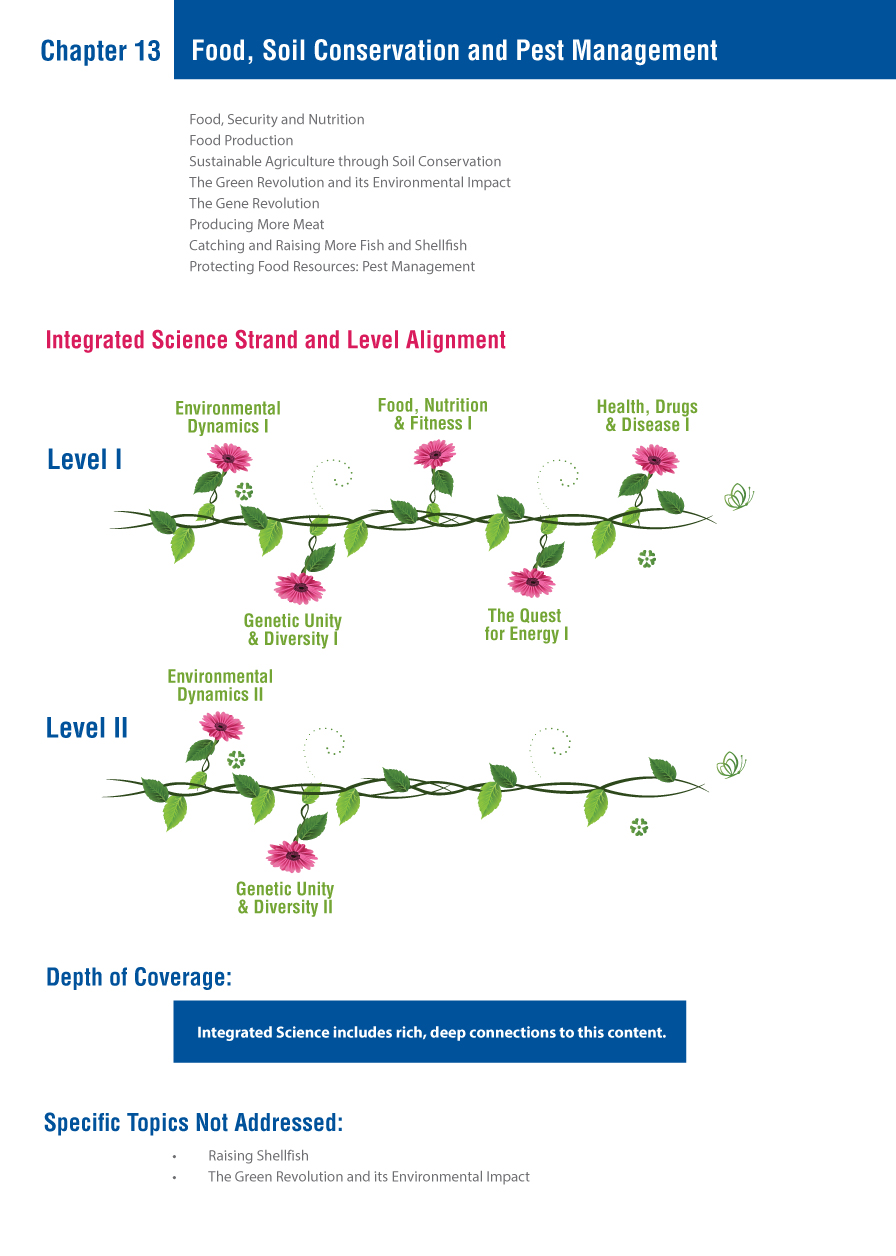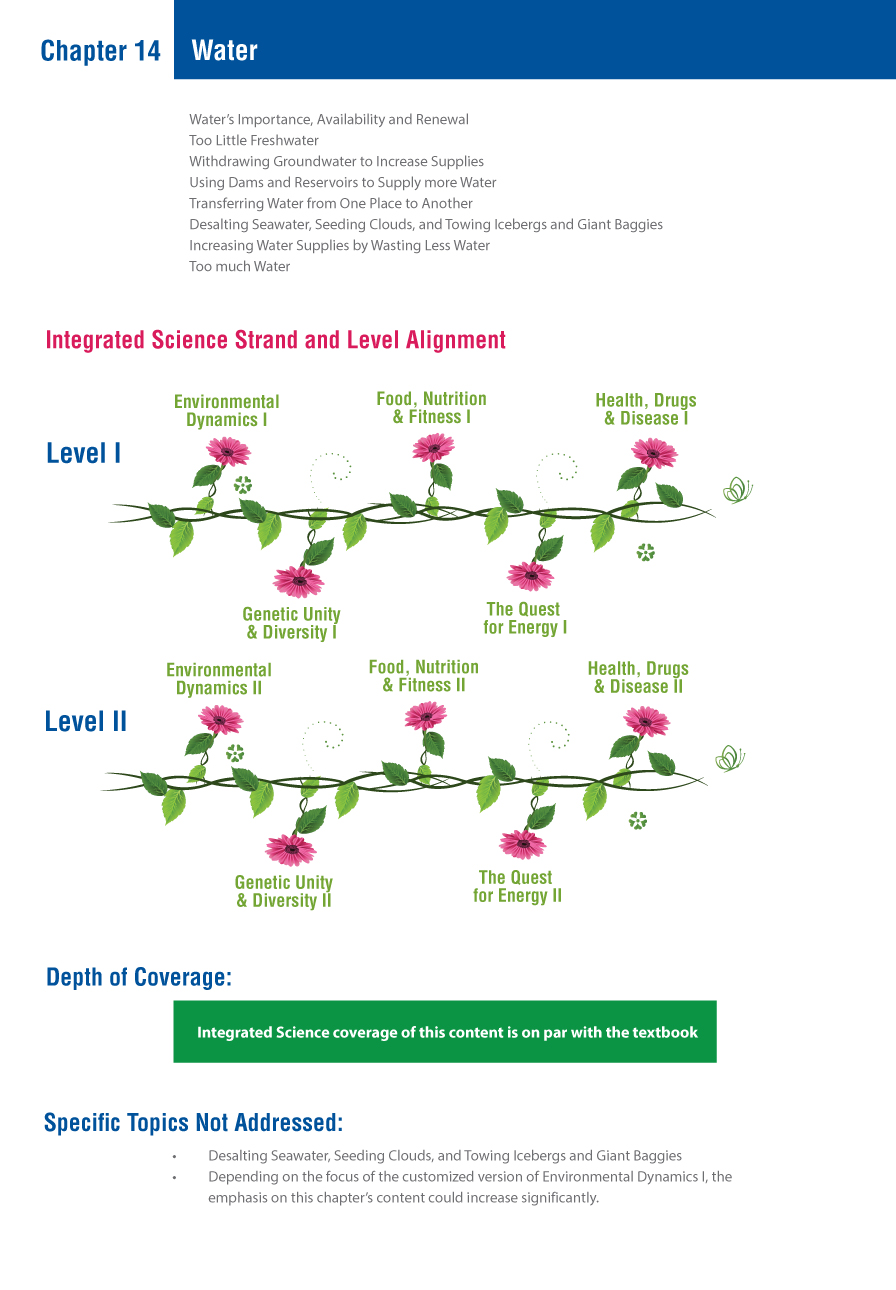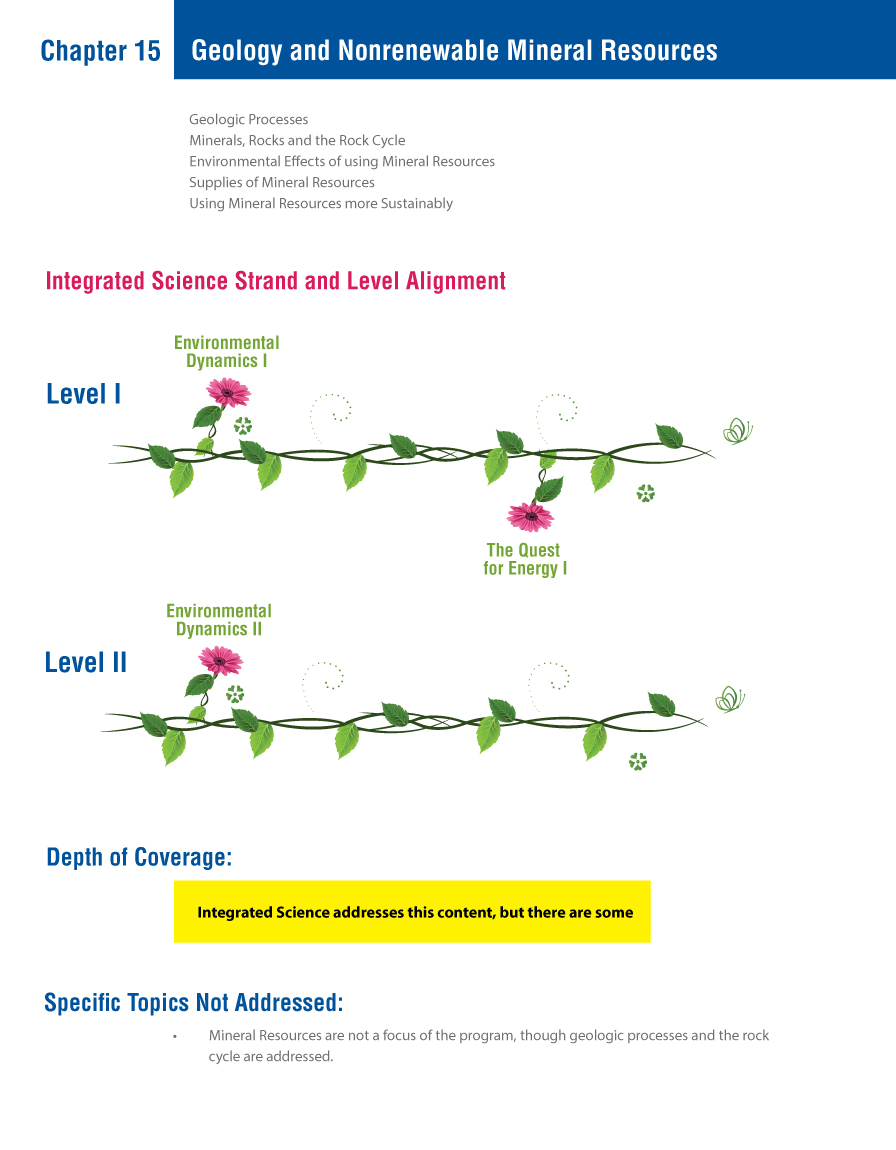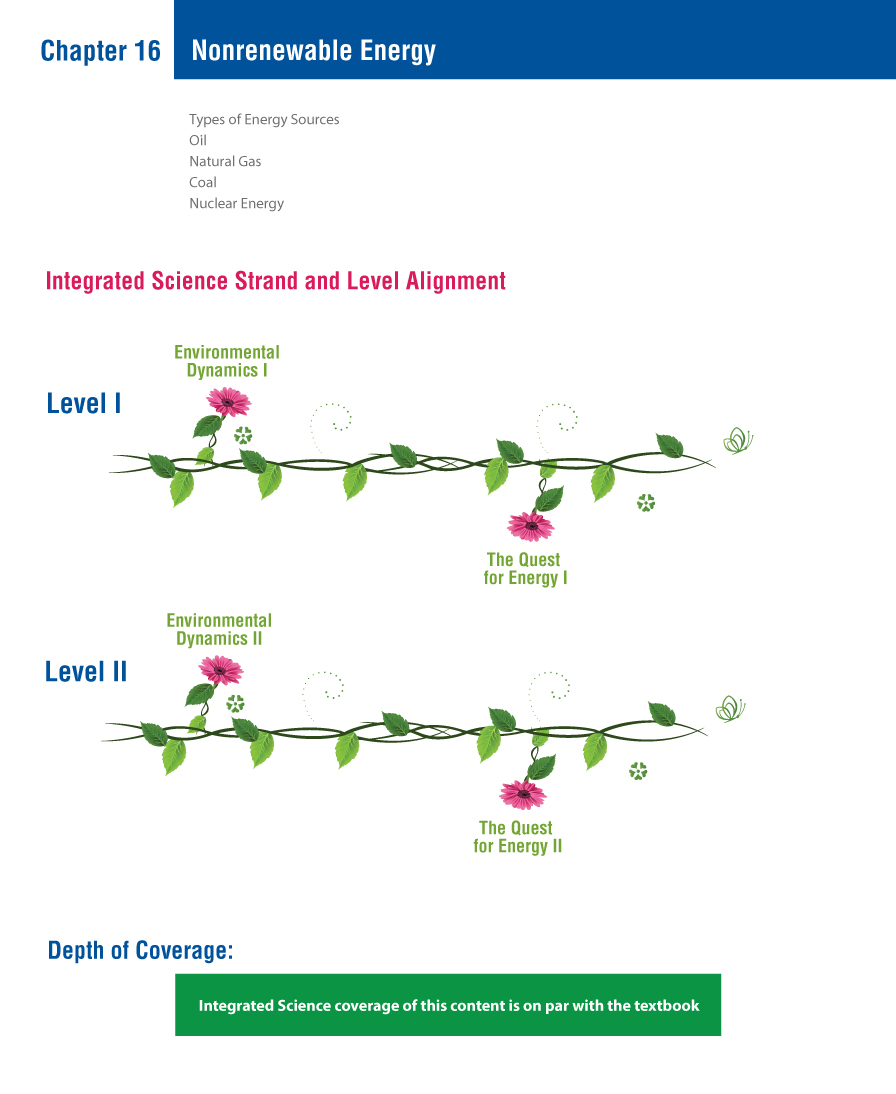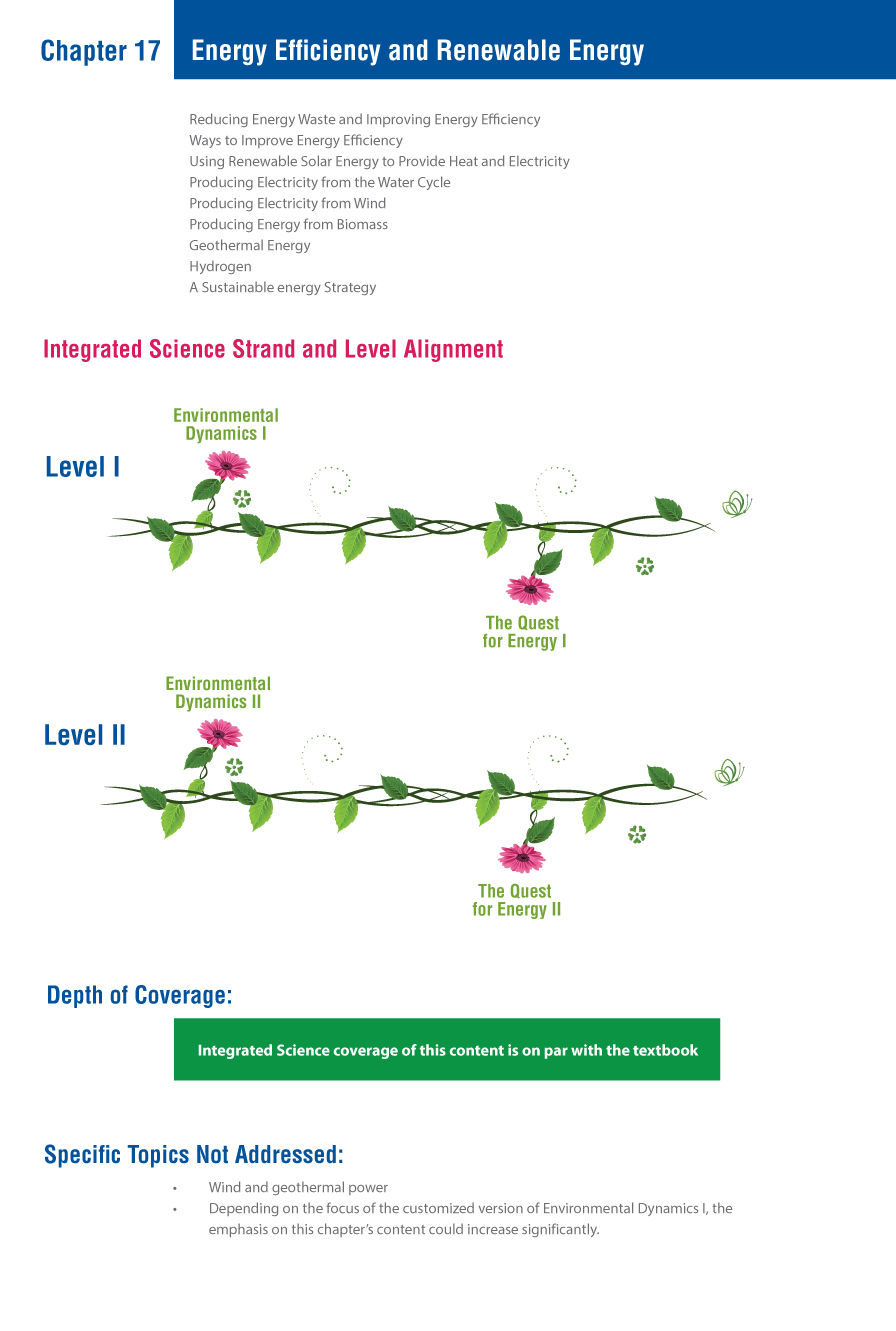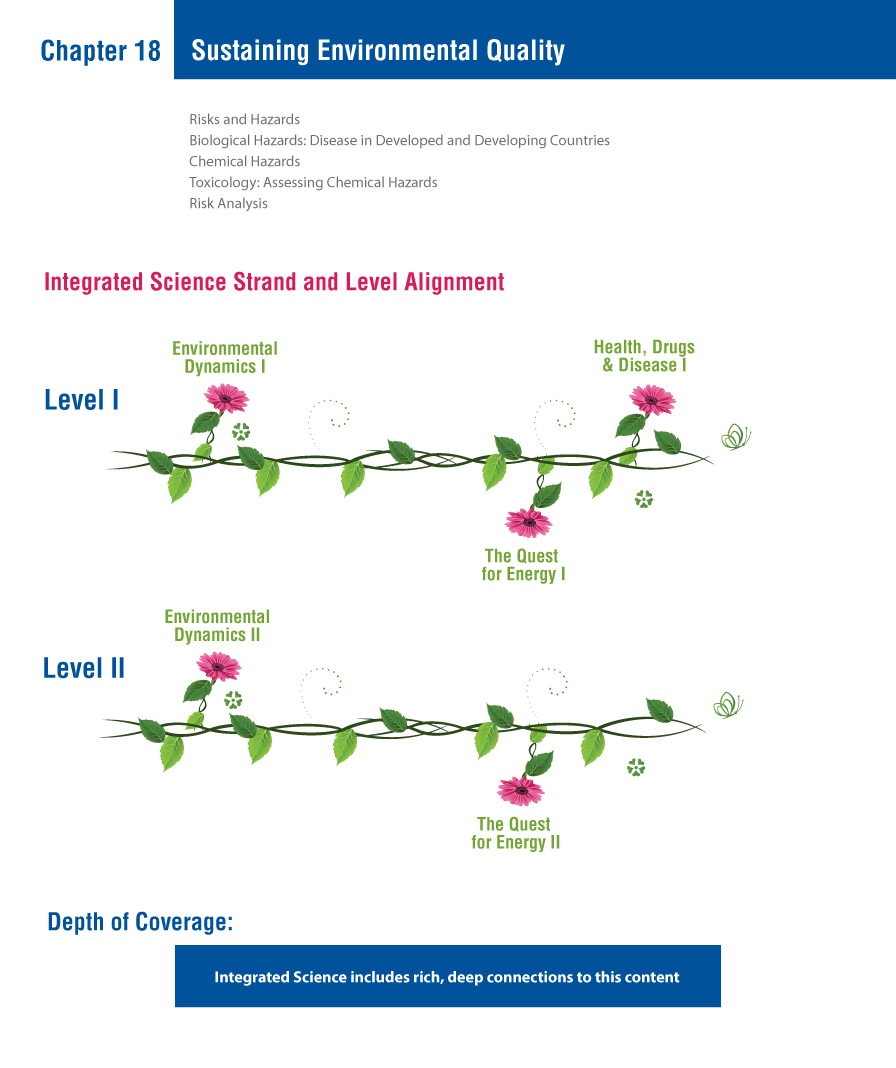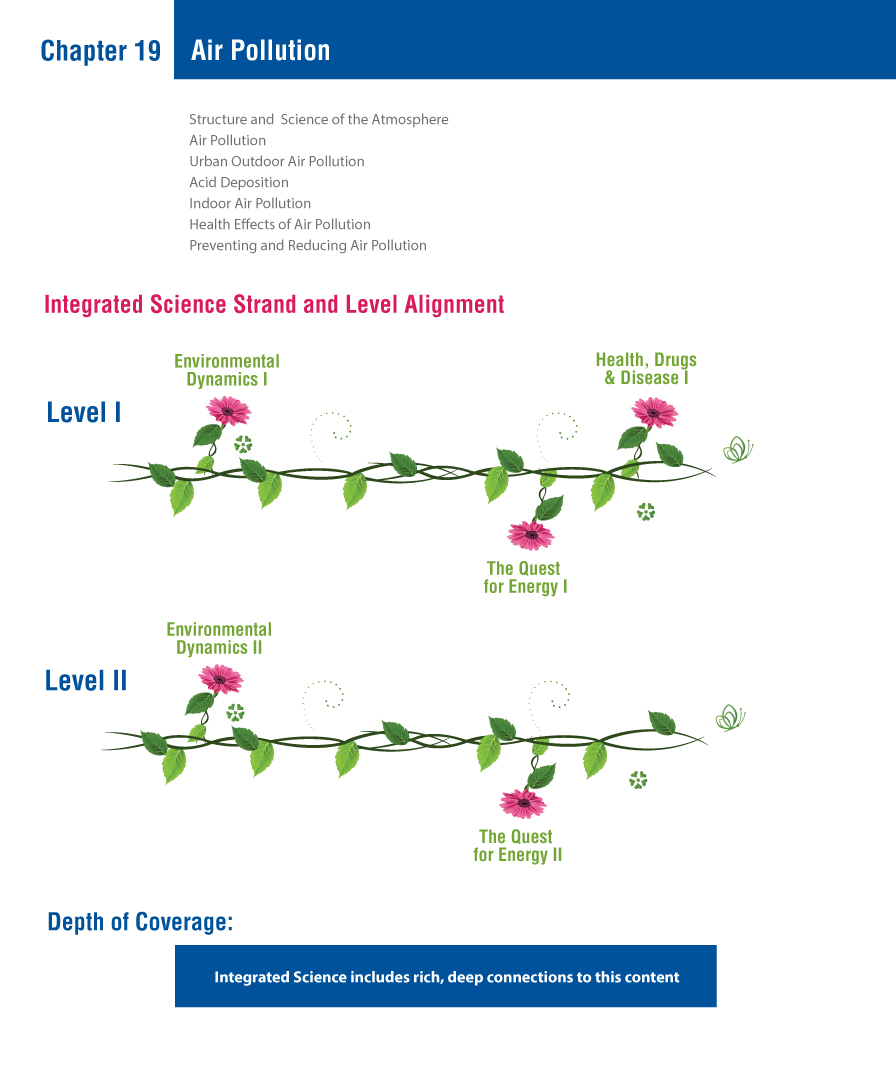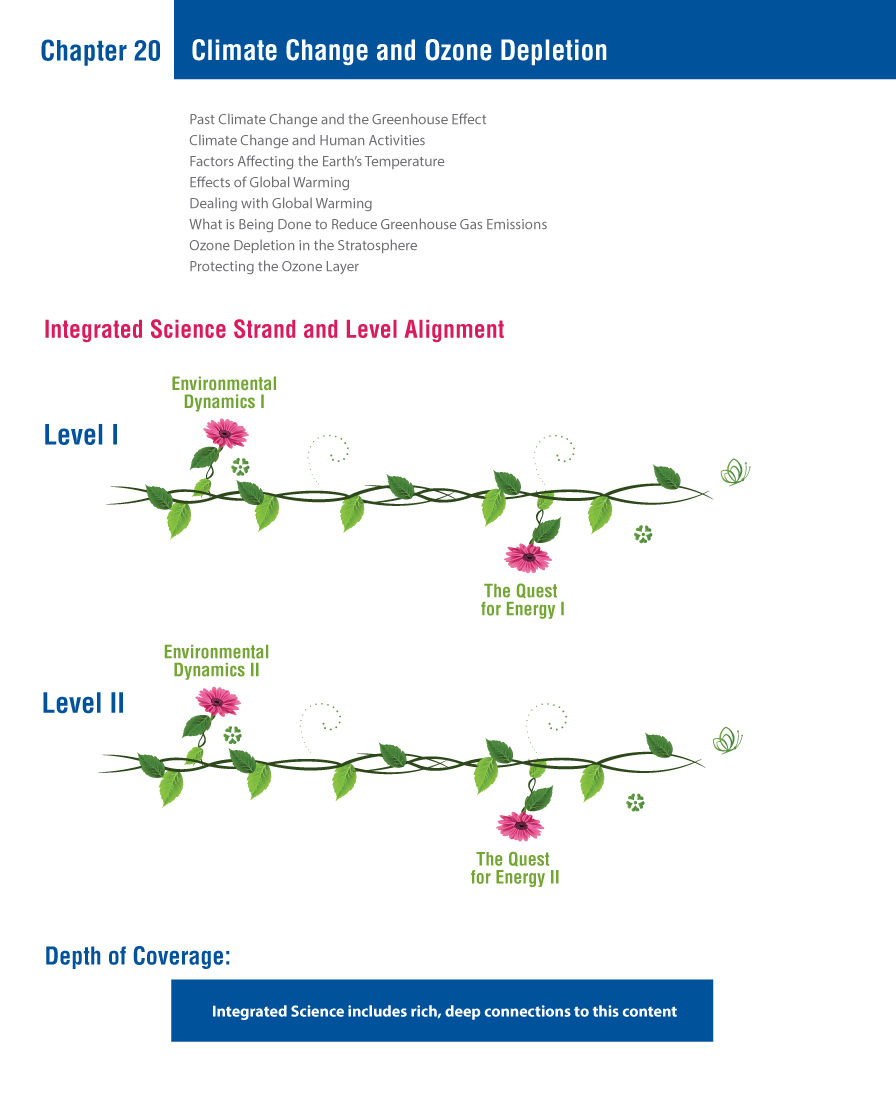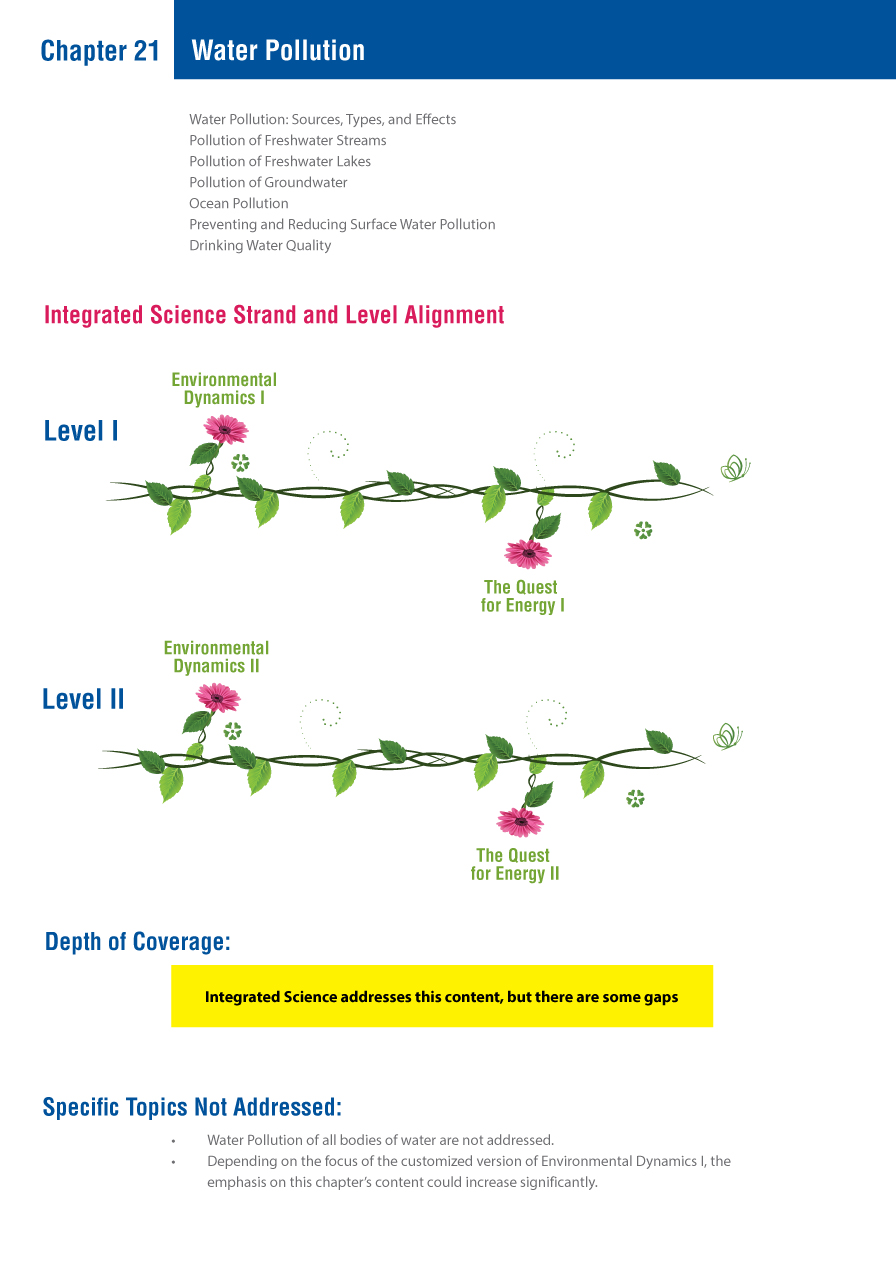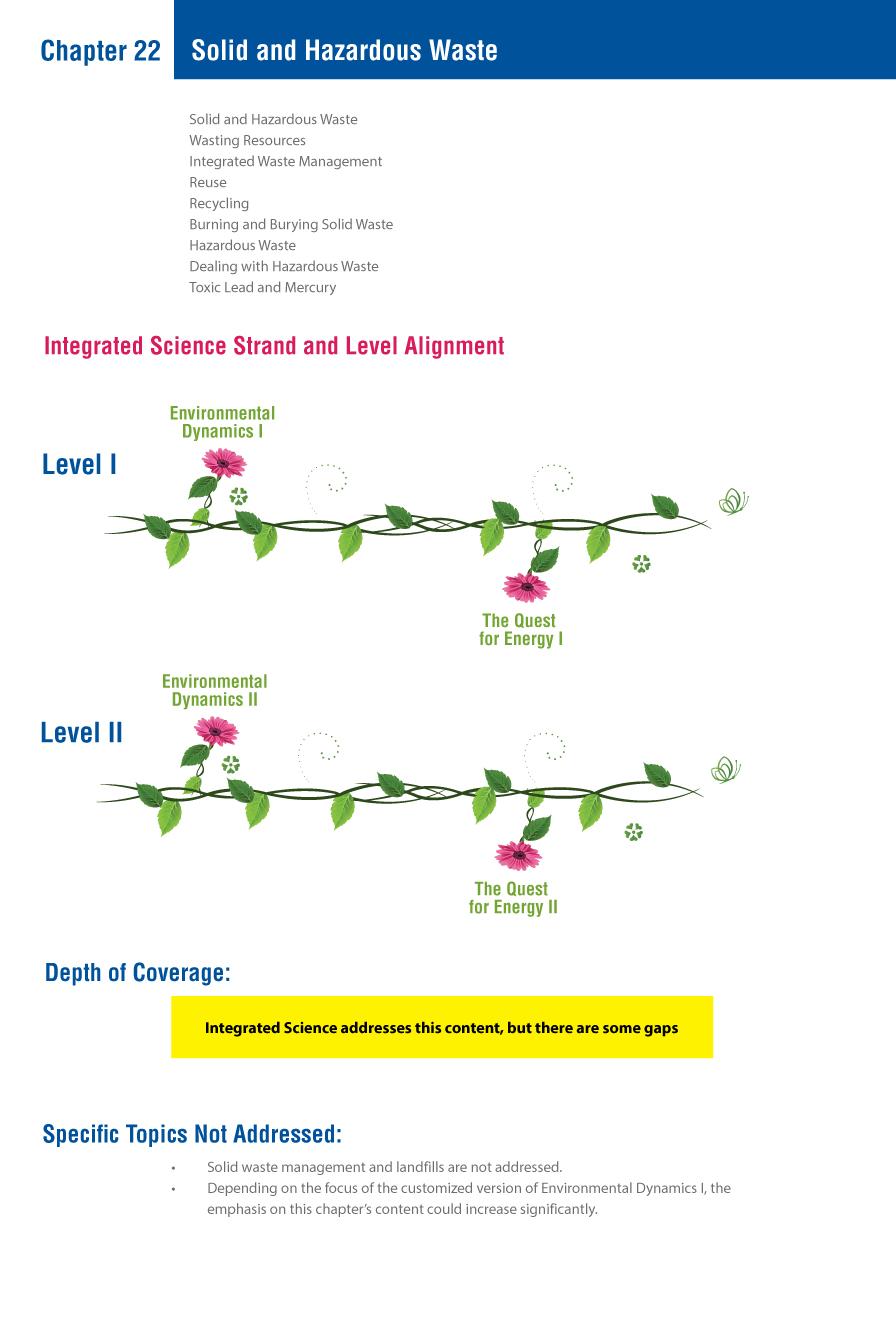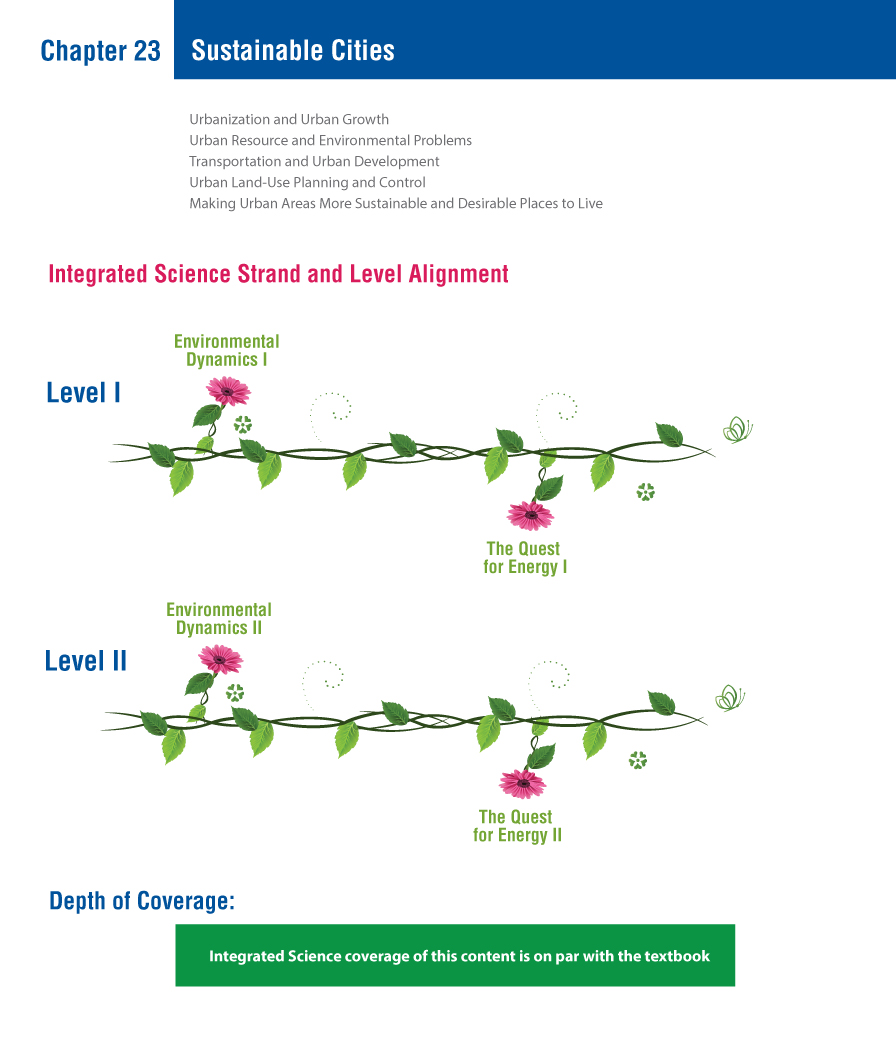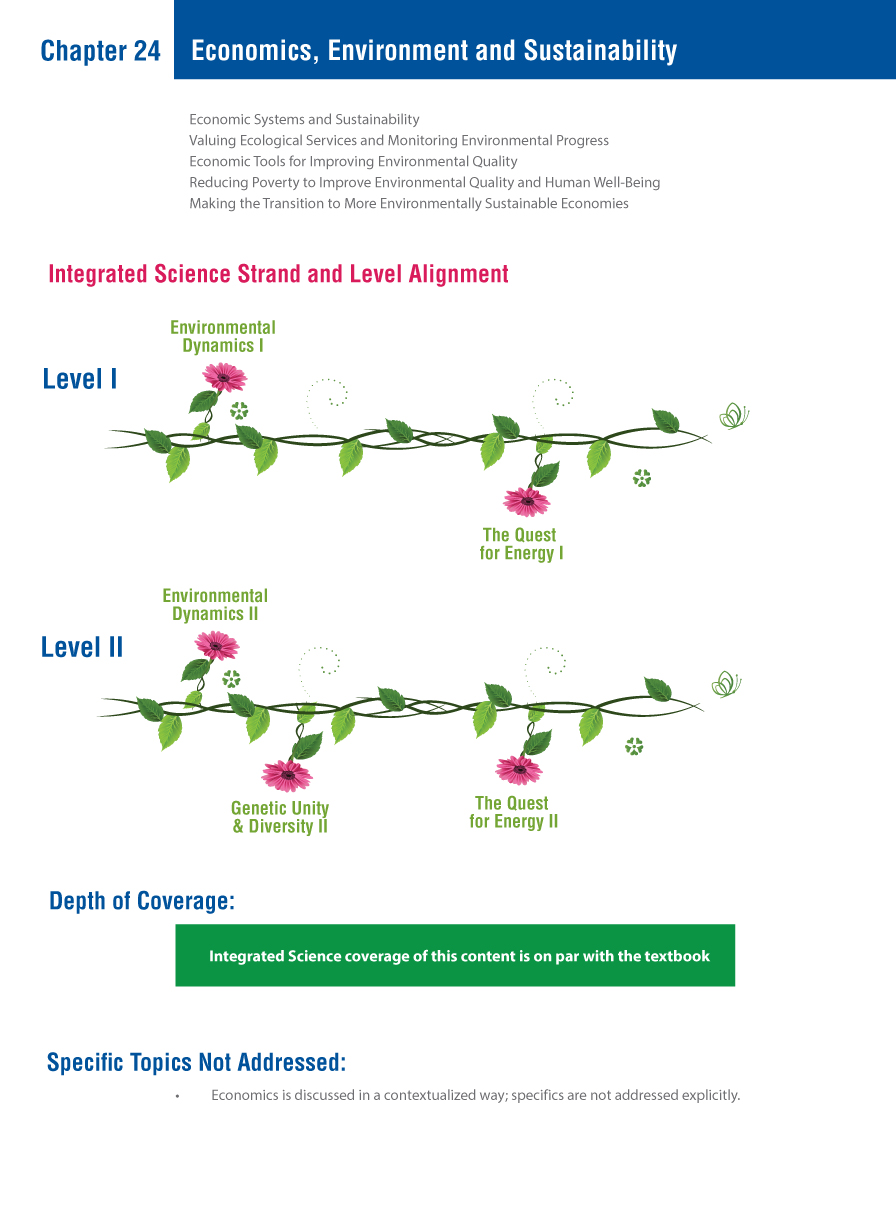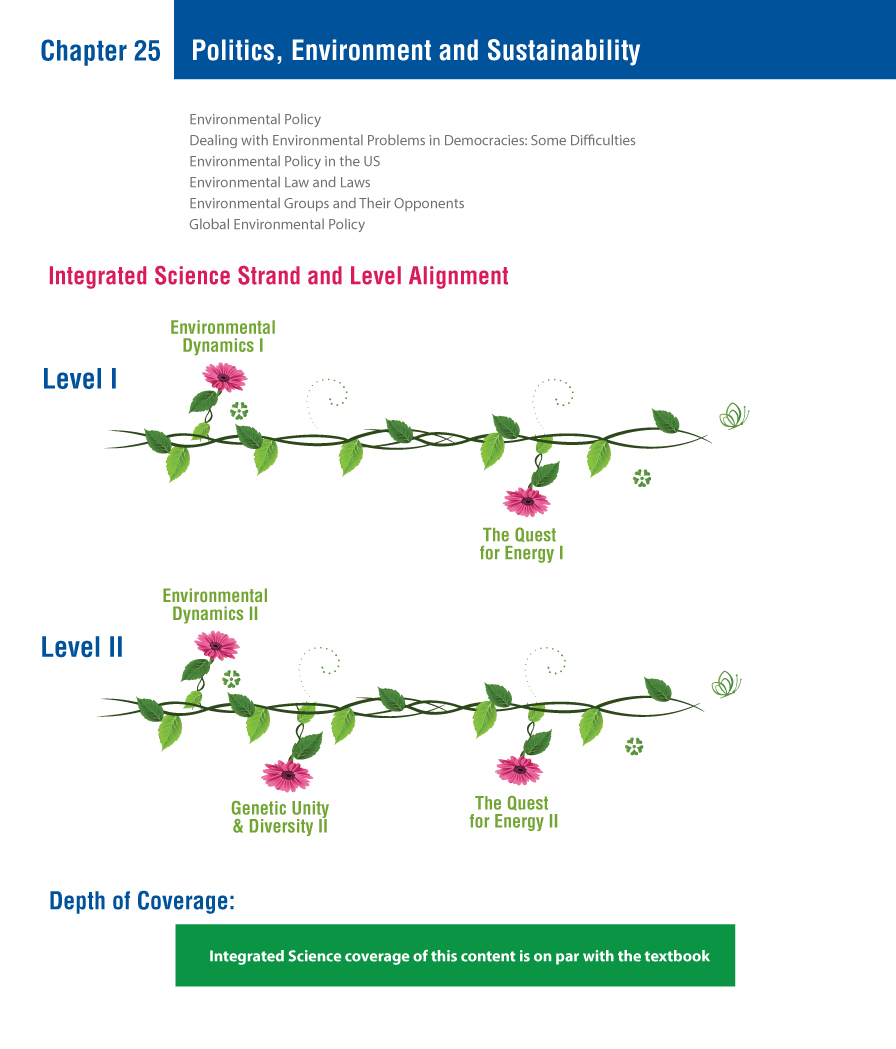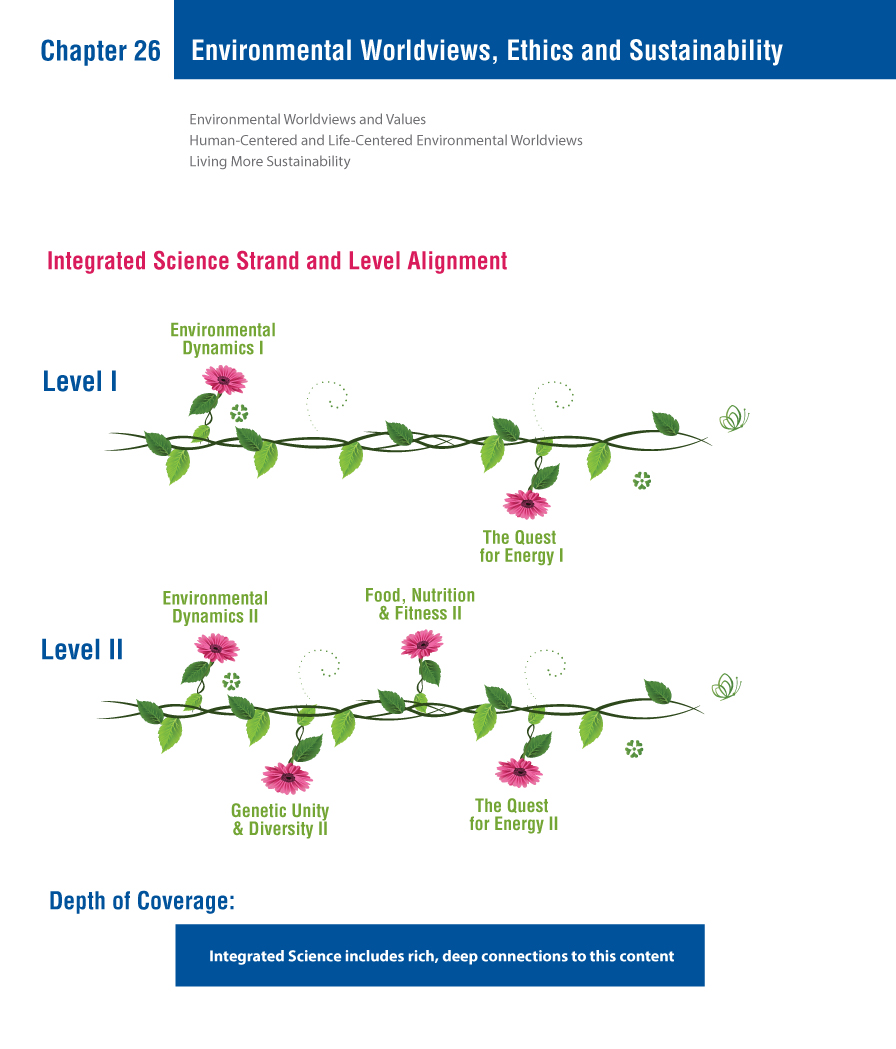INTERLEAVING: Because Learning Loves Layers
The EduChange program’s meticulously scaffolded design seamlessly integrates reading, math and lab skills. Before it was up to the teachers to try to be aware of all these needs and to try to integrate them more or less on the fly. EduChange takes the pressure off of my planning and I feel confident the students are being exposed to the proper skills in a meaningful manner.
We reorganized content in an integrated fashion to deepen conceptual understanding over time. For added depth, those permutations feed into our laboratory, disciplinary literacy, applied math, instructional & assessment systems to ensure students are building fortified knowledge networks.
Click a subject area below and then click on any corresponding textbook chapter. You will see a pop-up showing how Integrated Science iteratively revisits concepts that most courses only address once.
Our designs interleave concepts in new combinations and contexts, preventing student boredom that stems from two forms of repetition: rote memorization and rote re-teaching.
Biology I is open. For other subjects, scroll & click the arrows to open them
The following alignment is based on Holt Biology, a standard text for high school Biology classrooms.
Unit 1 Principles of Cell Biology
Chapter 4 Cells and Their Environment
Chapter 5 Photosynthesis and Cellular Respiration
Chapter 6 Chromosomes and Cell Reproduction
Unit 2 Principles of Genetics
Chapter 7 Meiosis and Sexual Reproduction
Chapter 9 DNA: The Genetic Material
Chapter 10 How Proteins Are Made
Unit 3 Exploring Evolution
Chapter 12 History of Life on Earth
Chapter 13 The Theory of Evolution
Chapter 14 Classification of Organisms
Unit 4 Principles of Ecology
Chapter 17 Biological Communities
Unit 5 Exploring Diversity
Chapter 19 Introduction to the Kingdoms of Life
Chapter 20 Viruses and Bacteria
Unit 6 Exploring Plants: Chapters 23 – 26
Unit 7 Exploring Invertebrates & Unit 8 Exploring Vertebrates: Chapters 27-36
Unit 9 Exploring Human Biology
Chapter 37 Introduction to Body Structure
Chapter 38 Circulatory and Respiratory Systems
Chapter 39 Digestive and Excretory Systems
Chapter 40 The Body’s Defenses
Chapter 42 Hormones and the Endocrine System
Chapter 43 Reproduction and Development

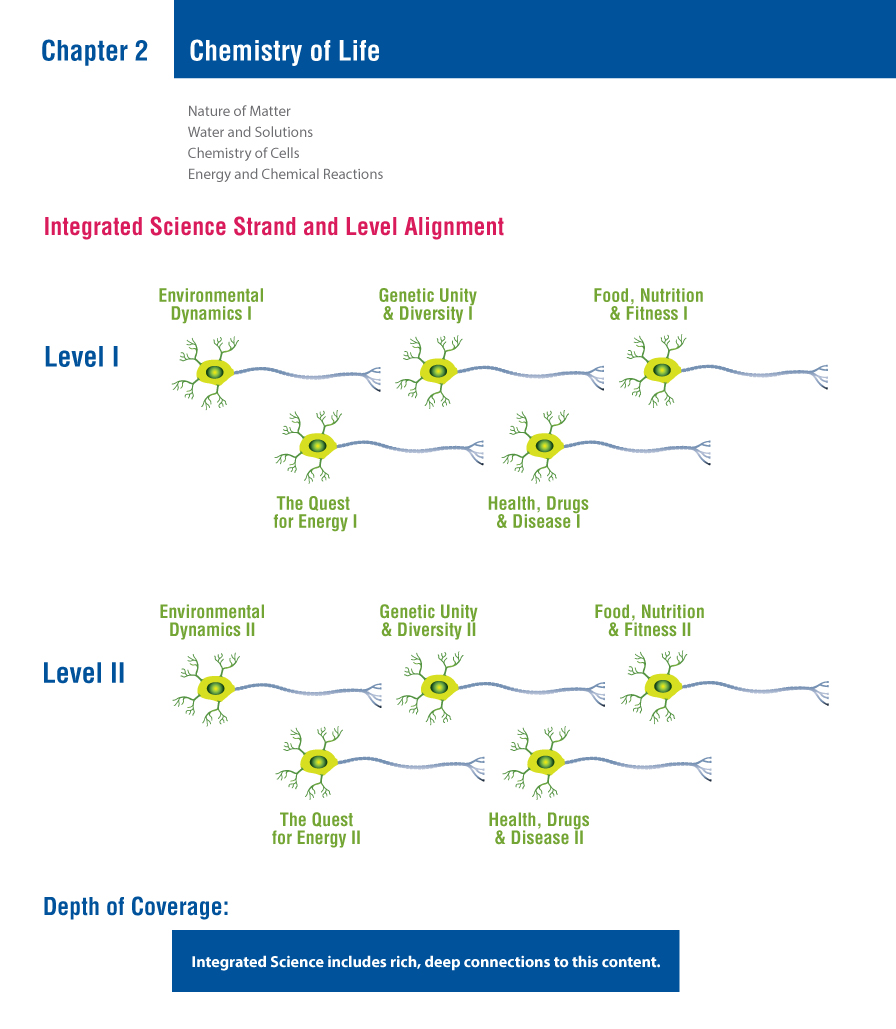

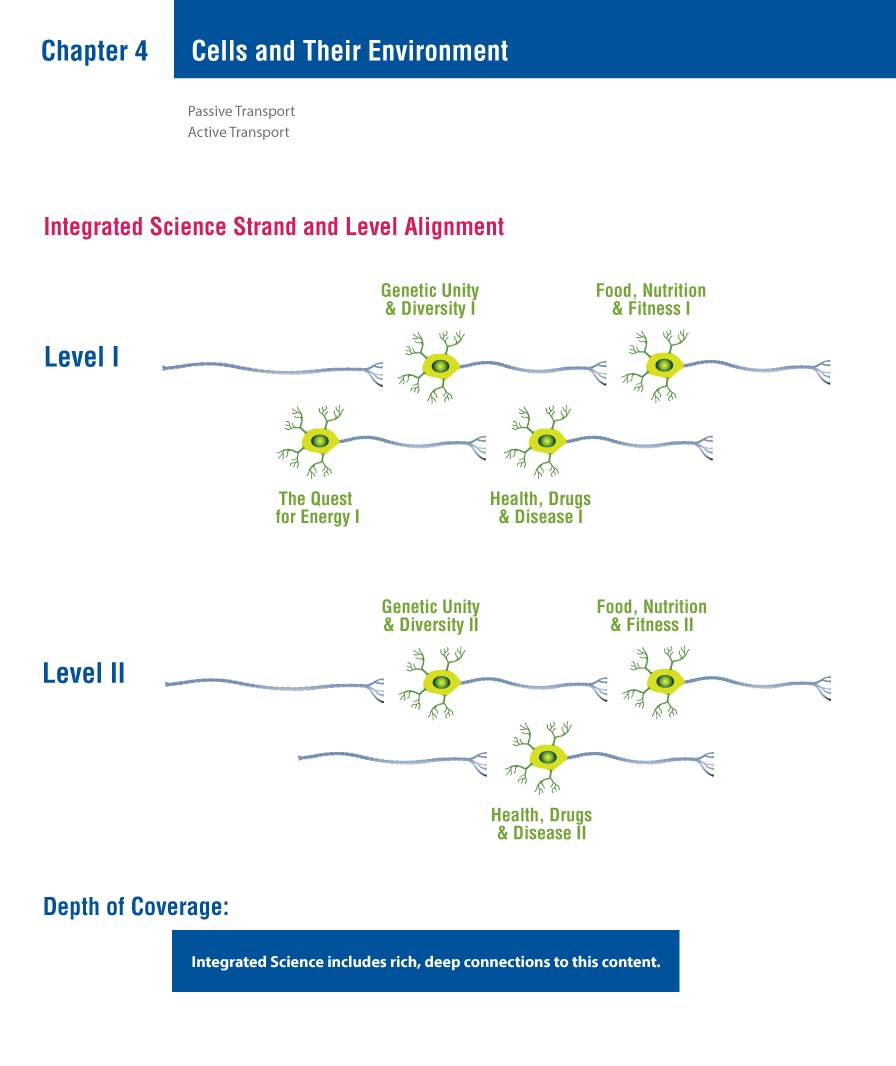
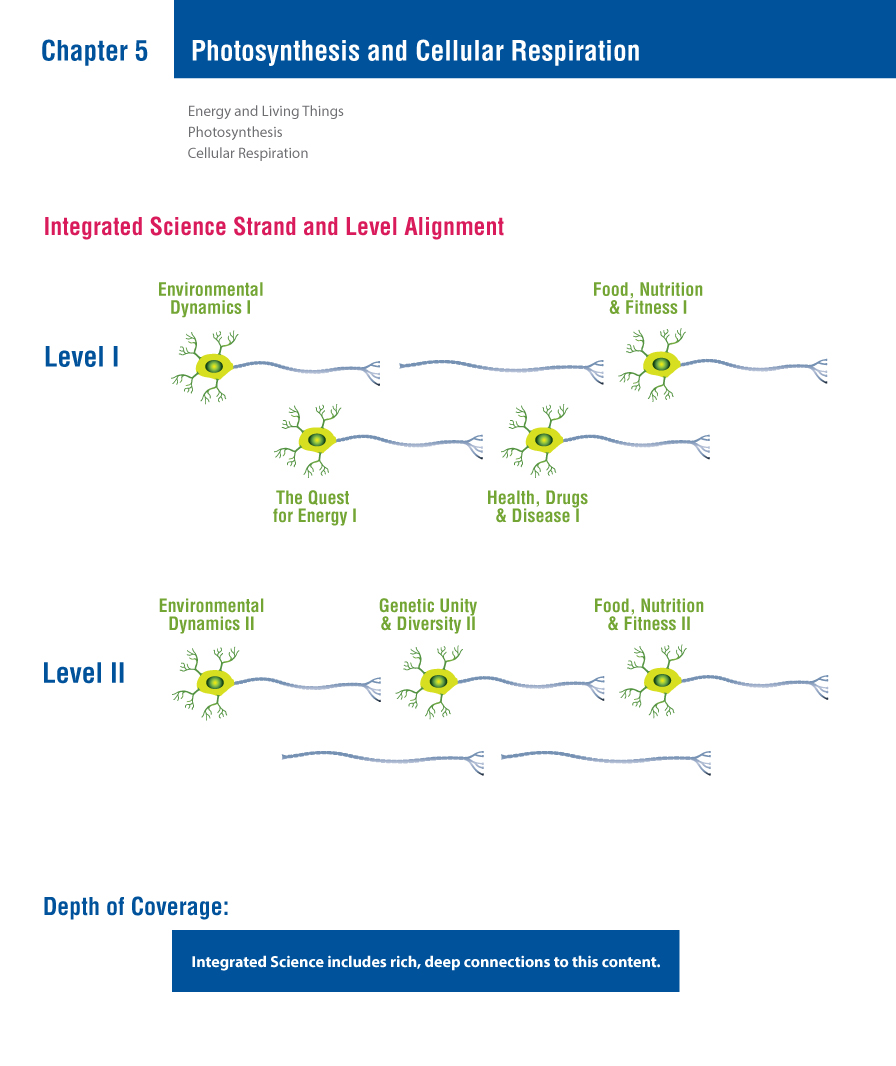
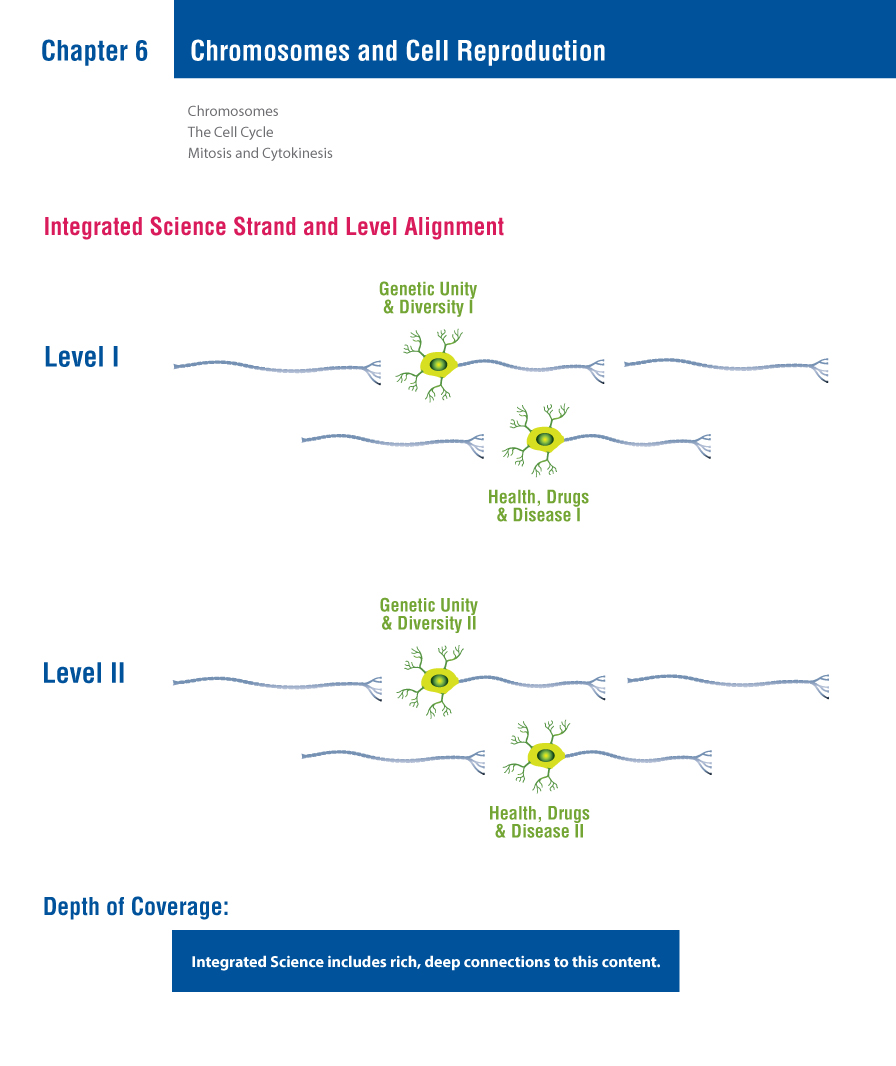
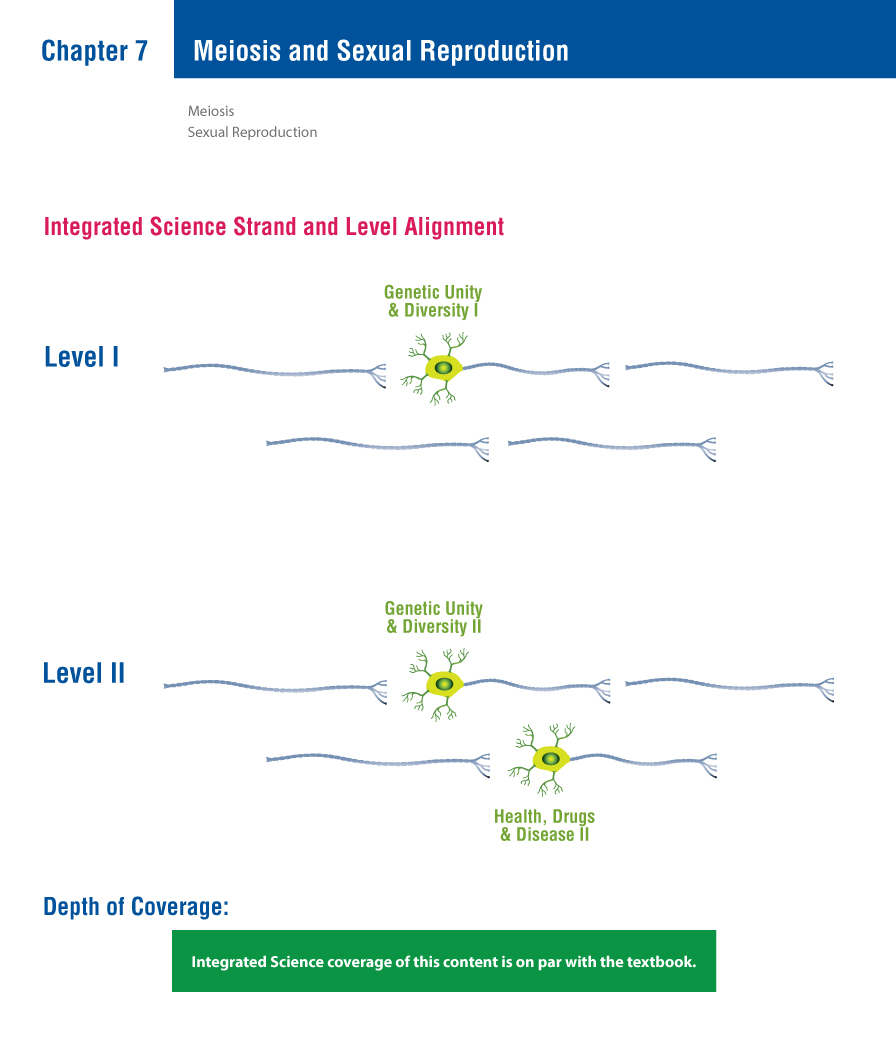
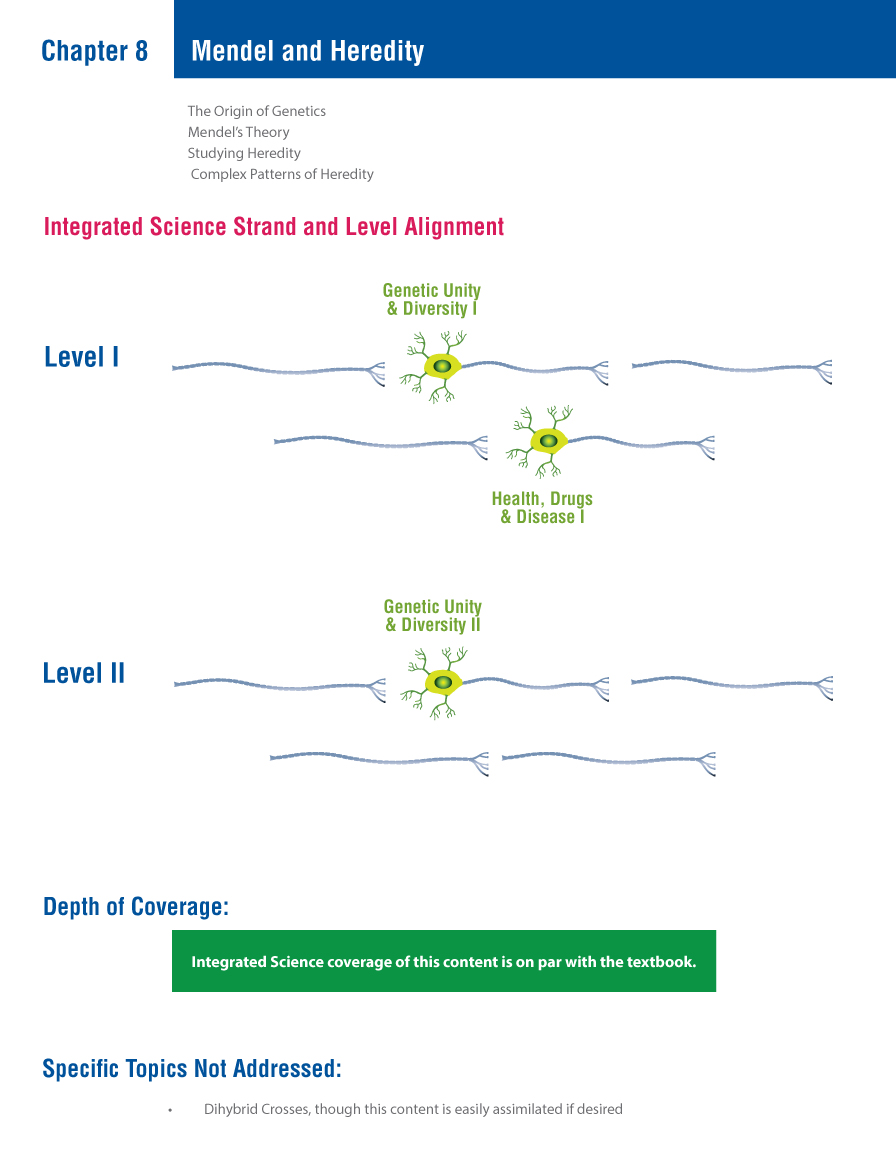
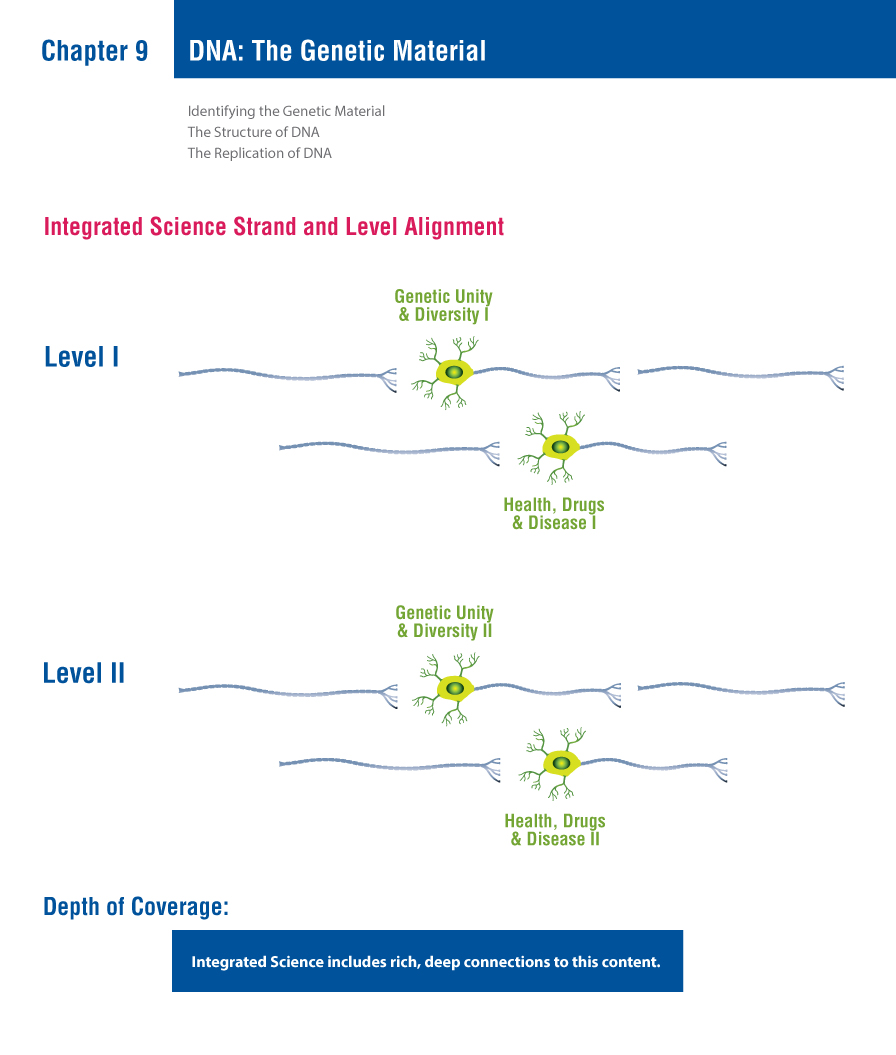
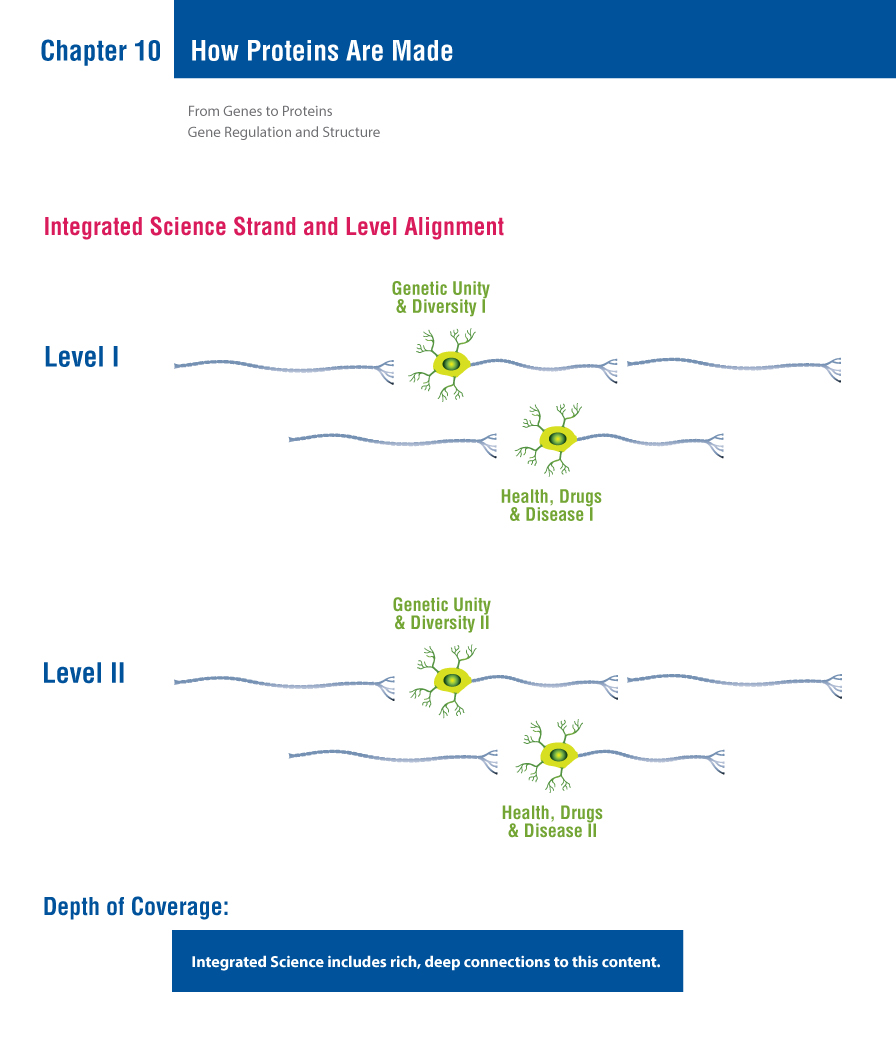
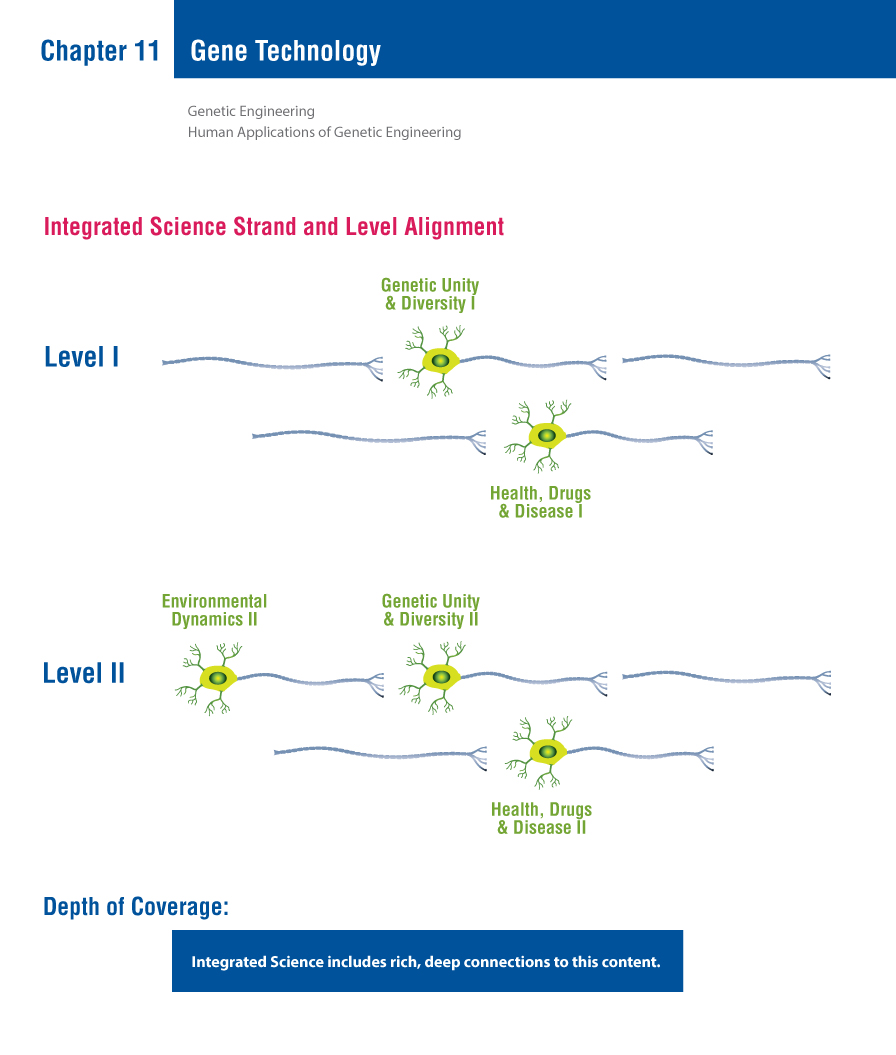

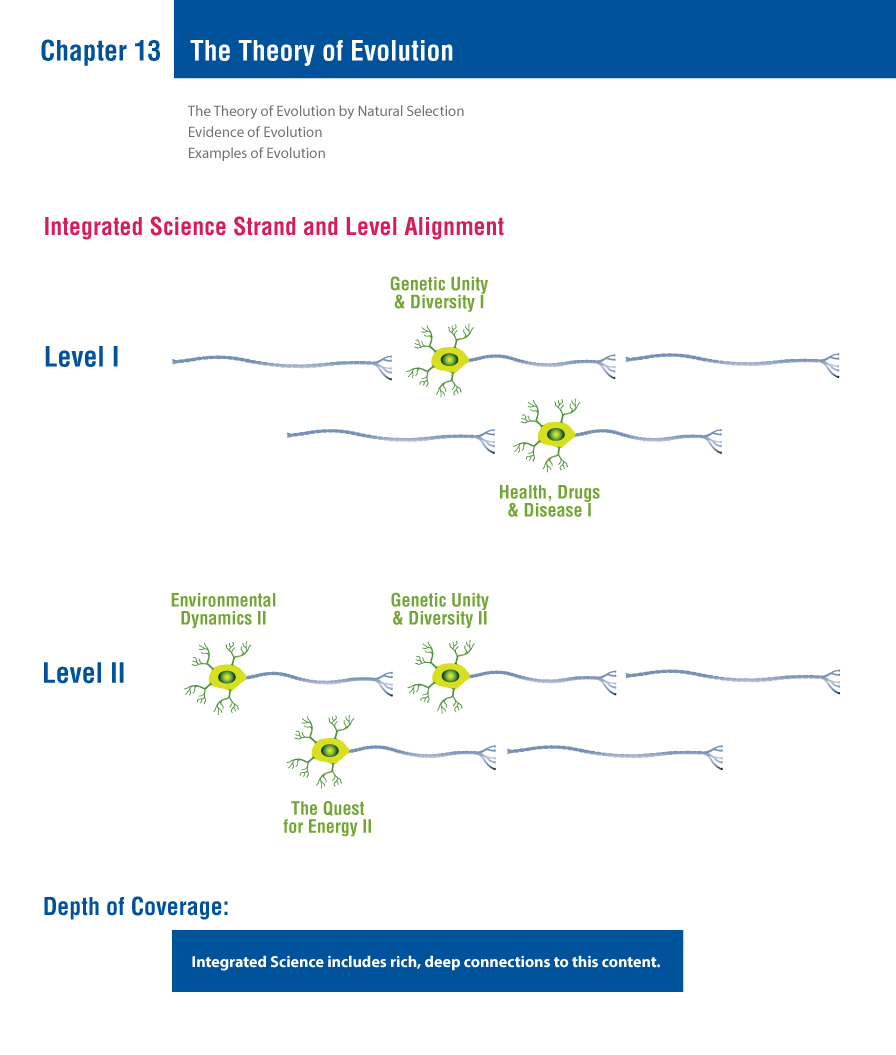
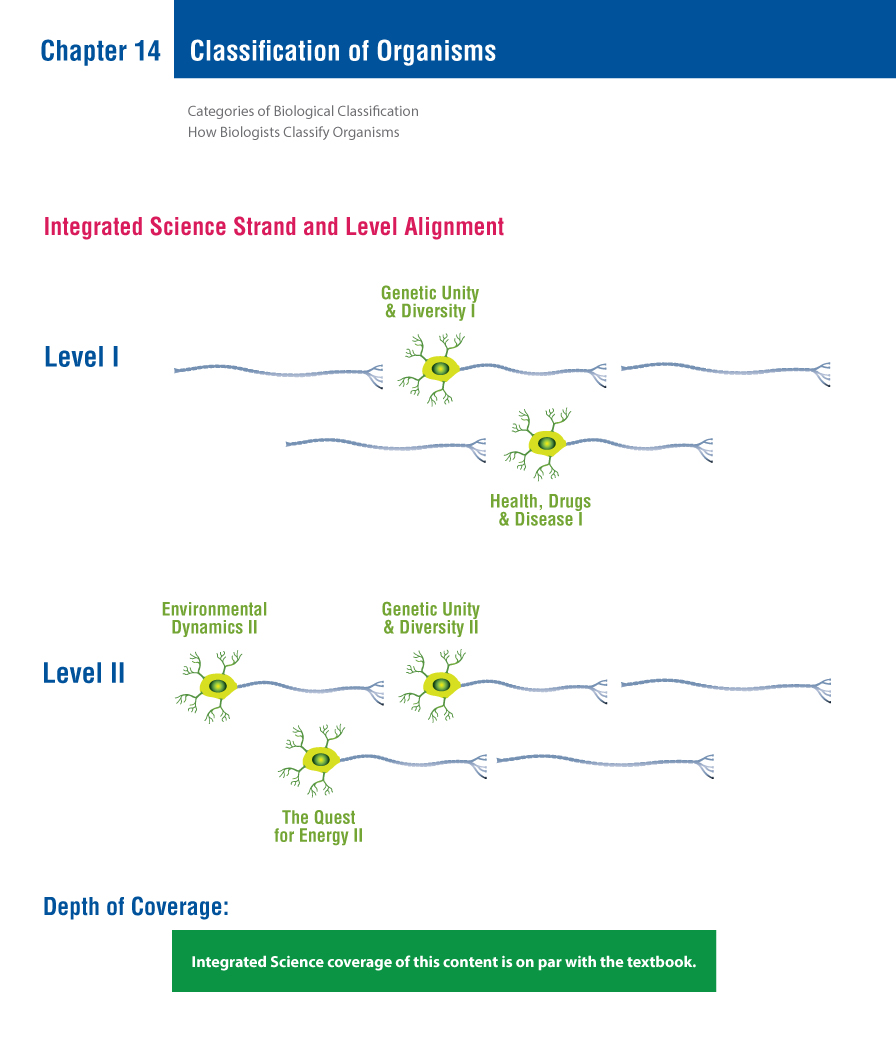
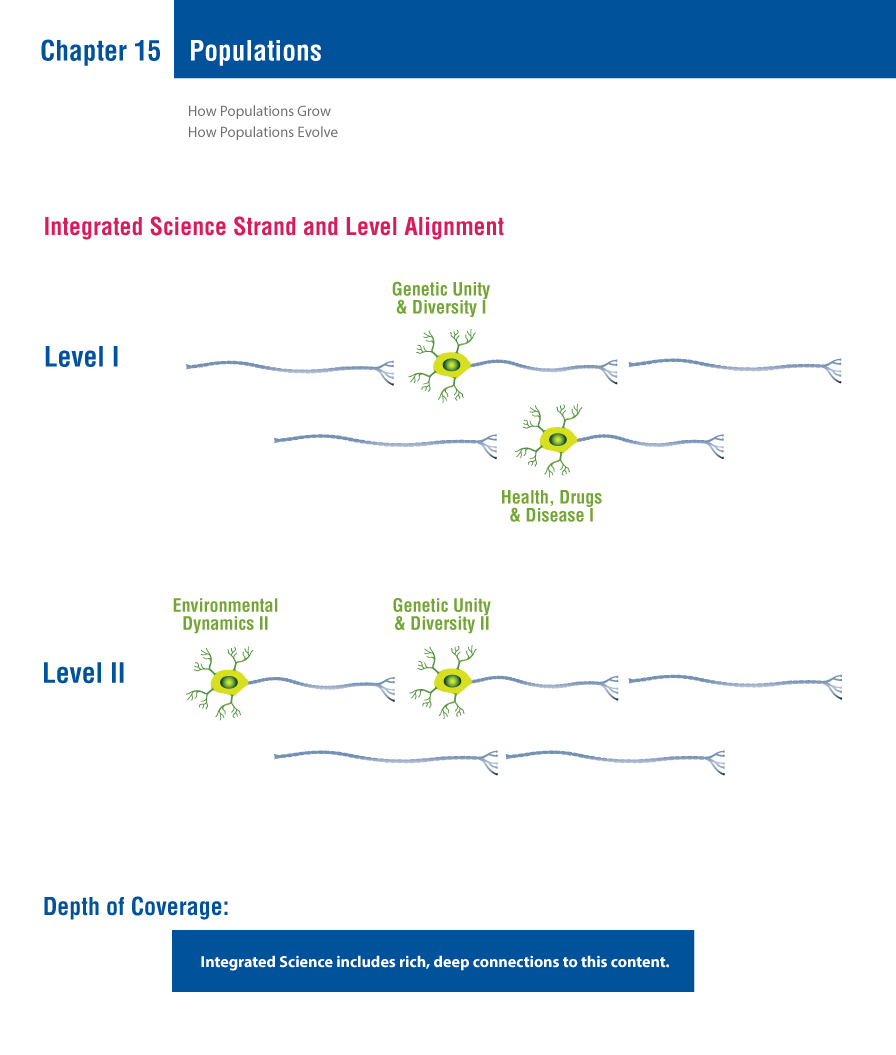
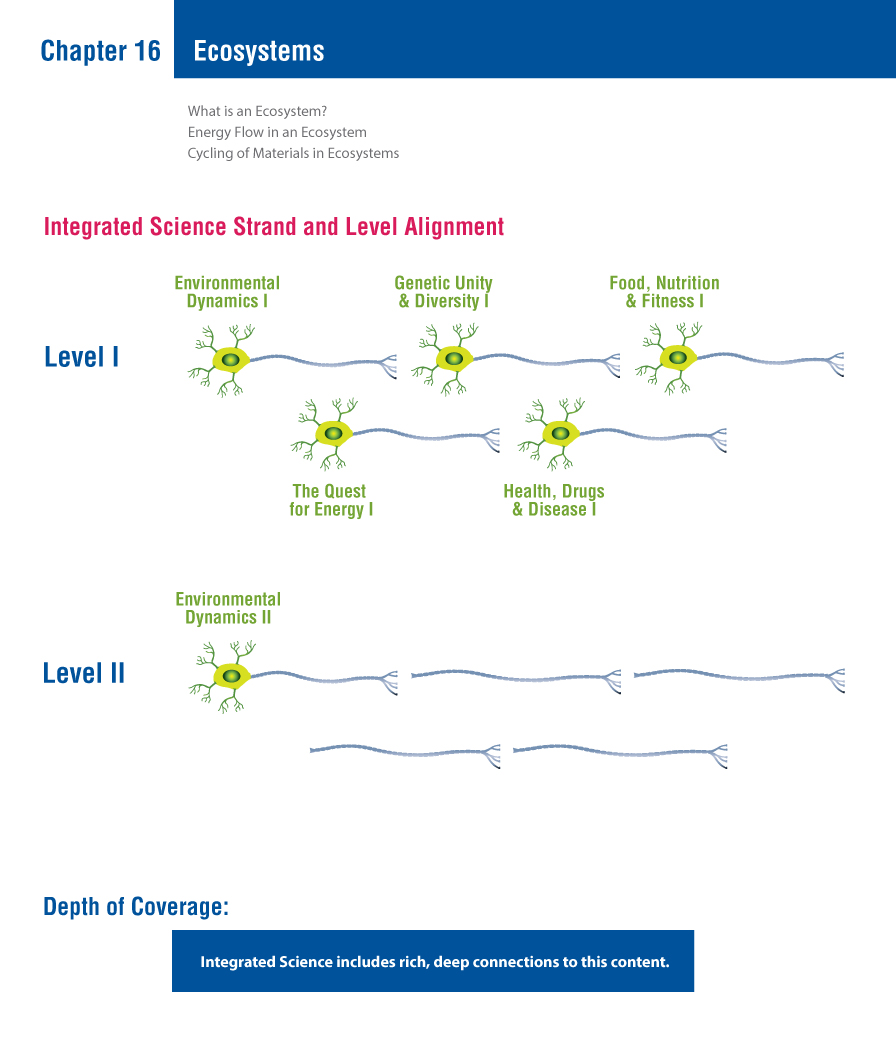
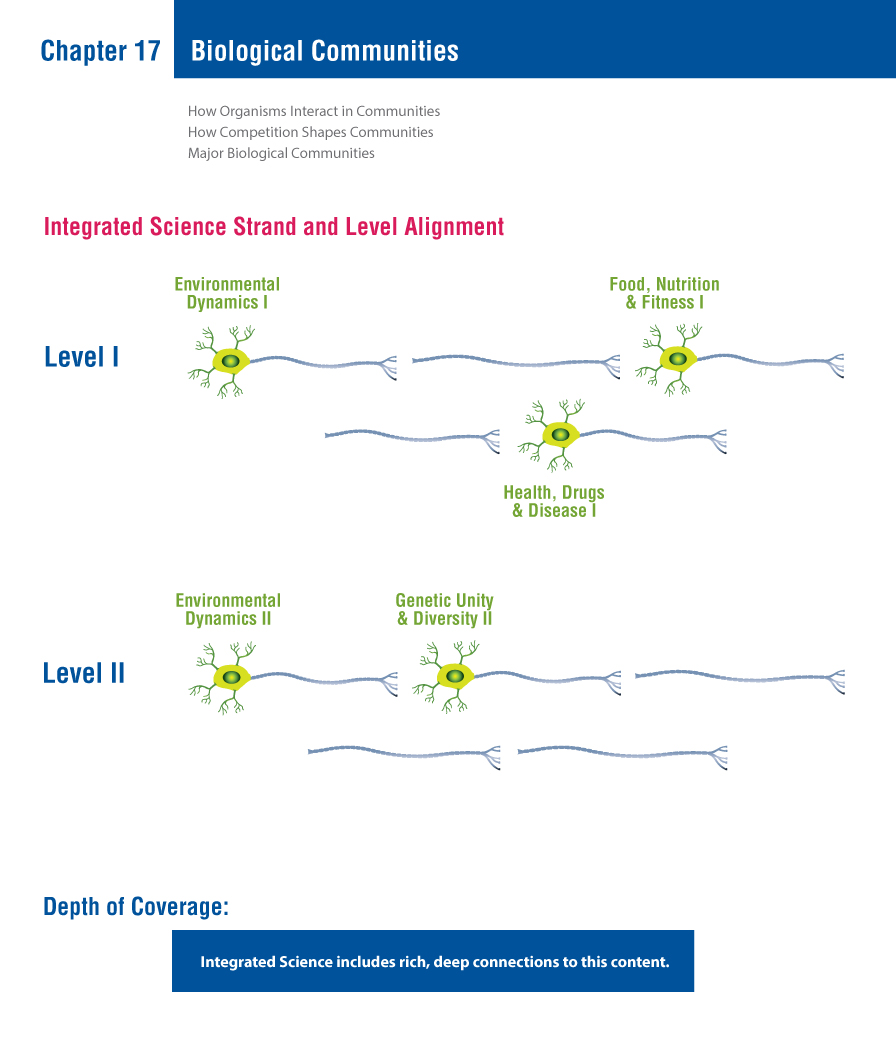
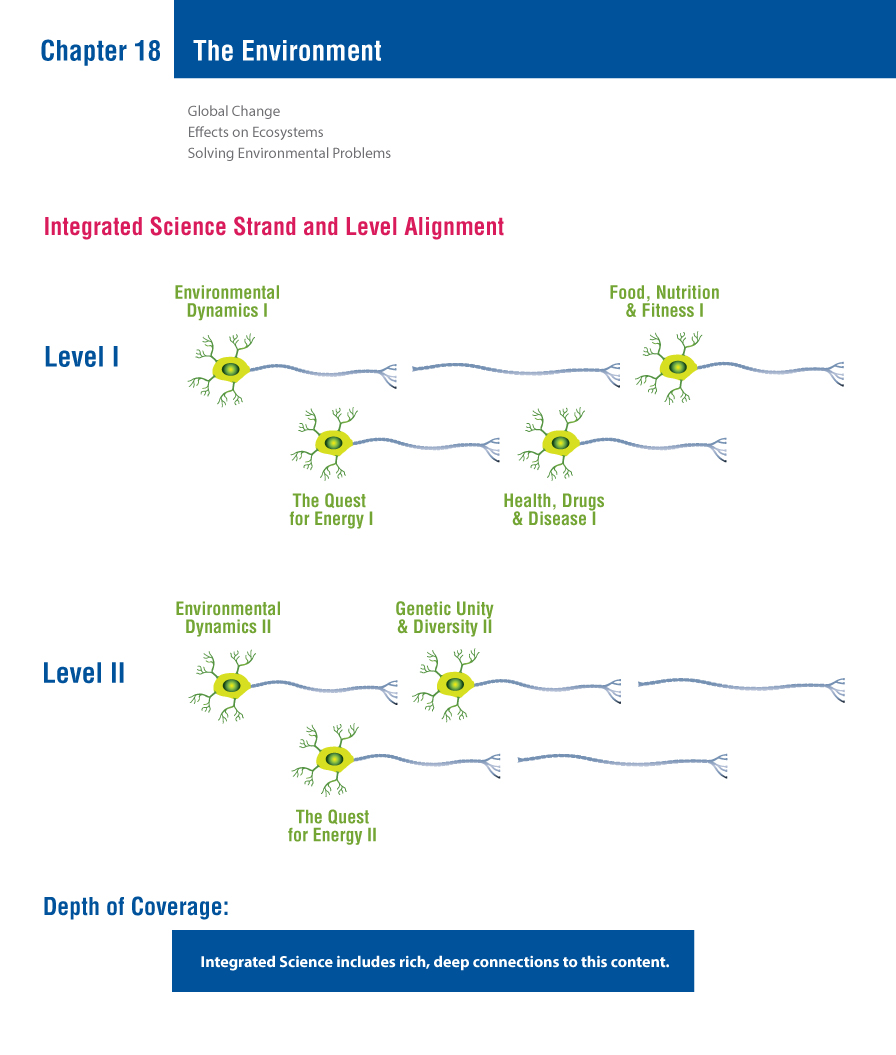
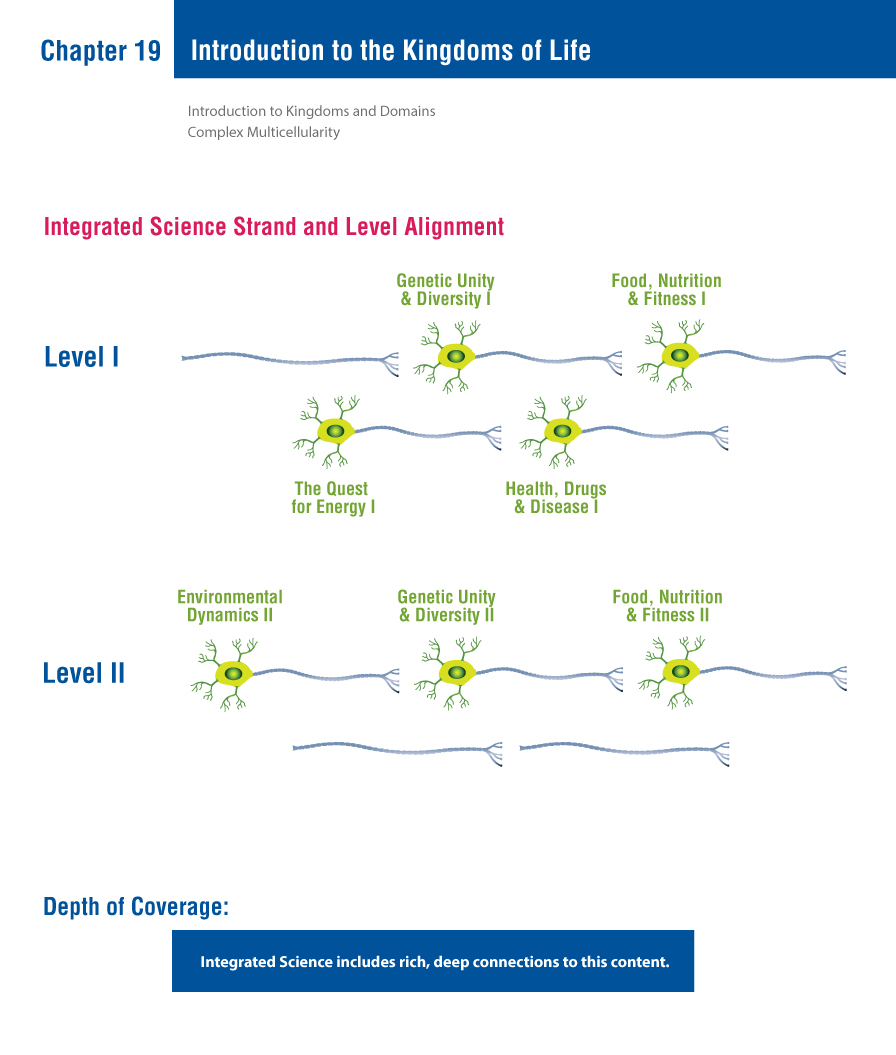
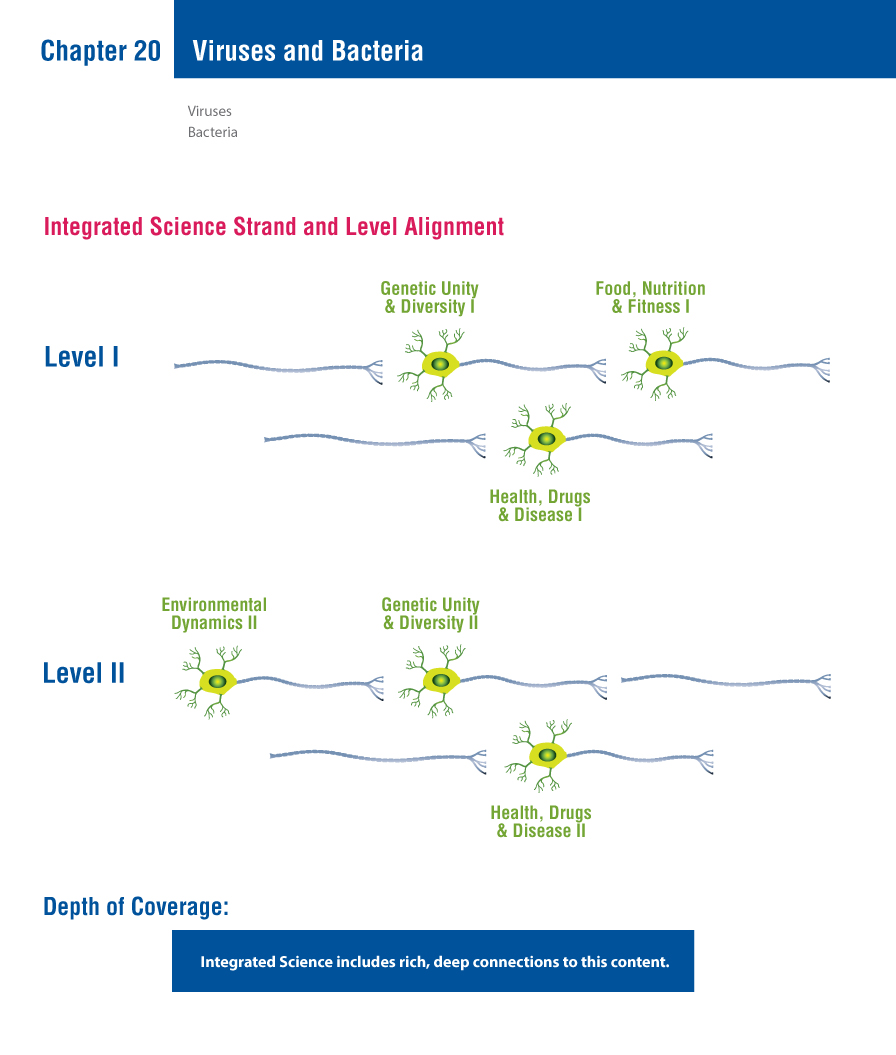
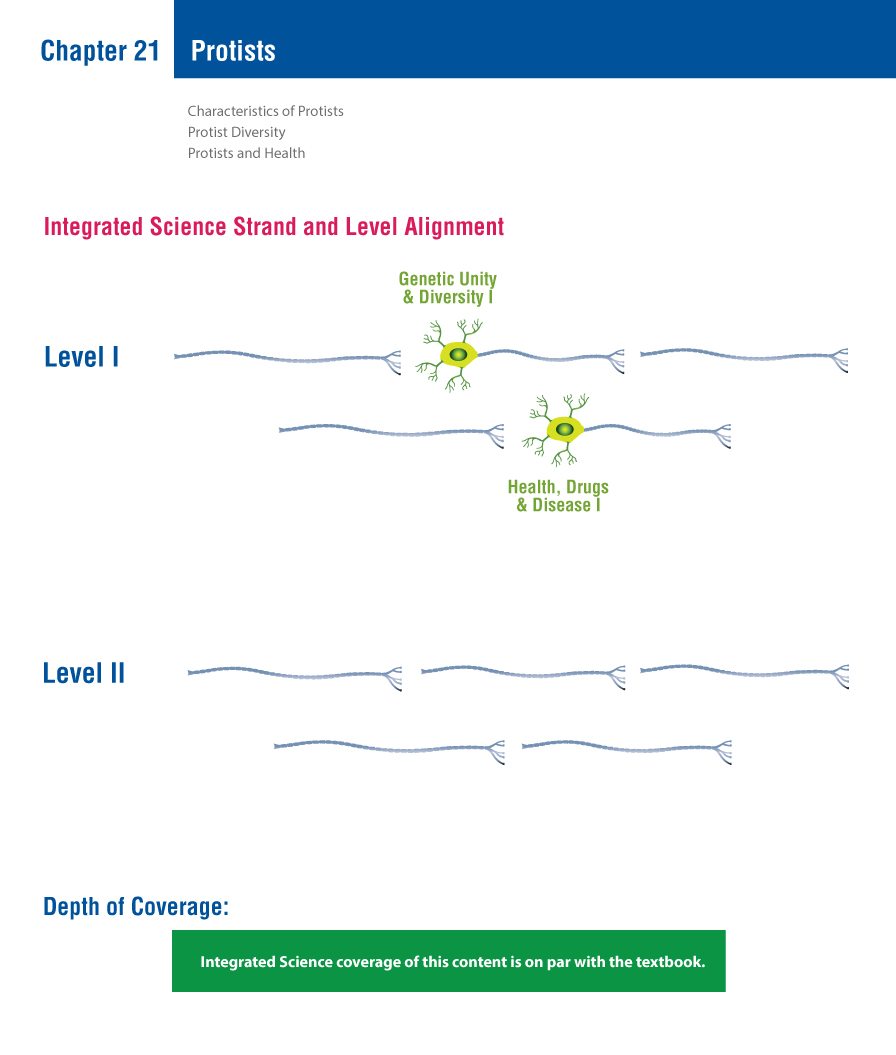
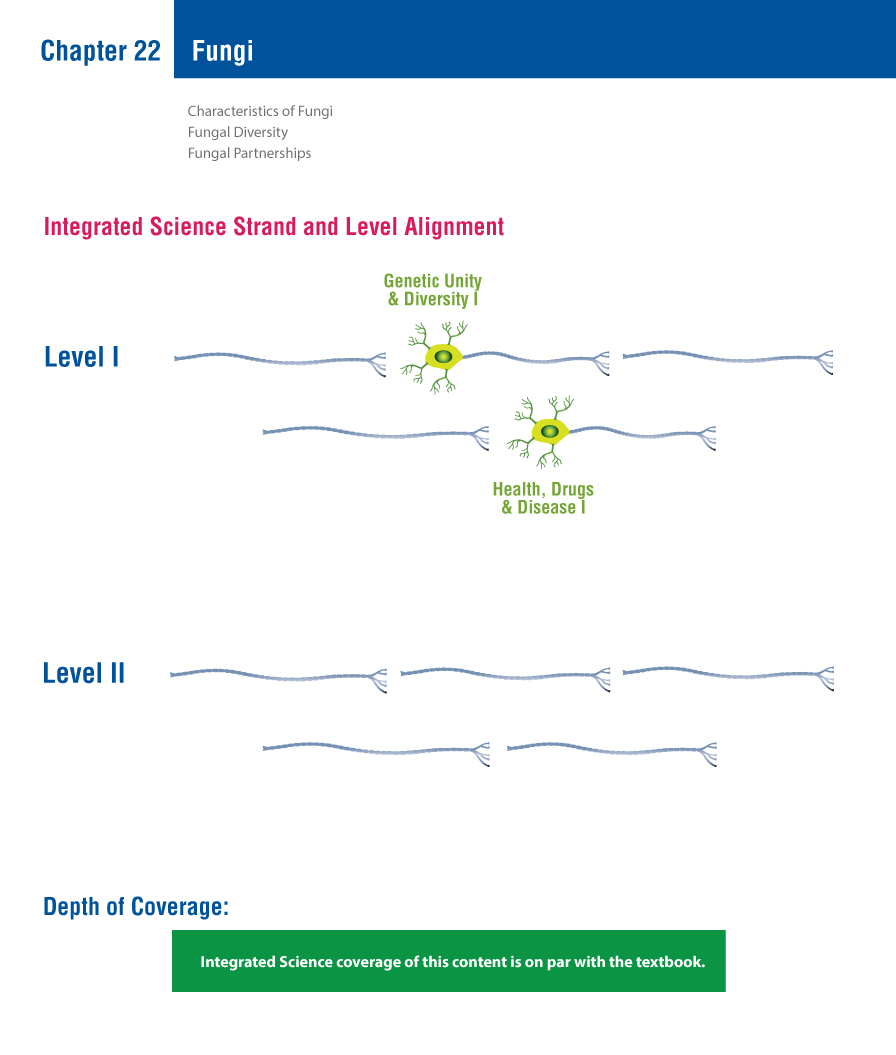
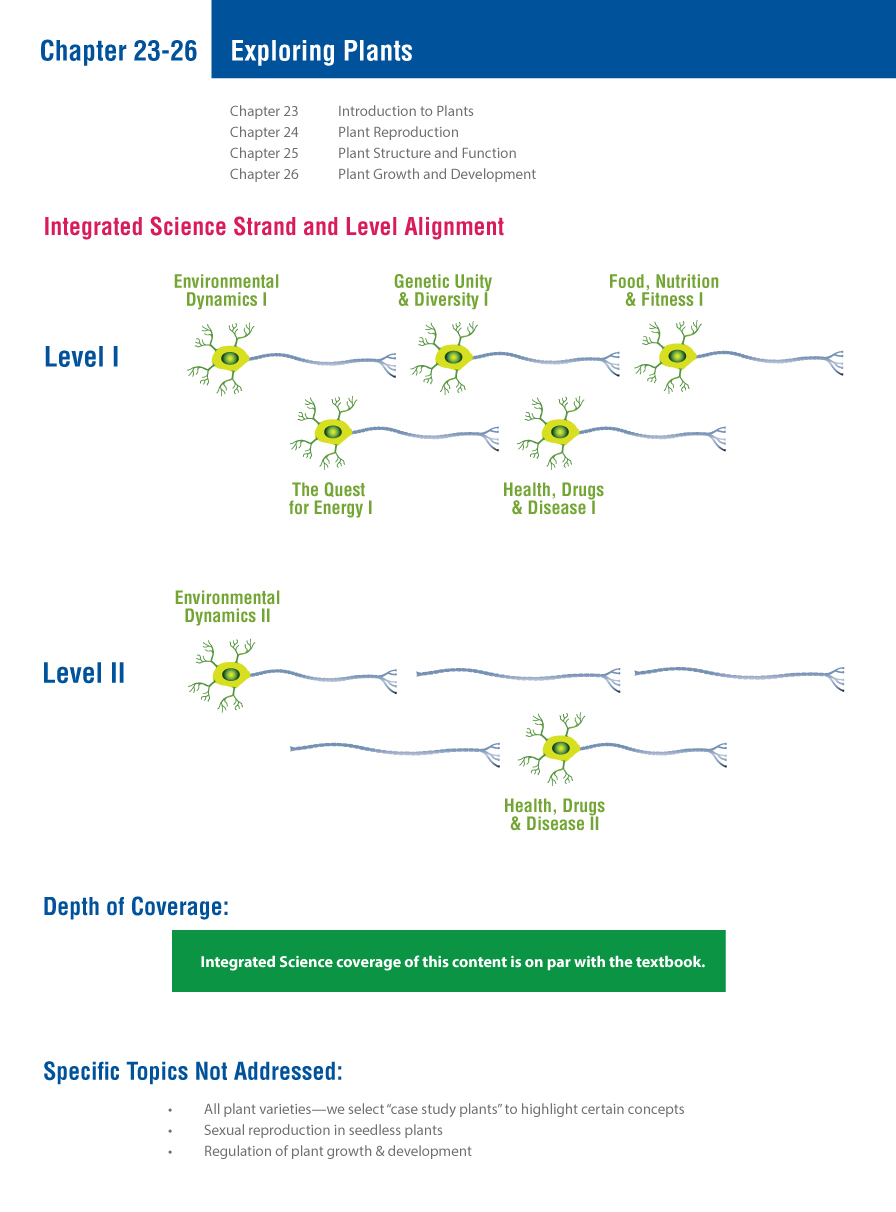
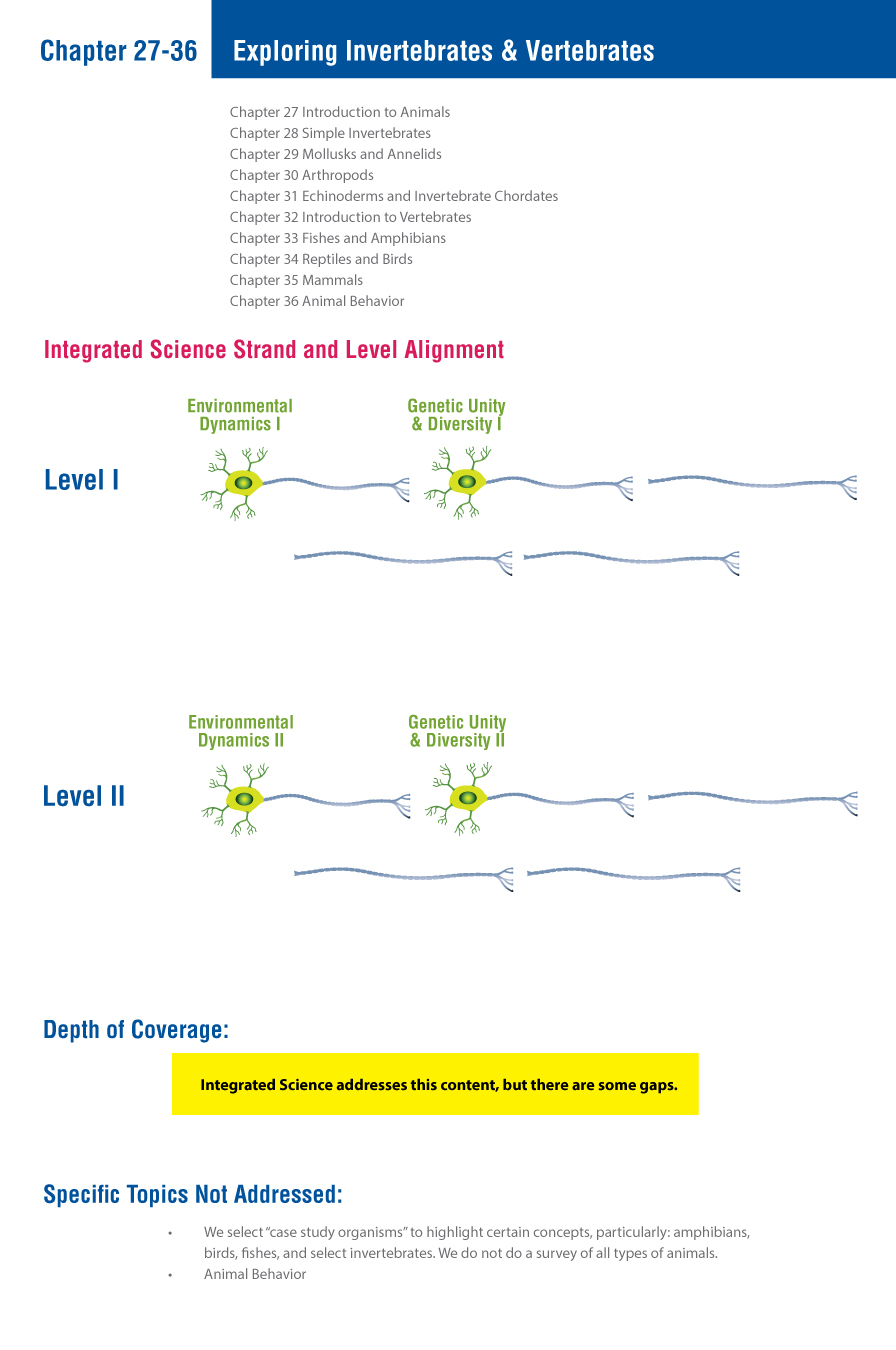
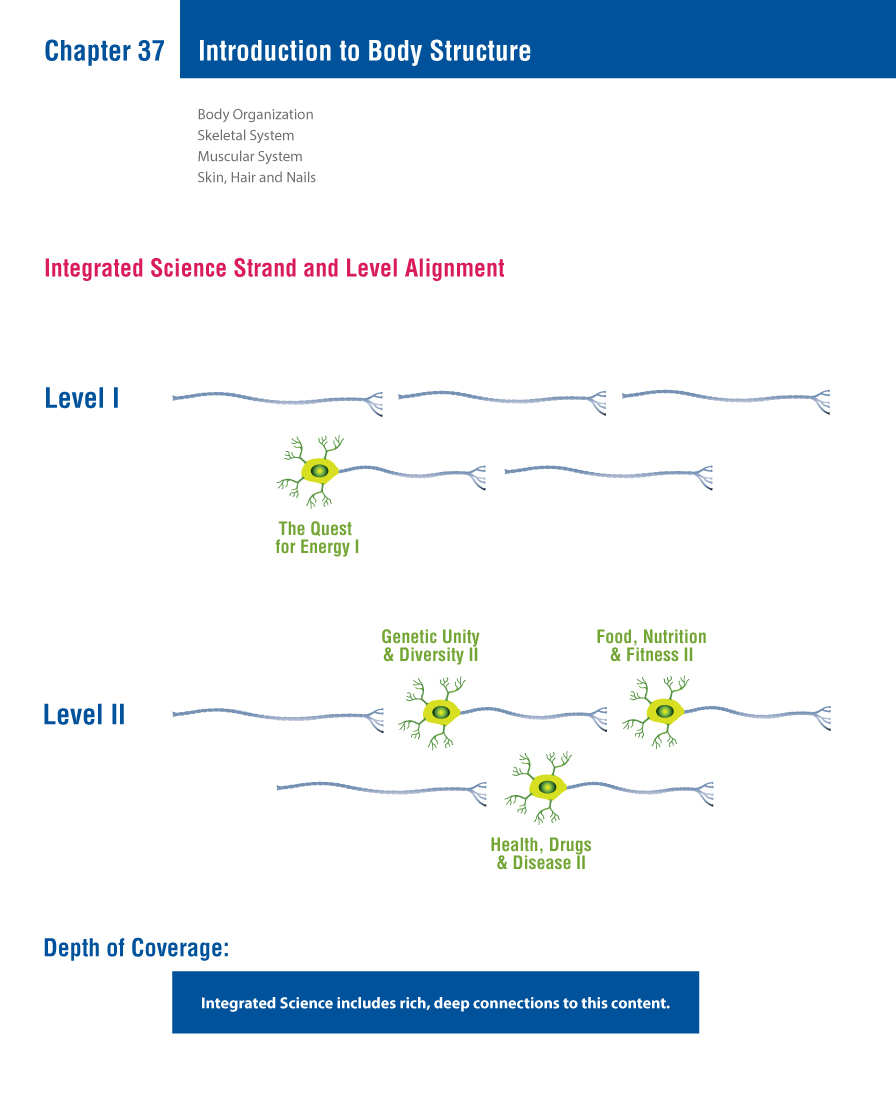
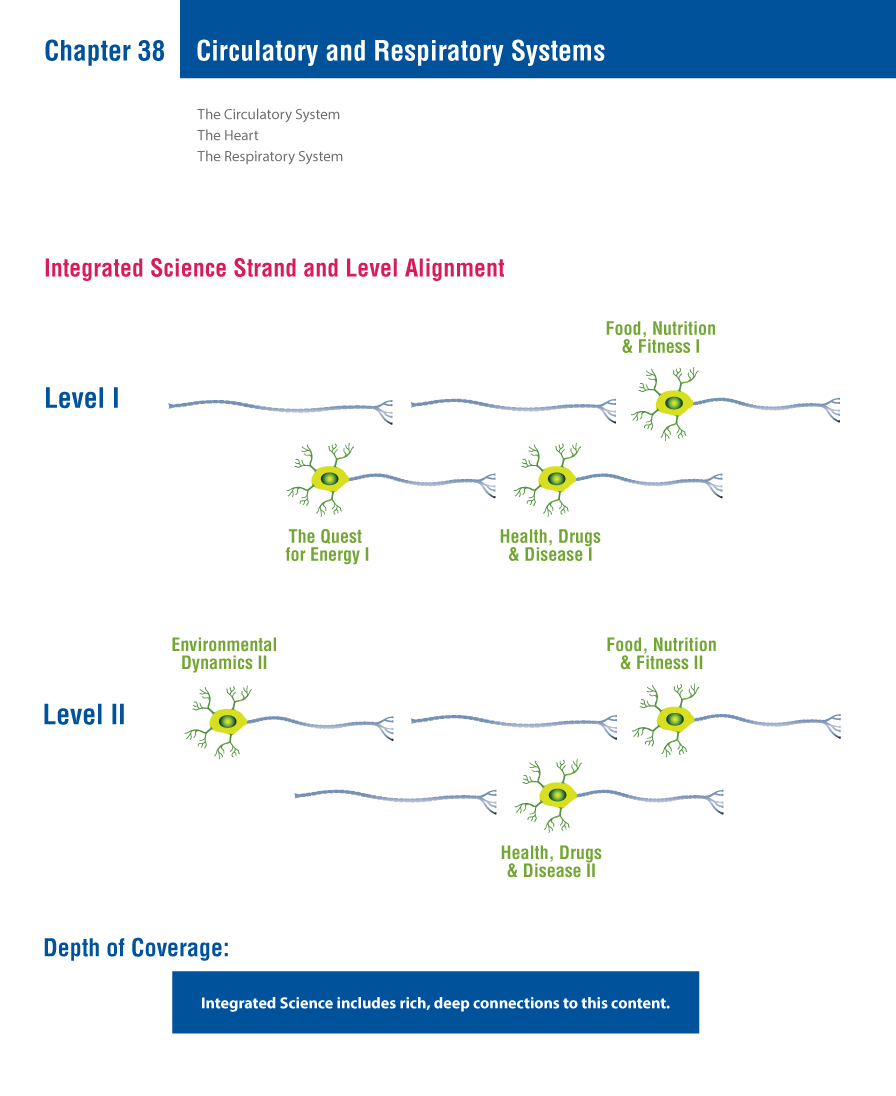
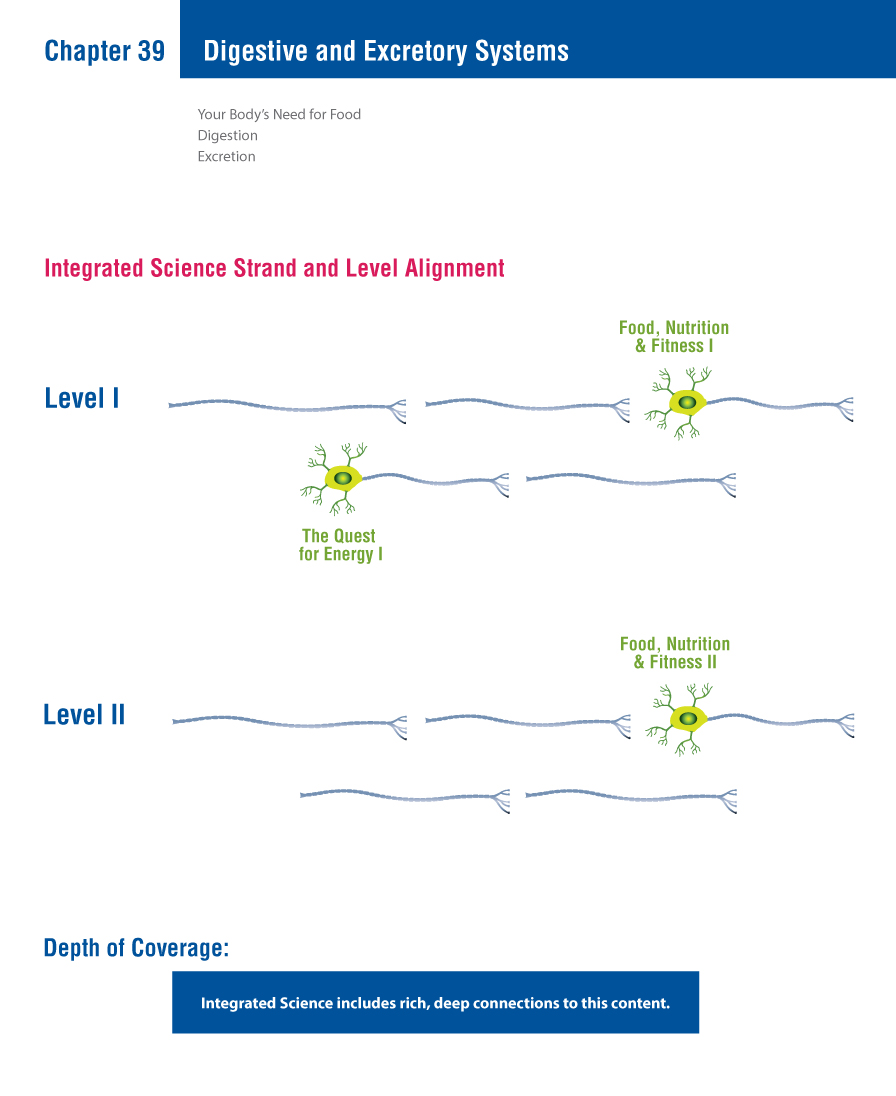
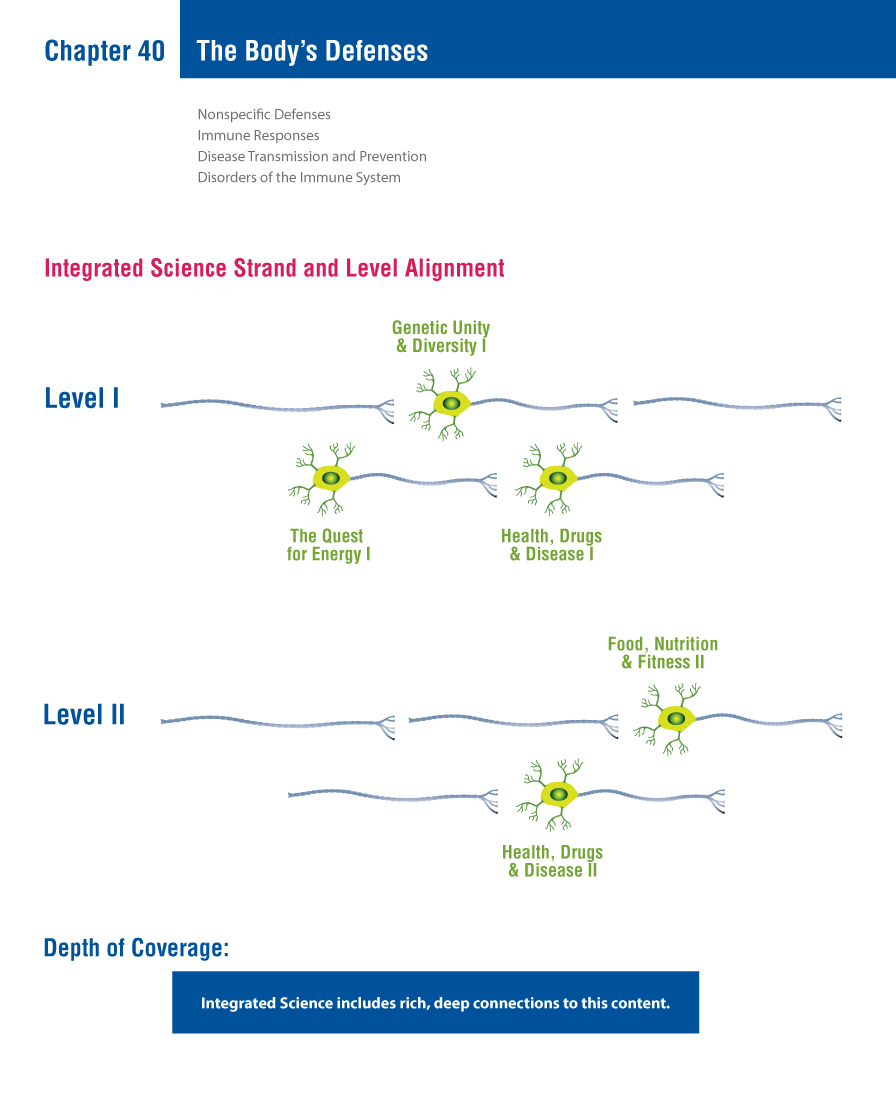
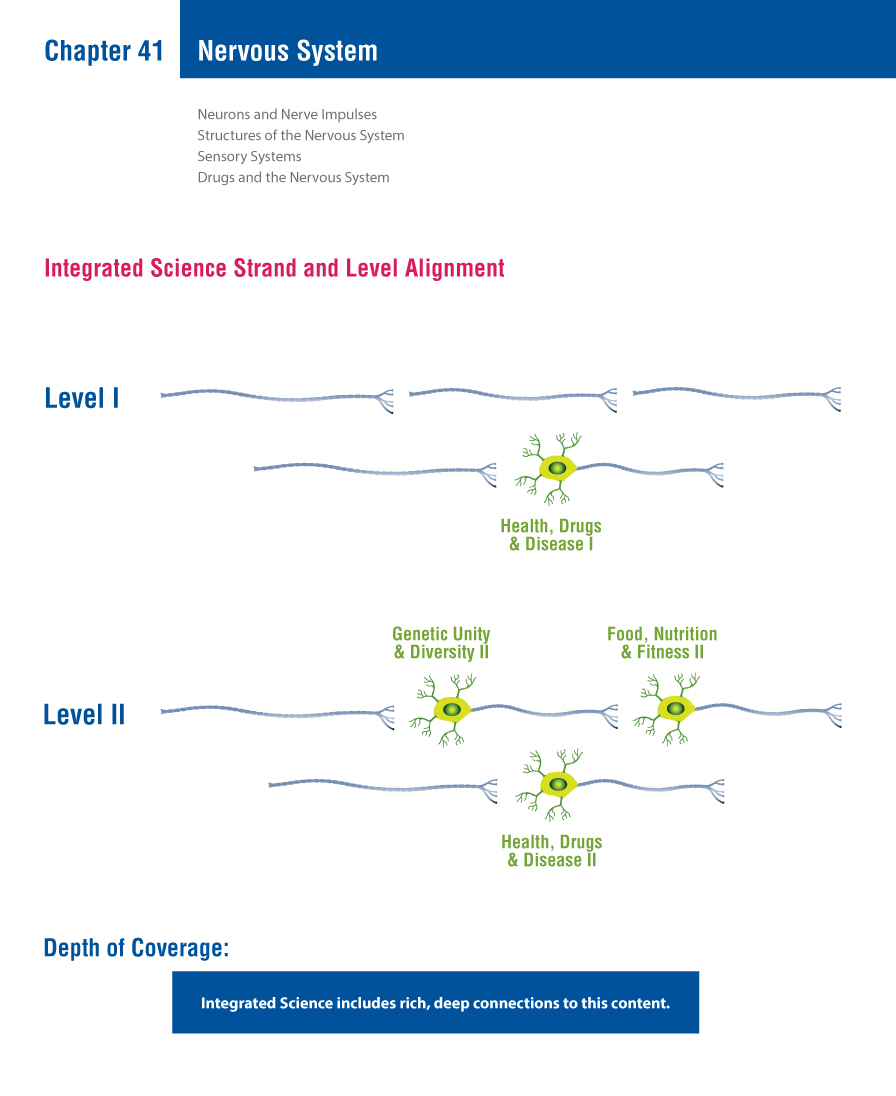
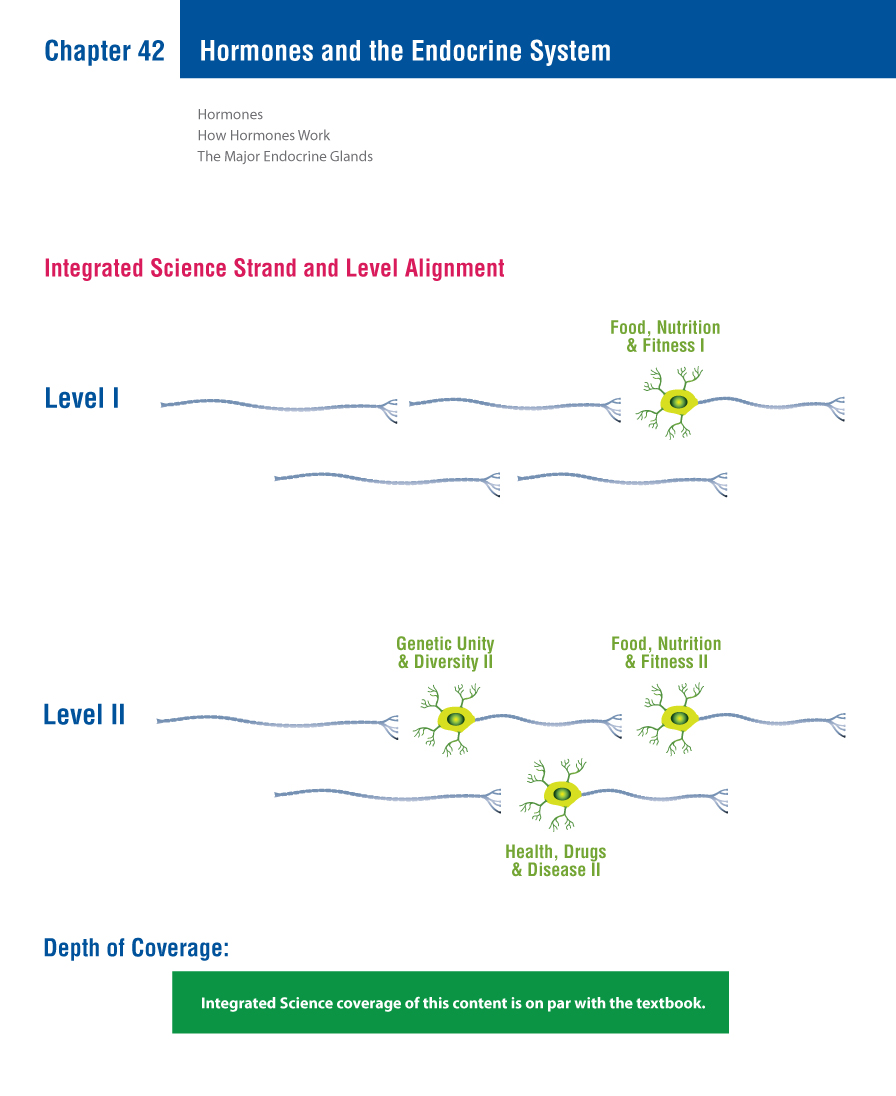
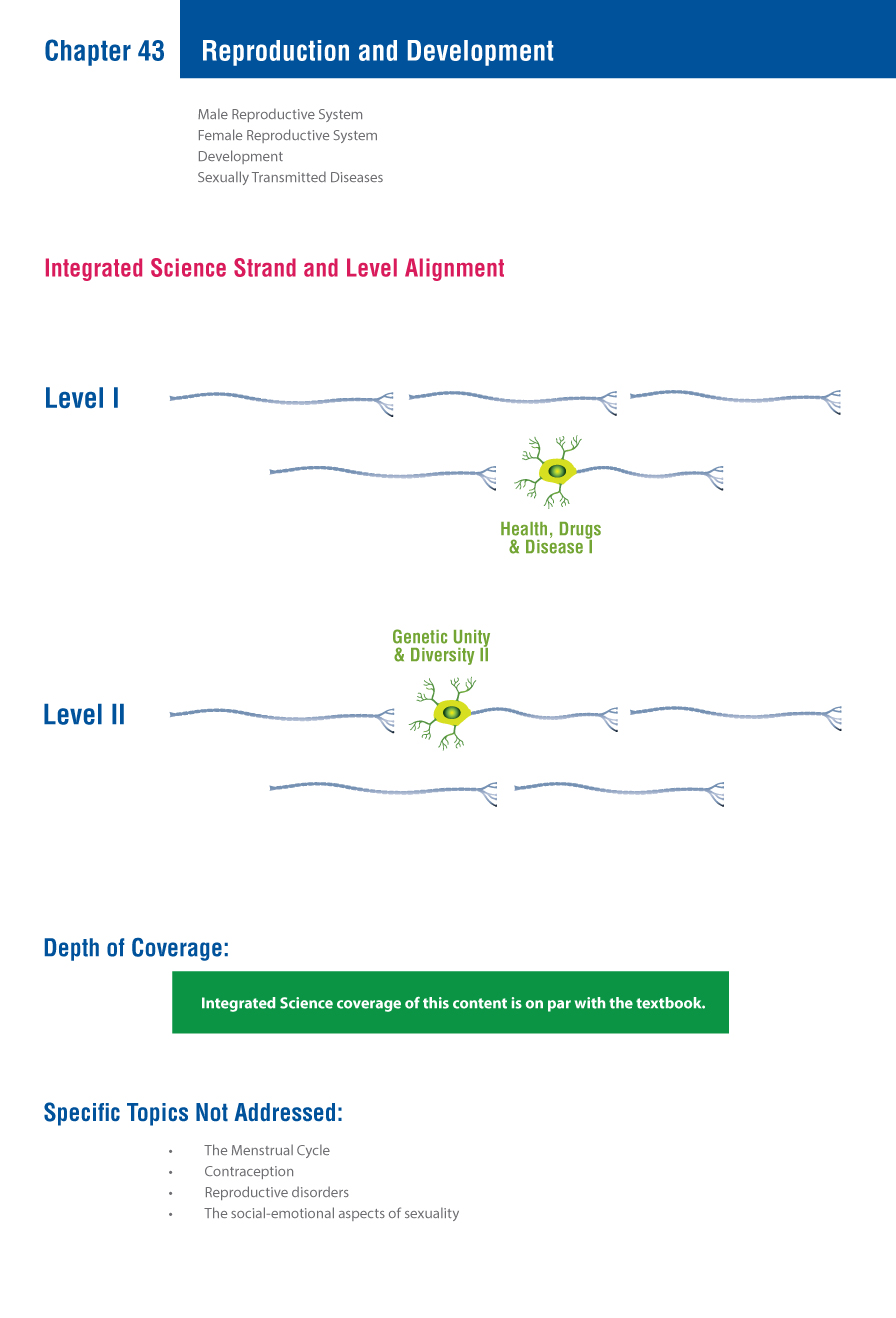
The following alignment is based on Prentice Hall Chemistry, a standard text for high school Chemistry classrooms.
Chapter 1 Introduction to Chemistry
Chapter 3 Scientific Measurement
Chapter 7 Ionic and Metallic Bonds
Chapter 9 Chemical Names and Formulas
Chapter 10 Chemical Quantities
Chapter 14 The Behavior of Gases
Chapter 15 Water and Aqueous Solutions
Chapter 18 Reaction Rates and Equilibrium
Chapter 19 Acids, Bases and Salts
Chapter 20 Oxidation-Reduction Reactions
Chapter 22 Hydrocarbon compounds
Chapter 24 The Chemistry of Life
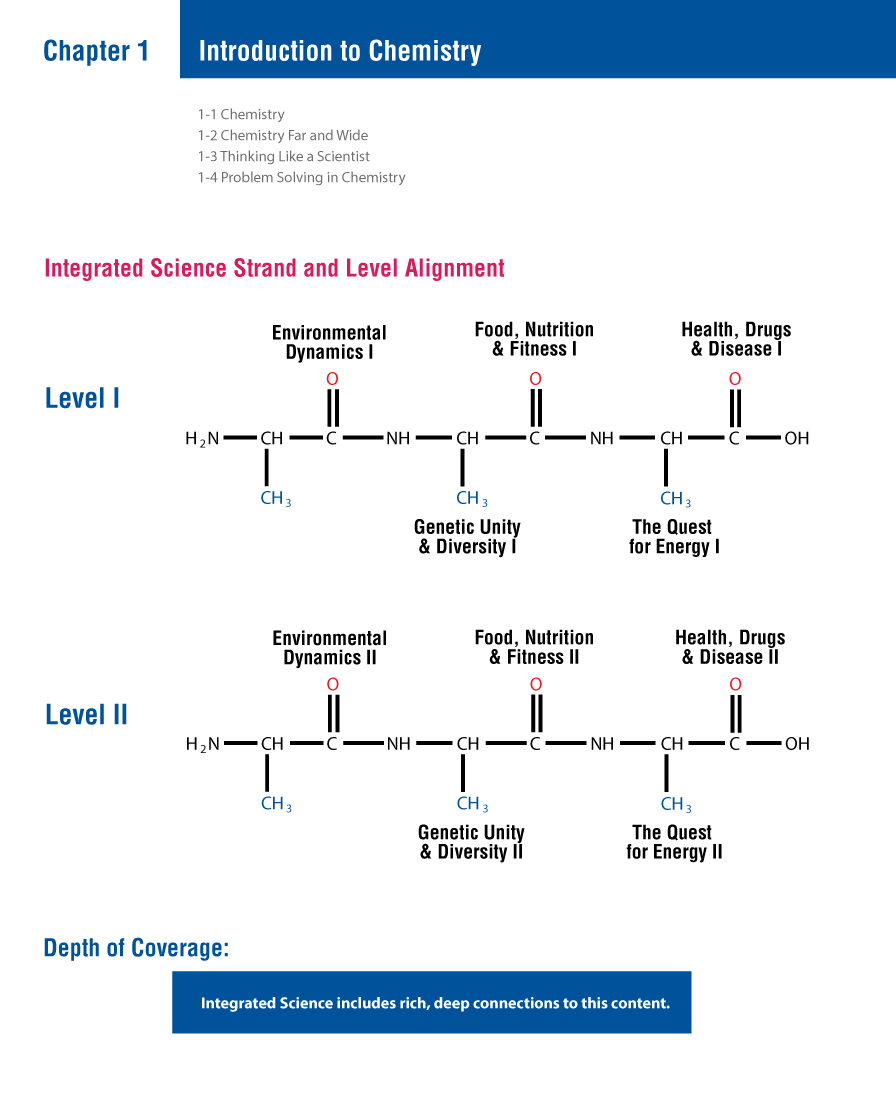
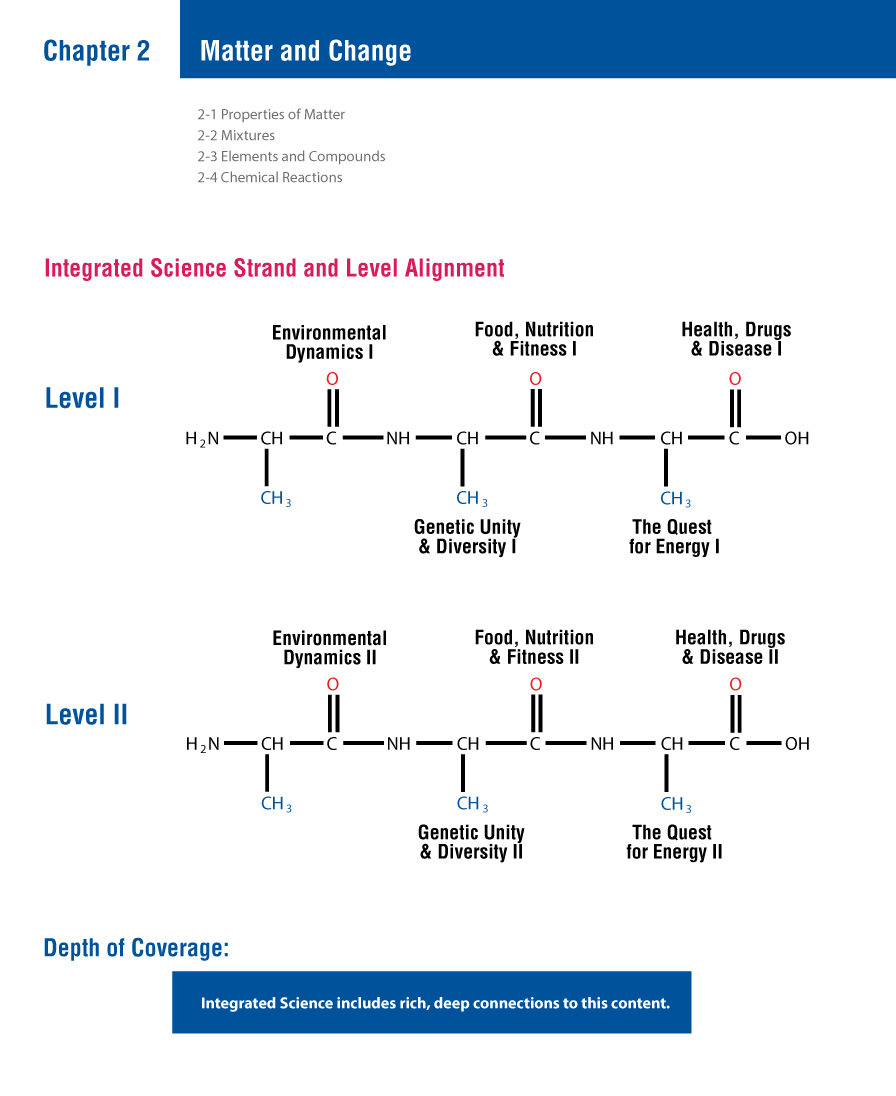
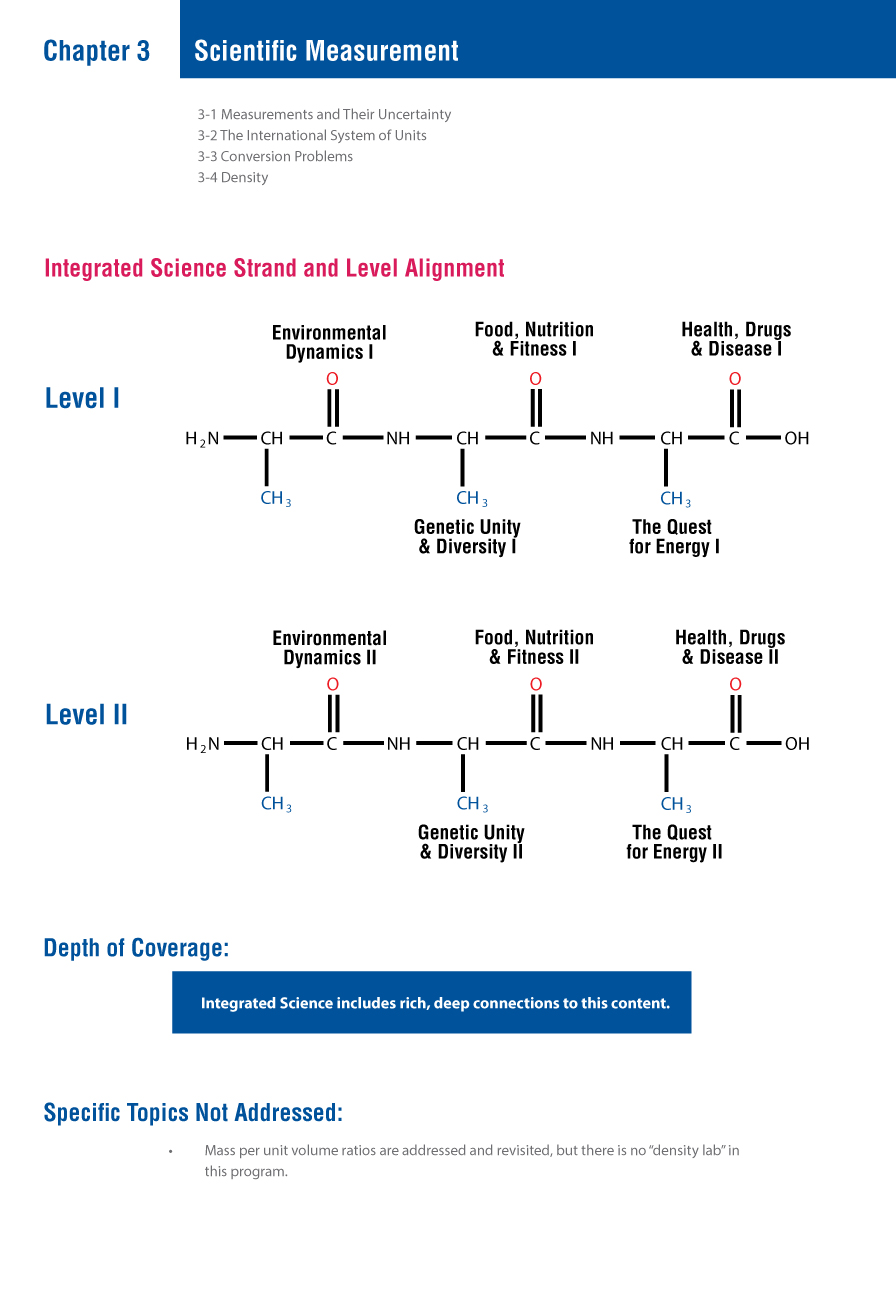
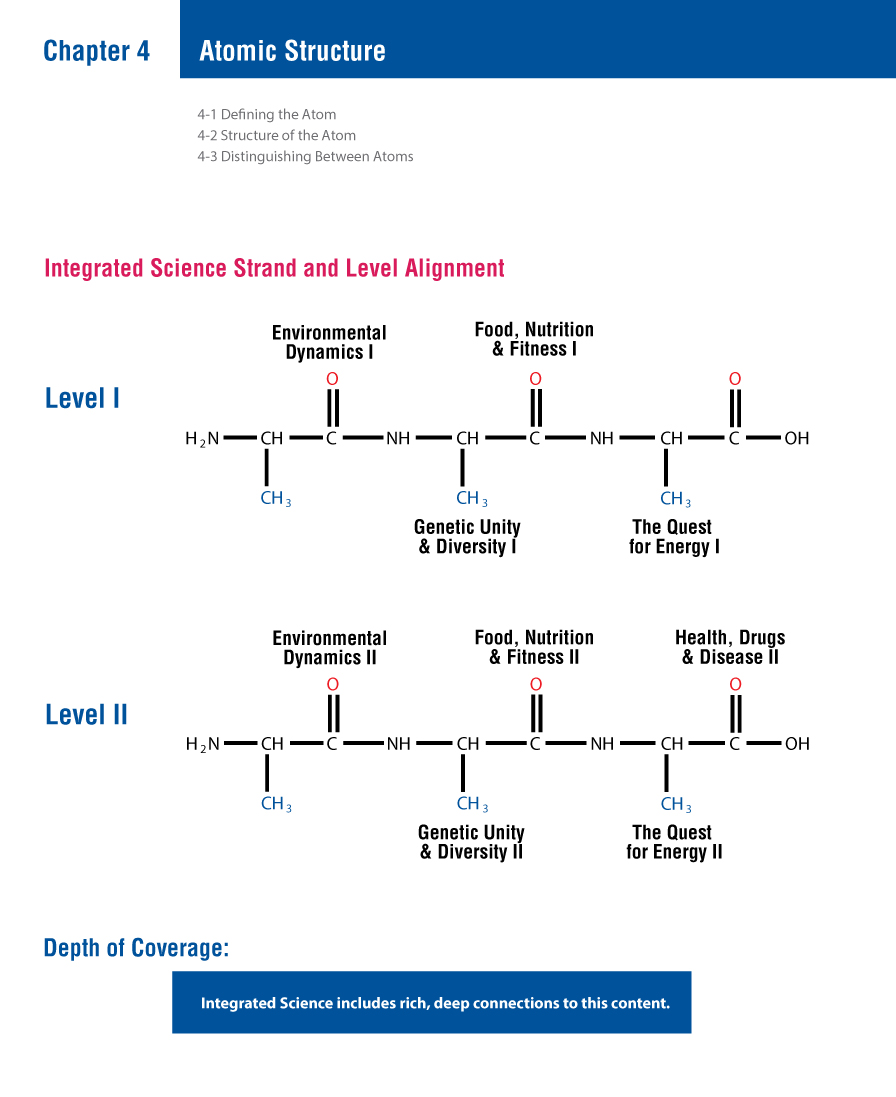
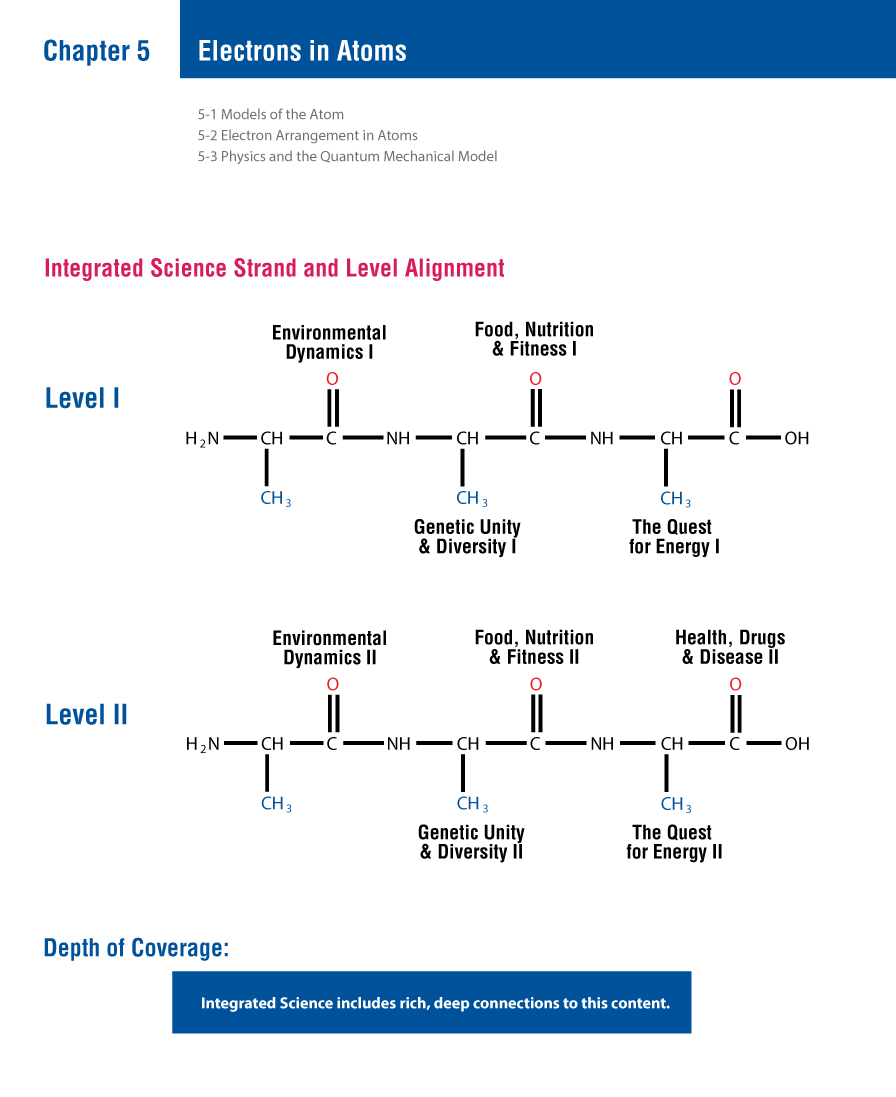
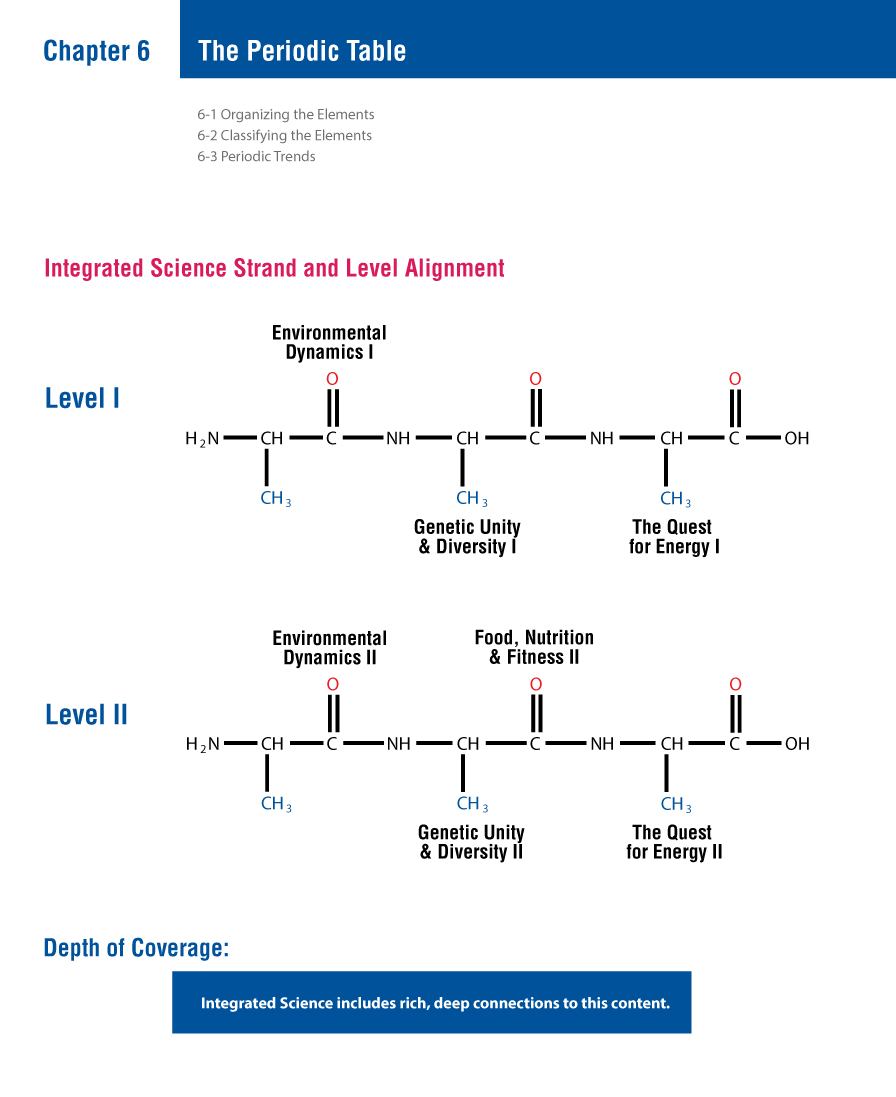

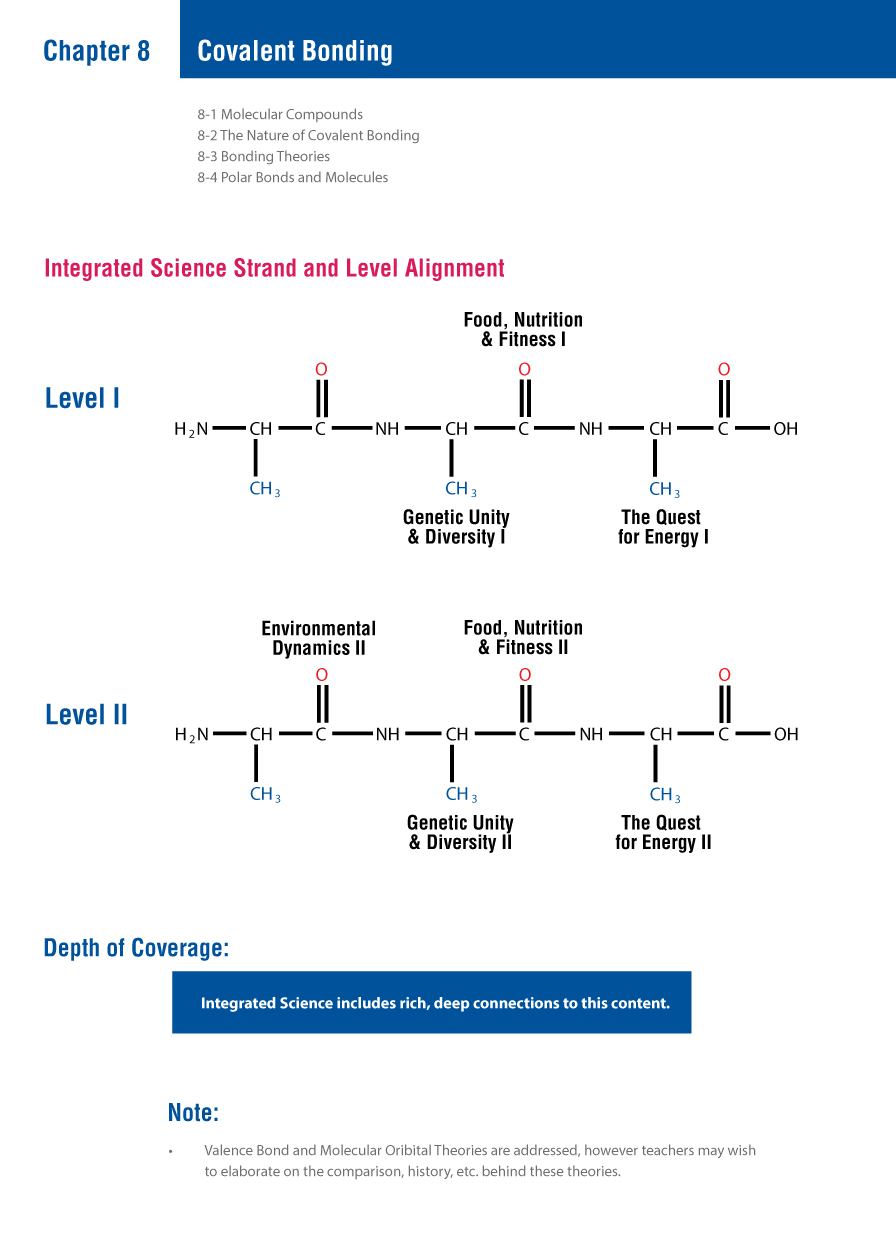
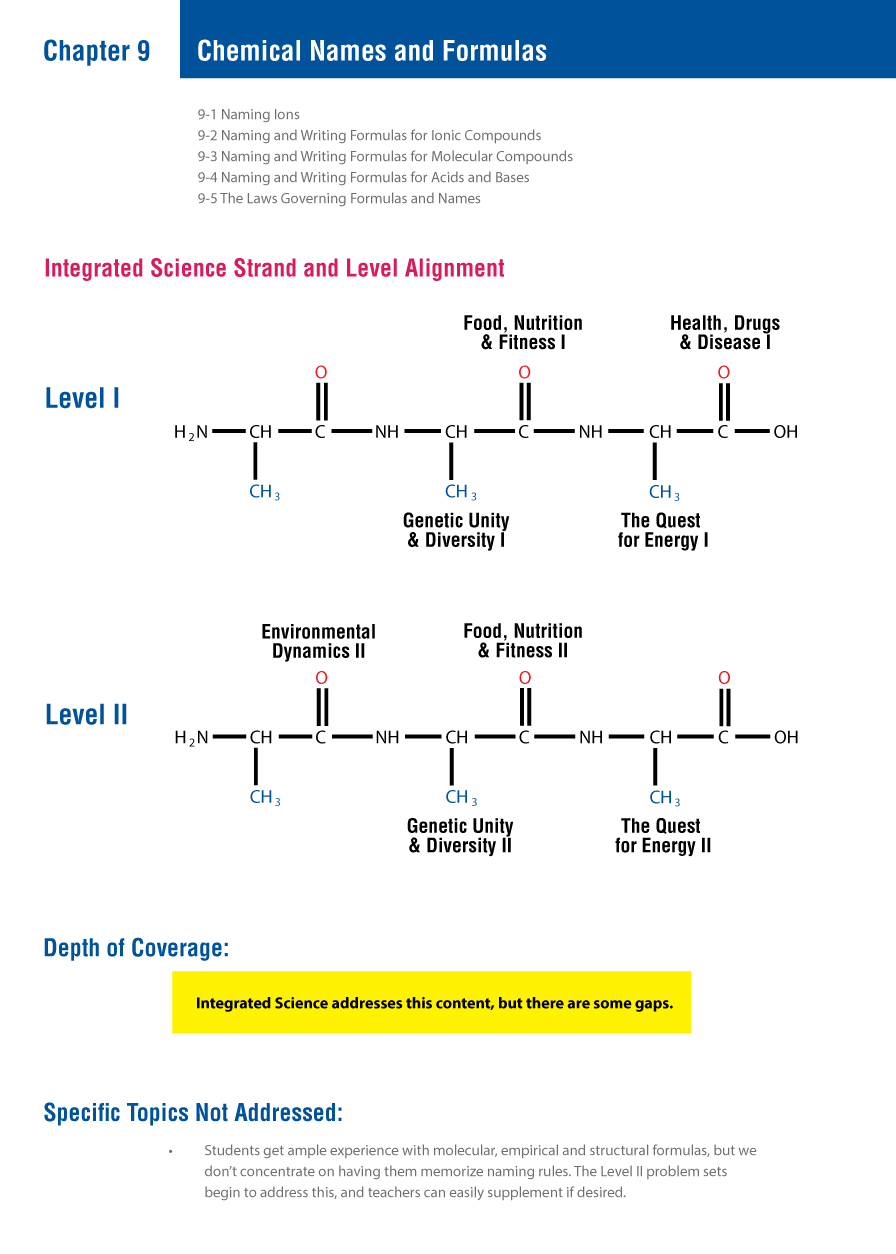
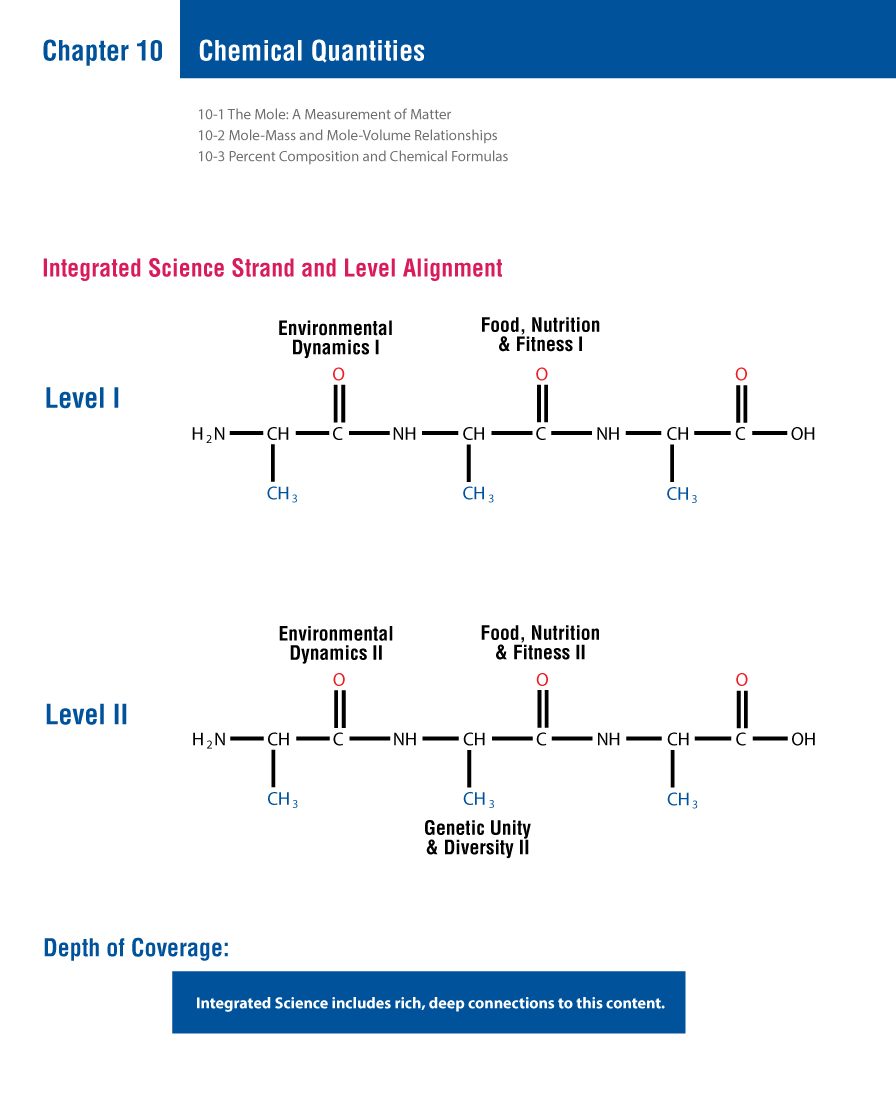
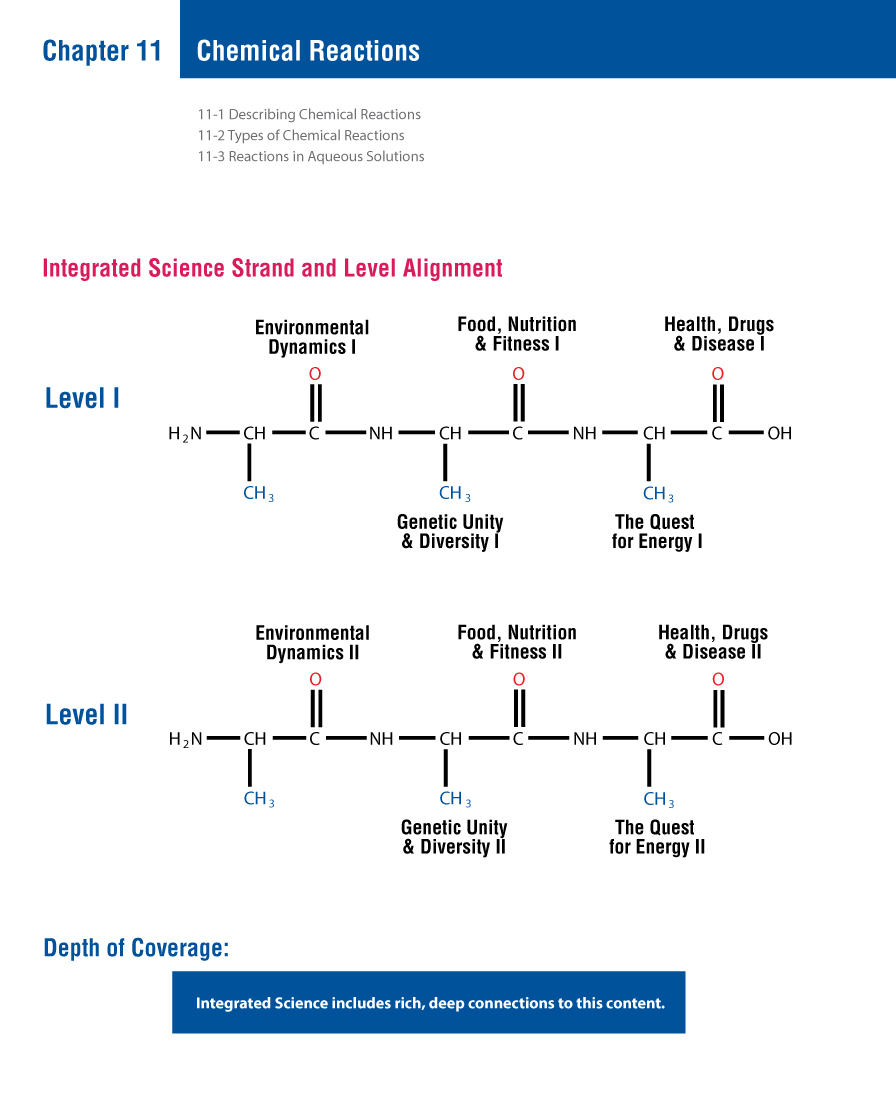
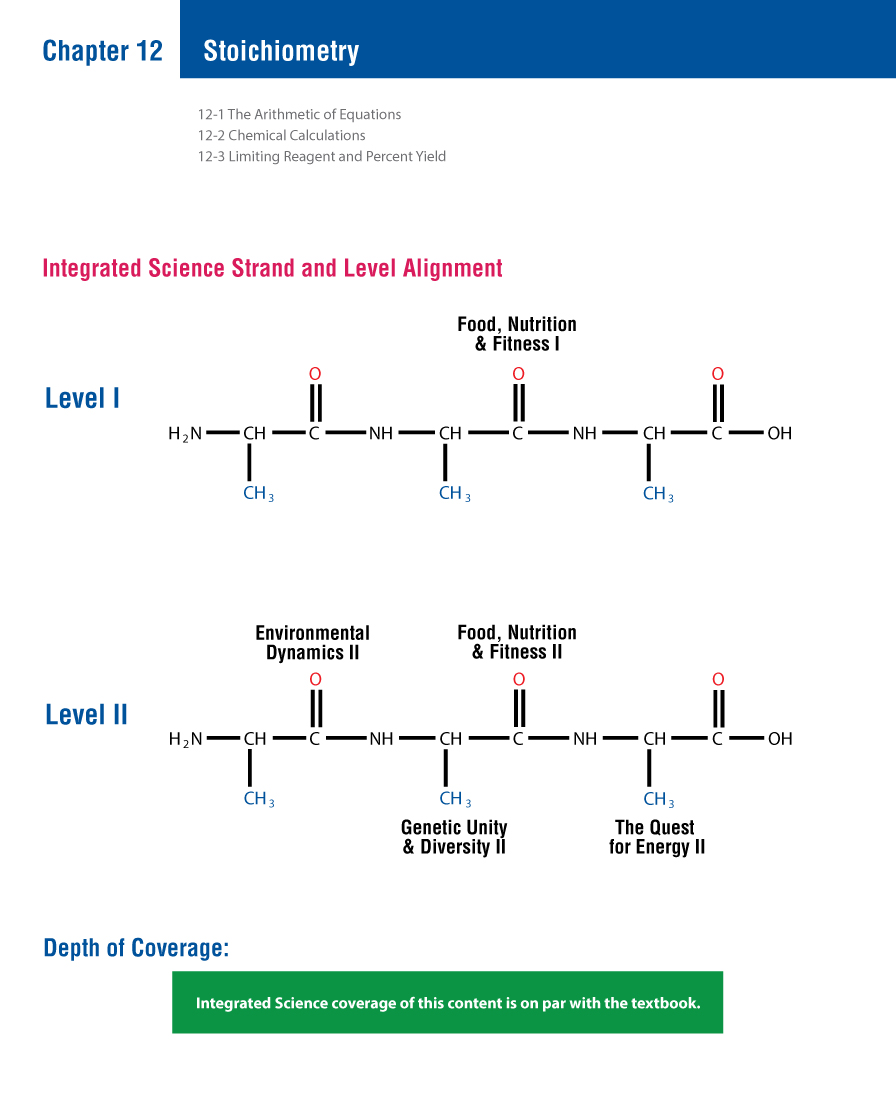
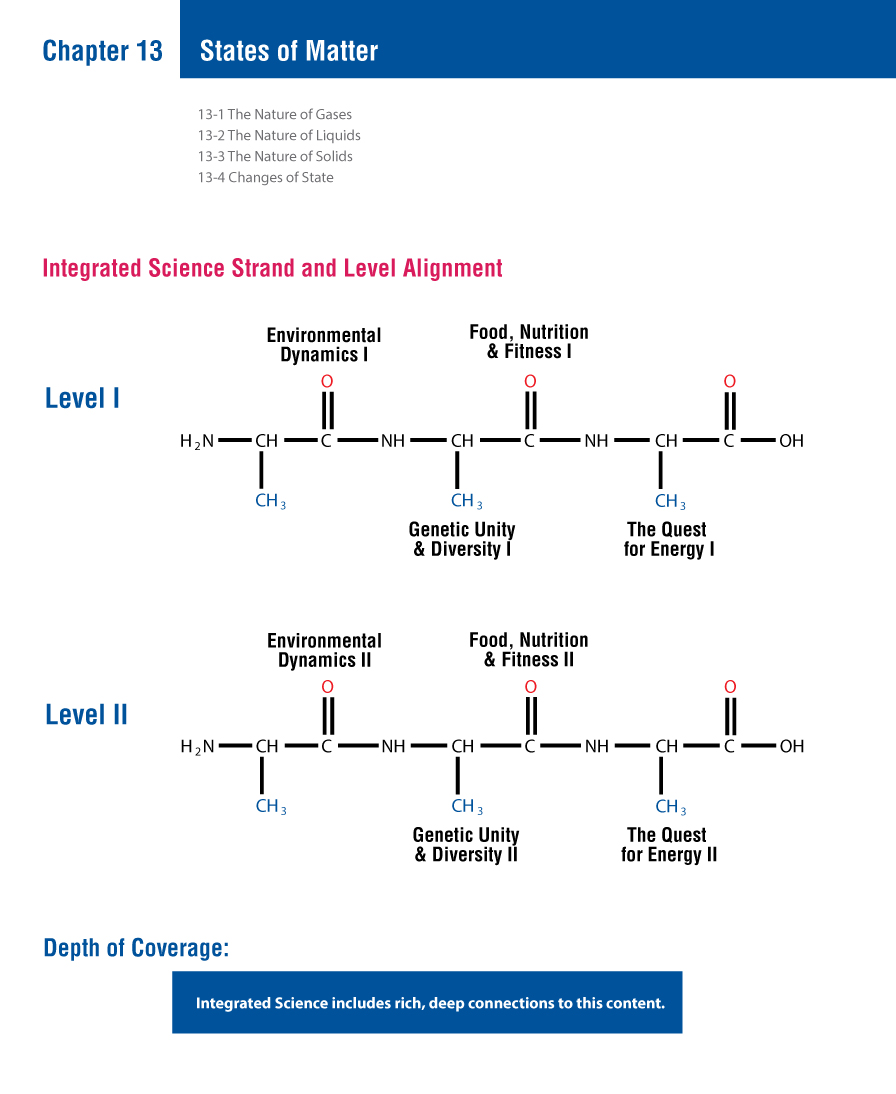

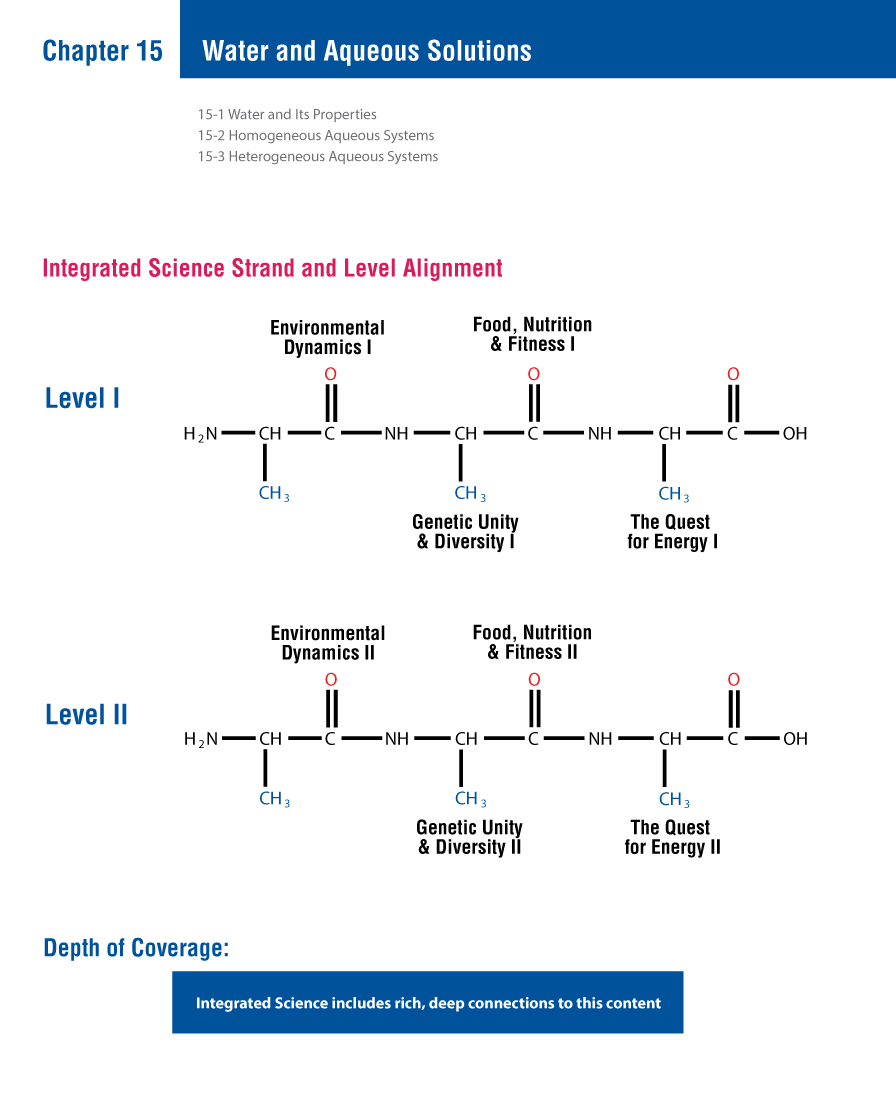
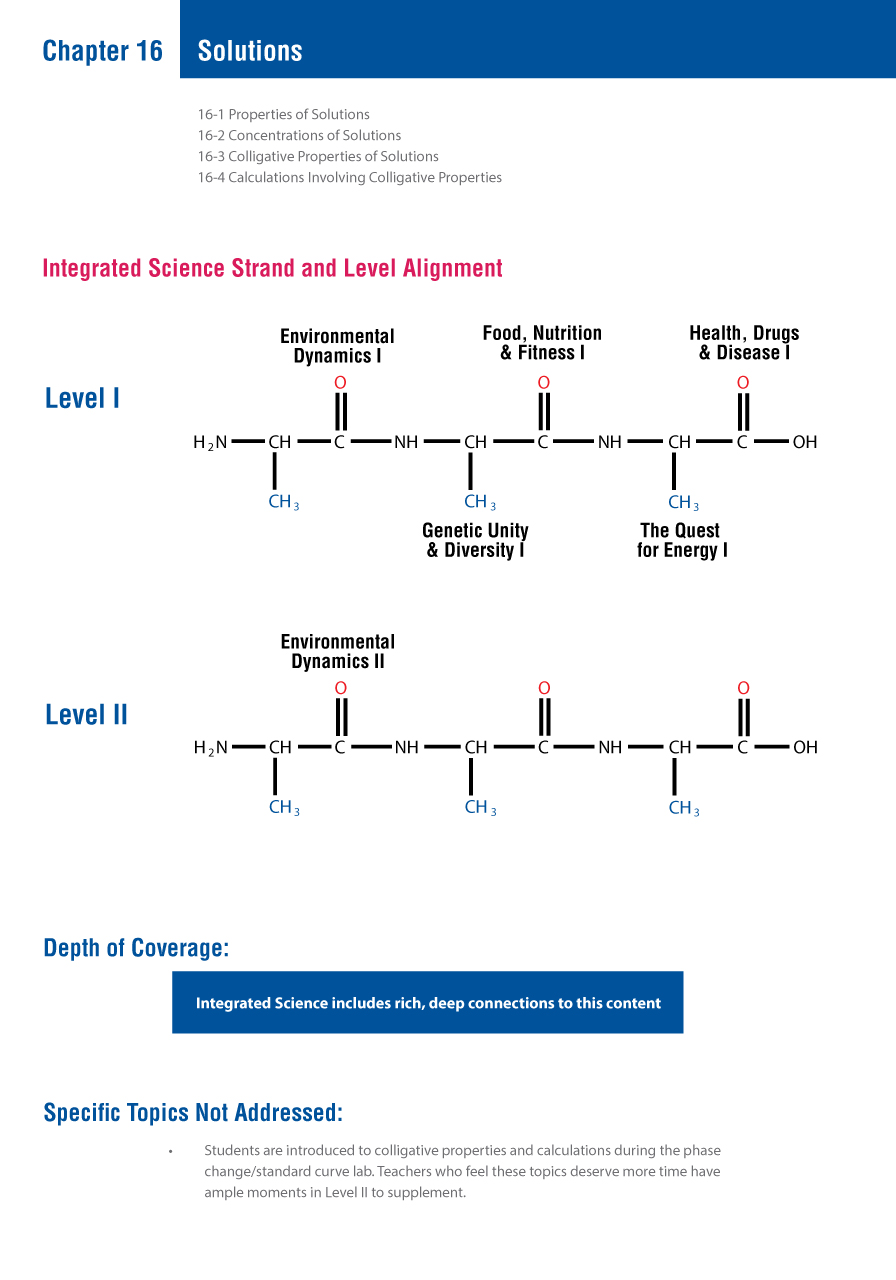
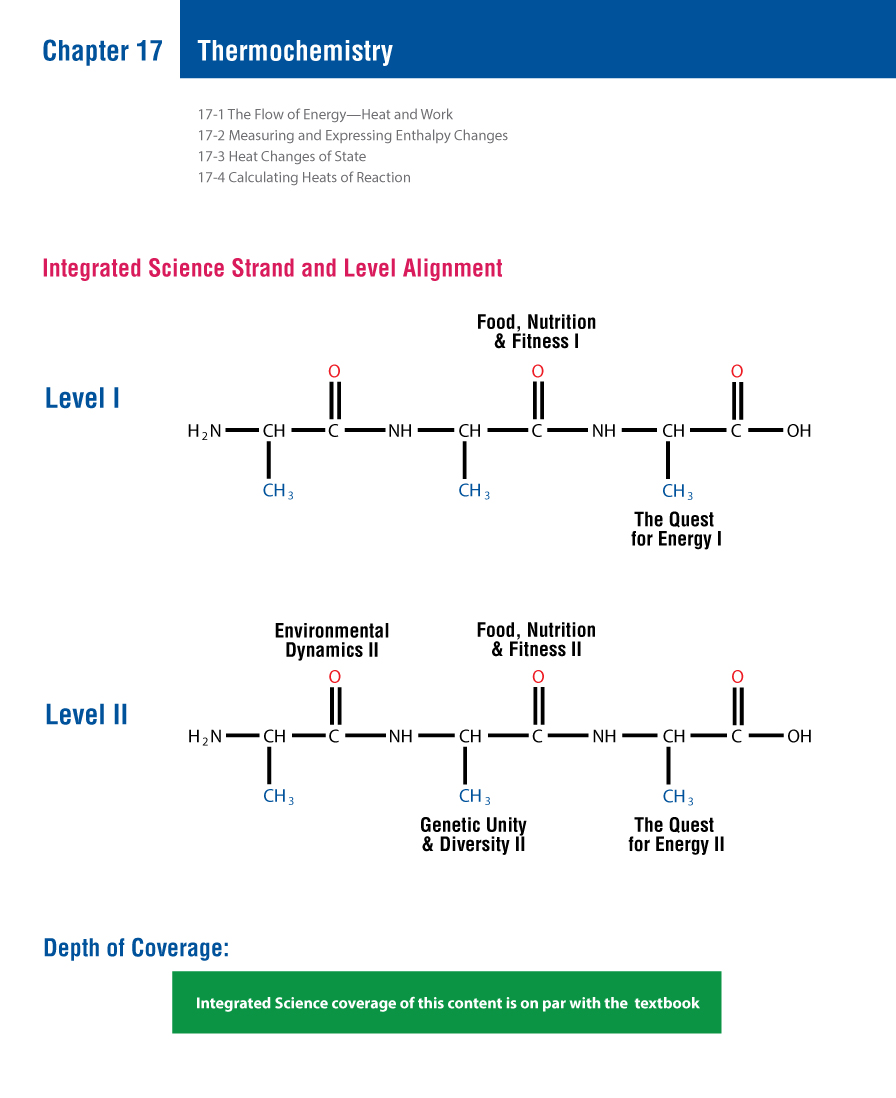
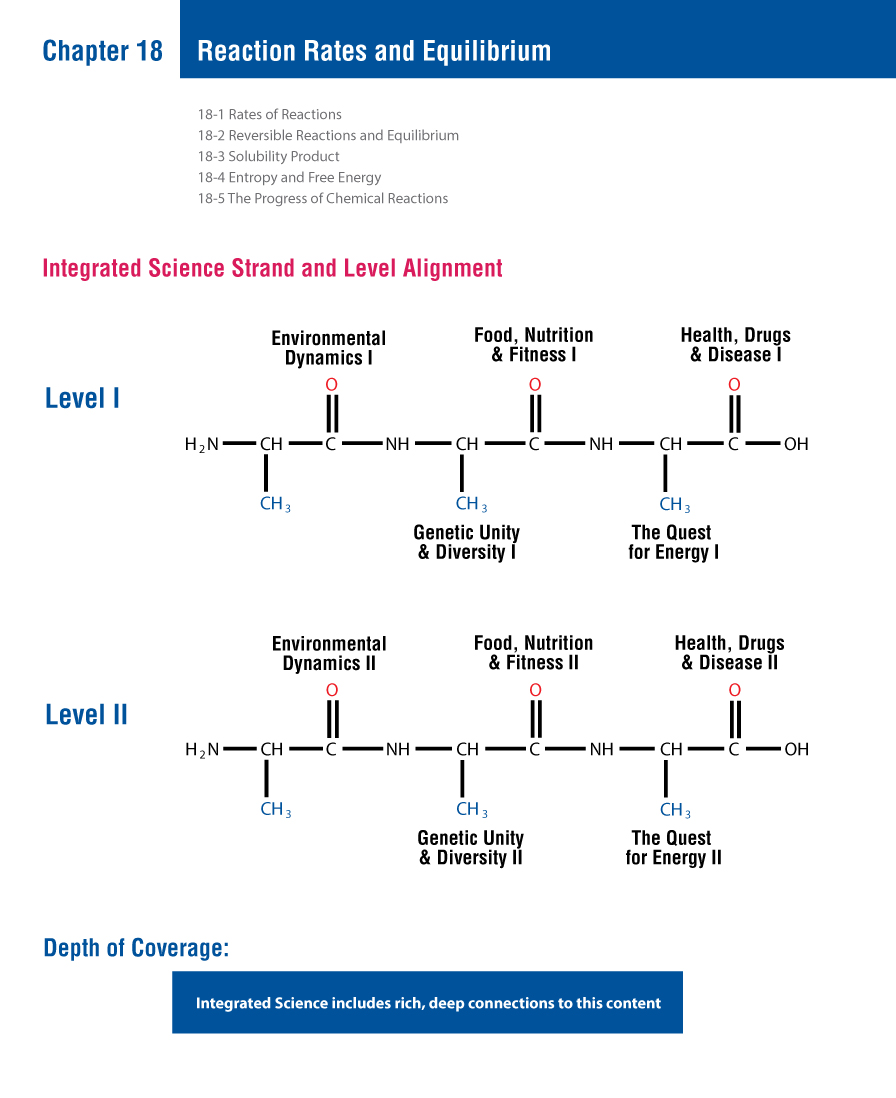
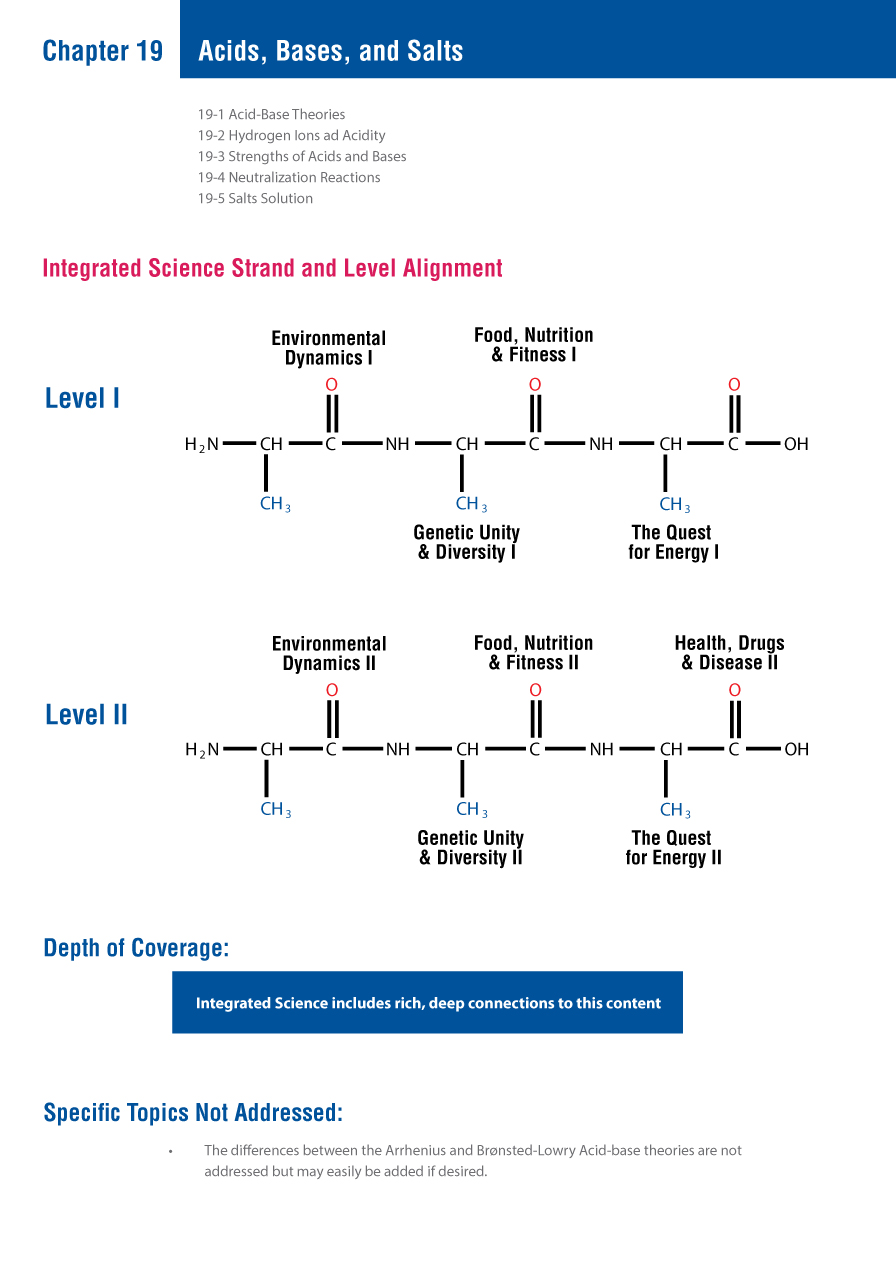
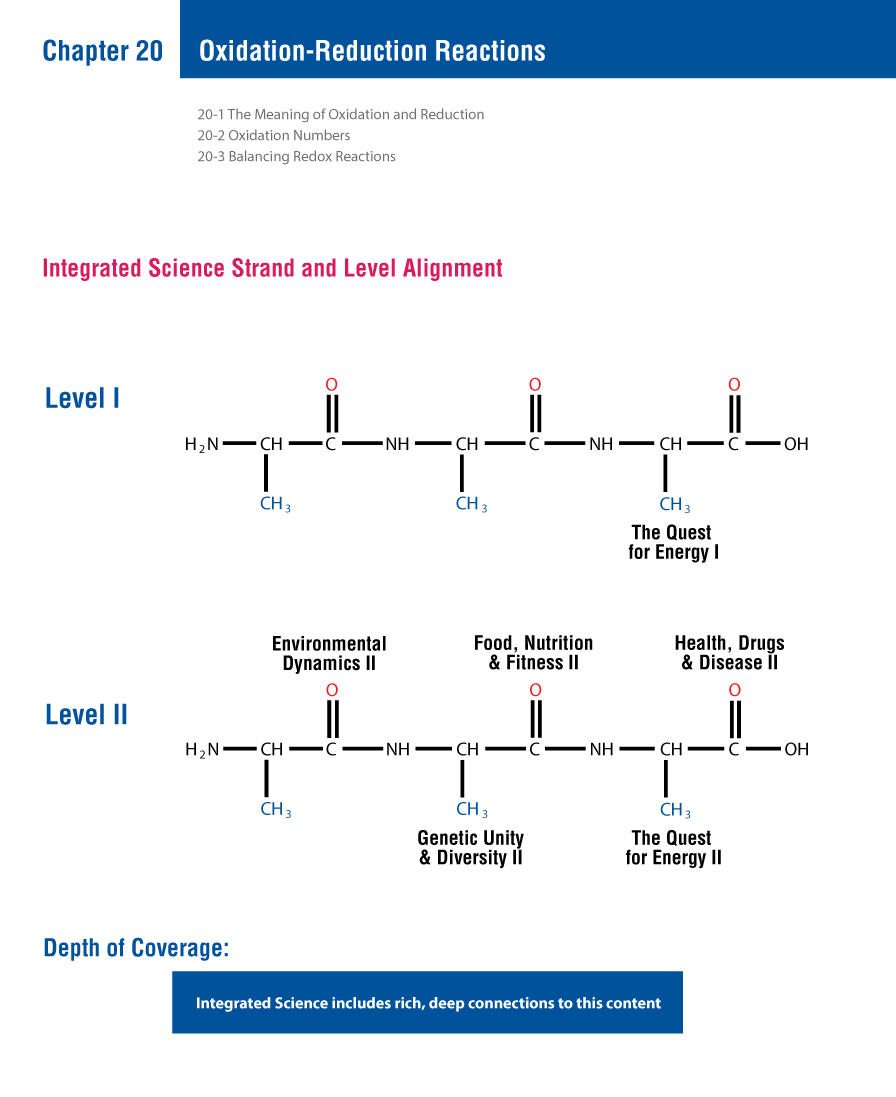
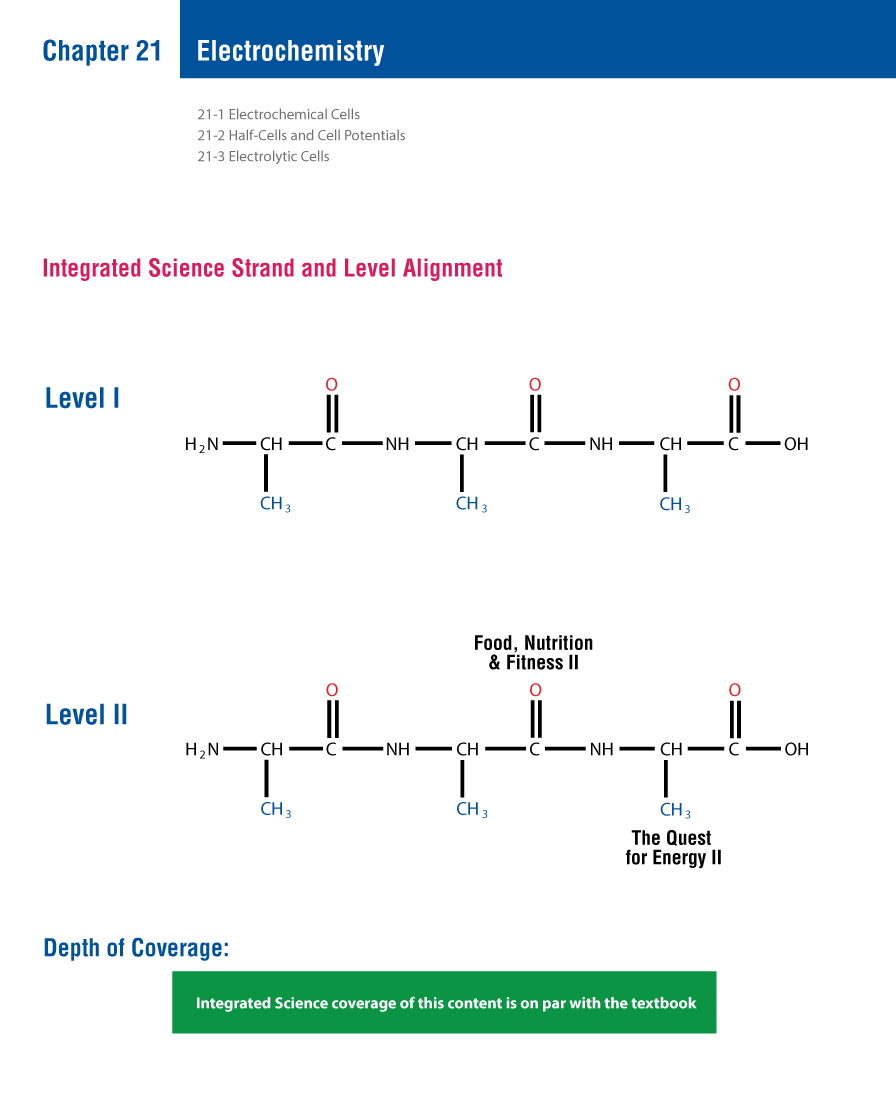
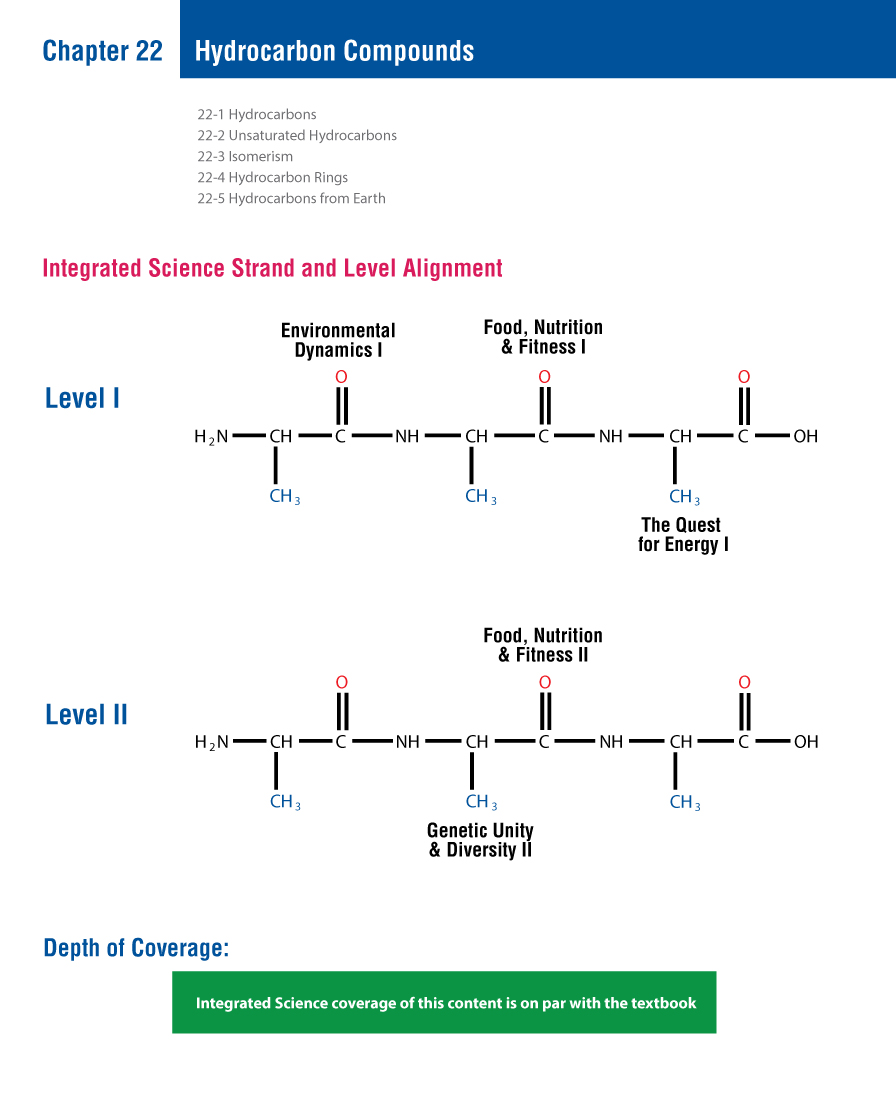
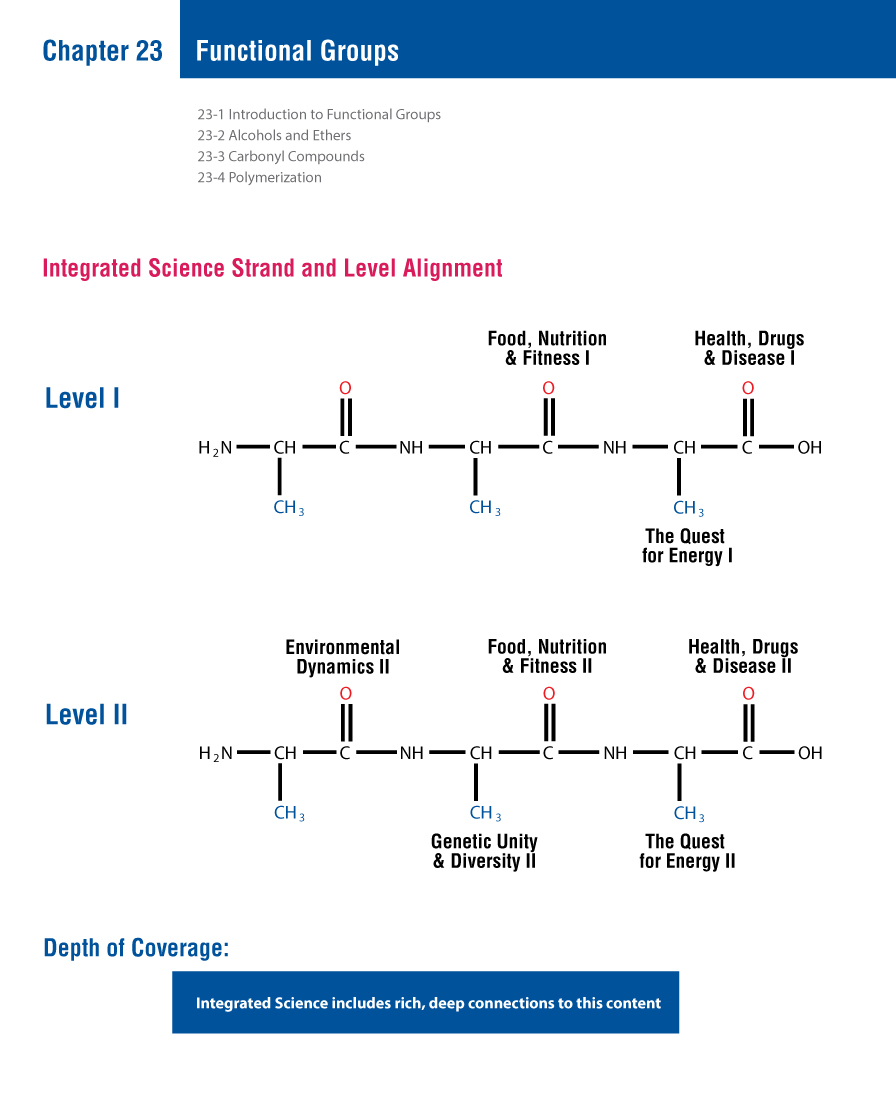
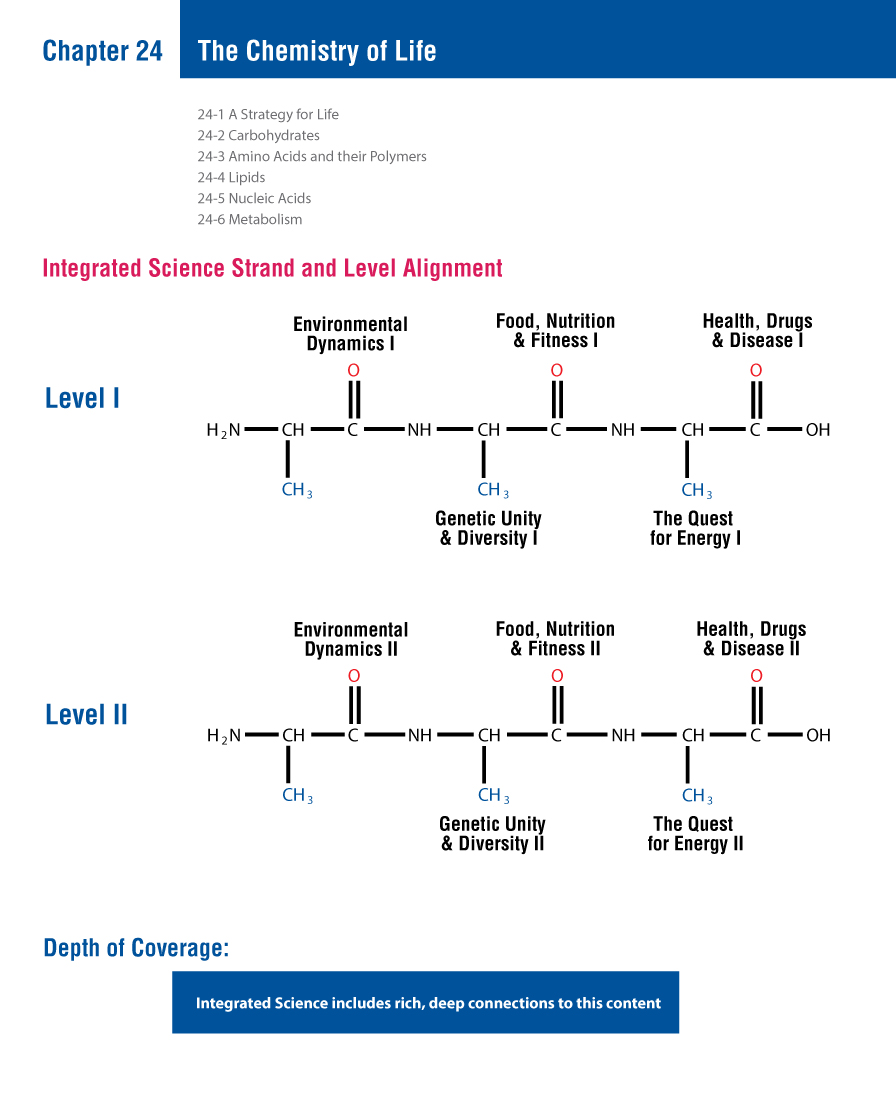

The following textbook alignment is based on Pearson Conceptual Physics, by Paul Hewitt.
The 3-year program progression of Integrated Science offers rich connections to conceptual physics that the 2-year programs do not have as much time to conquer. It covers more than one full semester of a traditional Conceptual Physics course. By “conceptual physics” we mean the early high school exploration of physical science concepts that do not require Algebra II or Trigonometry. This Conceptual Physics text is often used as a Physical Science or “Physics First” text.
NOTE: There is significant overlap with the Chemistry Textbook Alignment. We note that in the table below and direct you to that alignment.
To give a clear picture of the types of physics activities students conduct, only those Hewitt chapters associated with Level I & Level II Lab Experiences are listed. This is not a one-to-one correlation. We have grouped the experiences by unit, and each experience incorporates the relevant concepts and principles of the unit chapters listed. Through engineering design challenges, online interactives, phenom, and real-world case studies, students learn how the planet and its life “runs on physics.”
Textbook Unit | Textbook Chapters | Related Integrated Science I Units | Related Integrated Science II Units |
Unit 1: Mechanics | Chapter 1: About Science Chapter 2: Mechanical Equilibrium Chapter 3: Newton’s First Law of Motion—Inertia Chapter 4: Linear Motion Chapter 6: Newton’s Second Law of Motion—Force and Acceleration Chapter 7: Newton’s Third Law of Motion—Action and Reaction Chapter 8: Momentum | Genetic Unity & Diversity I: Flight Adaptations: Birds & Planes Food, Nutrition & Fitness I: The Jaw as Third-Class Lever Health, Drugs & Disease I: Reducing Teen Mortality Rates: Safe Vehicle Designs & Healthy Driving Behaviors | Environmental Dynamics II: Environmental Stewardship of Near-Earth Orbit Food, Nutrition & Fitness II: Weight Lifting The Quest for Energy II: Building a Bike-friendly City Health, Drugs & Disease II: Prosthetic Design Challenge |
Chapter 9: Energy | Energy concepts are *well-covered* in Integrated Science: please see Chemistry and Integrated Science alignment for specifics | ||
Chapters 11 & 12: Rotational Equilibrium Chapter 13: Universal Gravity Chapter 14: Satellite Motion | The Quest for Energy I: Society’s Fuels–Exploring Past and Future Quests (wind turbines) | Environmental Dynamics II: Environmental Stewardship of Near-Earth Orbit | |
Unit 2: Properties of Matter | Chapter 17: The Atomic Nature of Matter | Properties of Matter concepts are *well-covered* in Integrated Science: please see Chemistry and Integrated Science alignment for specifics | |
Chapter 18: Solids
Chapter 19: Liquids
Chapter 20: Gases | Environmental Dynamics I: All Case Studies Genetic Unity & Diversity: DNA–Molecular Blueprint for Life The Quest for Energy I: A Water Molecule’s Quest for Energy–and Life The Quest for Energy I: An Atom’s Quest for Energy | Environmental Dynamics II: AIR All Around Environmental Dynamics II: SOIL That Sustains Us Environmental Dynamics II: OCEAN, Giver of Life | |
Unit 3: Heat | Chapter 21: Temperature, Heat, and Expansion Chapter 22: Heat Transfer Chapter 23: Change of Phase | Food, Nutrition & Fitness I: Food as Fuel The Quest for Energy I: Society’s Fuels–Exploring Past and Future Quests The Quest for Energy I: A Water Molecule’s Quest for Energy–and Life (solar panel design challenges) | Environmental Dynamics II: AIR All Around Environmental Dynamics II: SOIL That Sustains Us Environmental Dynamics II: OCEAN, Giver of Life Environmental Dynamics II: Environmental Stewardship of Near-Earth Orbit |
| Chapter 24: Thermodynamics | Thermodynamics are *well-covered* in Integrated Science: please see Chemistry and Integrated Science alignment for specifics | ||
Unit 4: Sound and Light | Chapter 25: Vibrations and Waves Chapter 27: Light Chapter 28: Color Chapter 30: Lenses Chapter 31: Sound Chapter 32: Diffraction & Interference | Genetic Unity & Diversity I: Lenses & Ray Diagrams with the Compound Light Microscope; Electron Microscopes Food, Nutrition & Fitness I: Wave Properties & Relationships; DIY Wave Machine, Sound & Light Waves, Peristaltic Waves, Endoscopy and Fiber Optics The Quest for Energy I: Photosynthetic Pigments & Chromatography; Human pigments, absorption spectra, sunscreen ingredients, and skin color; EM spectrum; Spectroscopy; Prisms, Photovoltaic Cells; Blackbody emission spectra, Stars (astronomy) | Environmental Dynamics II: OCEAN, Giver of Life (sonar & bathymetry)
|
Unit 5: Electricity & Magnetism | Chapter 33: Electric Fields and Potential Chapter 34: Electric Current Chapter 35: Electric Circuits Chapter 36: Magnetism Chapter 37: Electromagnetic Induction | Environmental Dynamics I: Dynamic Cycles of Water Pollution, Monitoring & Treatment (Magnetism and wastewater treatment) Environmental Dynamics I: Big Water, Big Power, Big Problems: Hydropower in the 21st Century (electricity generation) Genetic Unity & Diversity I: Unity & Diversity in Multicellular Organisms (electromagnets & the electron microscope) Food, Nutrition & Fitness I: Digestion in the Mouth & Stomach The Quest for Energy I: Society’s Fuels–Exploring Past and Future Quests (wind turbines, solar panel efficiency, solar cars) The Quest for Energy I: A Cell’s Quest for Energy The Quest for Energy I: An Atom’s Quest for Energy | Environmental Dynamics II: Environmental Stewardship of Near-Earth Orbit Genetic Unity & Diversity II: Biotechnology Applications Food, Nutrition & Fitness II: Water & Wellness–The Body’s Electrochemical Circuits Food, Nutrition & Fitness II: Bones, Blood & Muscles–Strength and Flexibility |
Unit 6: Atomic & Nuclear Physics | Chapter 38: The Atom and the Quantum Chapter 39: The Atomic Nucleus and Radioactivity Chapter 40: Nuclear Fission and Fusion | Environmental Dynamics I: Fukushima 3/11, Fukushima 2023 The Quest for Energy I: A Cell’s Quest for Energy (nuclear reactions vs. chemical reactions, stars & planets) The Quest for Energy I: An Atom’s Quest for Energy | Environmental Dynamics II: Environmental Stewardship of Near-Earth Orbit
The Quest for Energy II: Argumentation: The Case For/Against Continued Use of Nuclear Energy |
The following alignment is based on Living in the Environment, 20th Edition (2019) a popular text for high school Environmental Science classrooms.
Chapter 1: The Environment and Sustainability
Chapter 2: Science, Matter, Energy, and Systems
Chapter 3: Ecosystems: What Are They and How Do They Work?
Chapter 4: Biodiversity and Evolution
Chapter 5: Species Interactions, Ecological Succession, and Population Control
Chapter 6: The Human Population
Chapter 7: Climate and Terrestrial Biodiversity
Chapter 8: Aquatic Biodiversity
Chapter 9: Sustaining Biodiversity: Saving Species and Ecosystem Services
Chapter 10: Sustaining Biodiversity: Saving Ecosystems and Ecosystem Services
Chapter 11: Sustaining Aquatic Biodiversity and Ecosystem Services
Chapter 12: Food Production and the Environment
Chapter 14: Geology and Mineral Resources
Chapter 15: Nonrenewable Energy
Chapter 16: Energy Efficiency and Renewable Energy
Chapter 17: Environmental Hazards and Human Health
Chapter 18: Air Pollution and Ozone Depletion
Chapter 21: Solid and Hazardous Waste
Chapter 22: Urbanization and Sustainability
Chapter 23: Economics, Environment, and Sustainability
Chapter 24: Politics, Environment, and Sustainability
Chapter 25: Environmental Worldviews, Ethics, and Sustainability

